LG Electronics USA V155MHA Microwave Oven User Manual 9591 9592 EngRev AMV5164
LG Electronics USA Microwave Oven 9591 9592 EngRev AMV5164
Contents
- 1. Users Manual 1
- 2. Users Manual 2
- 3. Users Manual
Users Manual 1
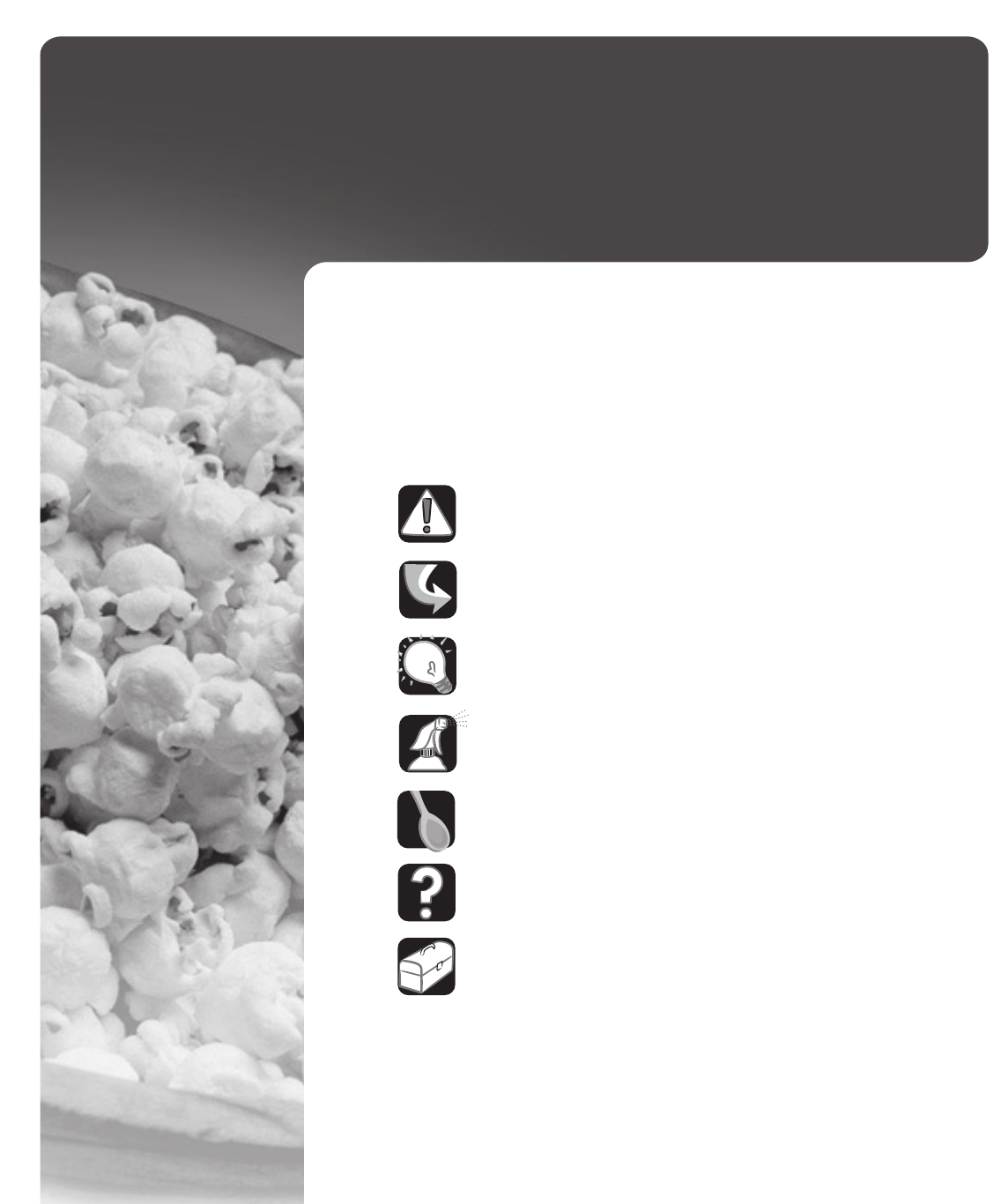
Keep instructions for future reference.
Be sure Use & Care Guide stays with oven.
Form No. A/04/04 ©2004 Maytag Appliances 3828W5A4186 Part No. 8112P262-60
Use & Care Guide
Model AMV5164AA/AC
Important Safety Instructions.................. 2-4
Features........................................................ 5-6
Operating Instructions ............................ 7-20
Care and Cleaning................................. 21-22
Cooking Utensils.......................................... 23
Troubleshooting ..................................... 24-25
Warranty......................................................... 26
Guide d’utilisation et d’entretien .............. 27
Guía de Uso y Cuidado ................................53
Over The Range
Microwave Oven
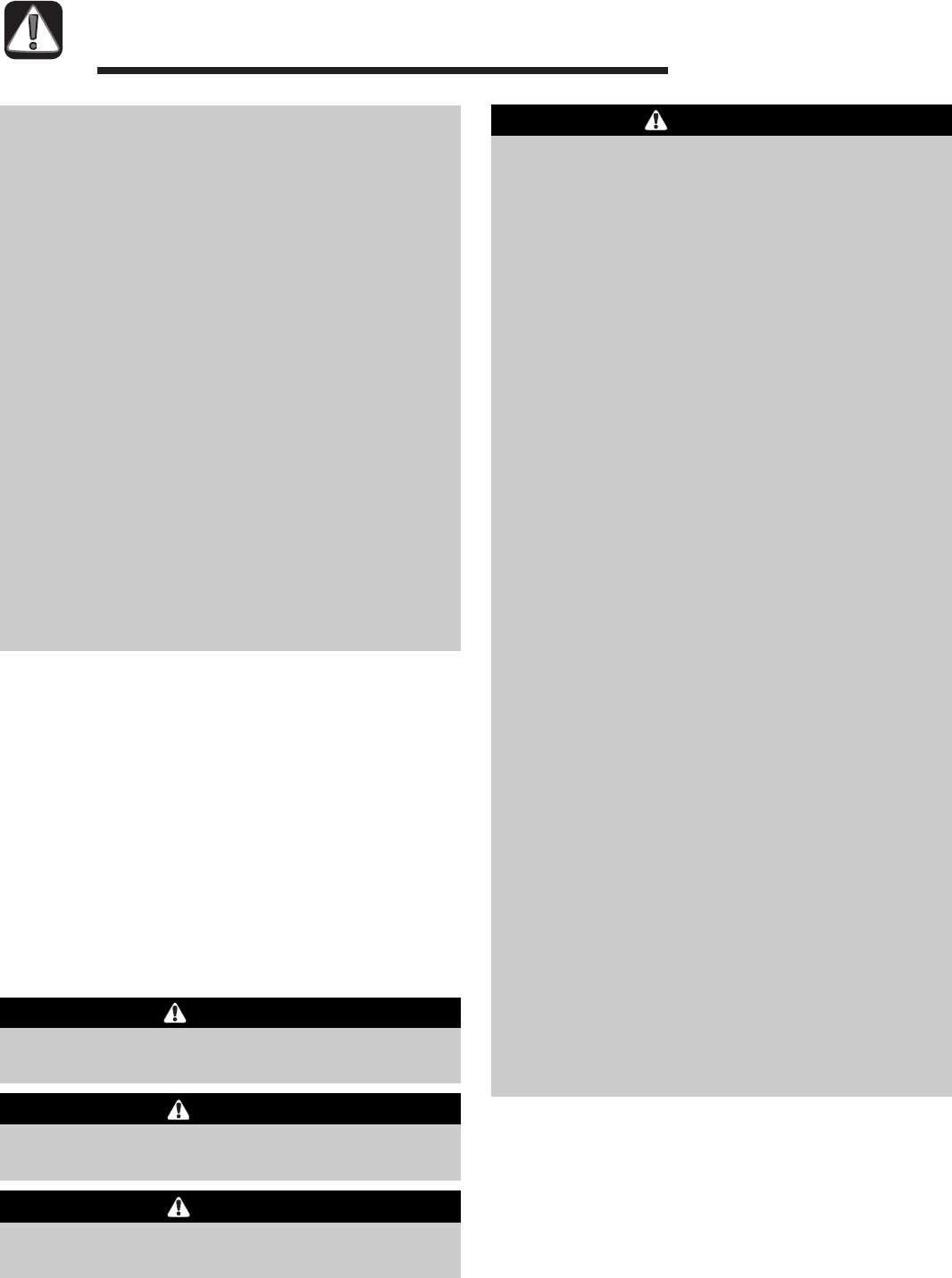
2
Important Safety Instructions
Installer: Please leave this guide with this appliance.
Consumer: Please read and keep this Use & Care
Guide for future reference.
Keep sales receipt and/or cancelled check as proof of
purchase.
Model Number ________________________________
Serial Number_________________________________
Date of Purchase ______________________________
In our continuing effort to improve the quality and
performance of our appliances, it may be necessary to
make changes to the appliance without revising this
guide.
If you have questions, write us (include your model
number and phone number) or call:
Maytag ServicesSM
Attn: CAIR®Center
P.O. Box 2370
Cleveland, TN 37320-2370
1-800-843-0304 U.S.A
1-866-587-2002 Canada
1-800-688-2080 (US TTY for hearing or speech
impaired)
(Mon.-Fri., 8 a.m.-8 p.m. Eastern Time)
Internet: http://www.amana.com
What You Need to Know About
Safety Instructions
Warning and Important Safety Instructions appearing in this
Use & Care Guide are not meant to cover all possible
conditions and situations that may occur. Common sense,
caution, and care must be exercised when installing,
maintaining, or operating microwave.
Always contact your dealer, distributor, service agent, or
manufacturer about problems or conditions you do not
understand.
Recognize Safety Symbols, Words,
Labels
DANGER
DANGER – Immediate hazards which WILL result in
severe personal injury or death.
WARNING
WARNING – Hazards or unsafe practices which COULD
result in severe personal injury or death.
CAUTION
CAUTION – Hazards or unsafe practices which COULD
result in minor personal injury.
To avoid personal injury or property damage, observe the
following:
1. Do not deep fat fry in oven. Fat could overheat and be
hazardous to handle.
2. Do not cook or reheat eggs in shell or with an
unbroken yolk using microwave energy. Pressure
may build up and erupt. Pierce yolk with fork or knife
before cooking.
3. Pierce skin of potatoes, tomatoes, and similar foods
before cooking with microwave energy. When skin is
pierced, steam escapes evenly.
4. Do not operate oven without load or food in oven
cavity.
5. Use only popcorn in packages designed and labeled
for microwave use. Popping time varies depending on
oven wattage. Do not continue to heat after popping
has stopped. Popcorn will scorch or burn. Do not
leave oven unattended.
6. Do not use regular cooking thermometers in oven.
Most cooking thermometers contain mercury and may
cause an electrical arc, malfunction, or damage to
oven.
7. Do not use metal utensils in oven.
8. Never use paper, plastic, or other combustible
materials that are not intended for cooking.
9. When cooking with paper, plastic, or other com-
bustible materials, follow manufacturer's recom-
mendations on product use.
10. Do not use paper towels which contain nylon or other
synthetic fibers. Heated synthetics could melt and
cause paper to ignite.
11. Do not heat sealed containers or plastic bags in oven.
Food or liquid could expand quickly and cause
container or bag to break. Pierce or open container or
bag before cooking.
12. To avoid pacemaker malfunction, consult physician or
pacemaker manufacturer about effects of microwave
energy on pacemaker.
CAUTION
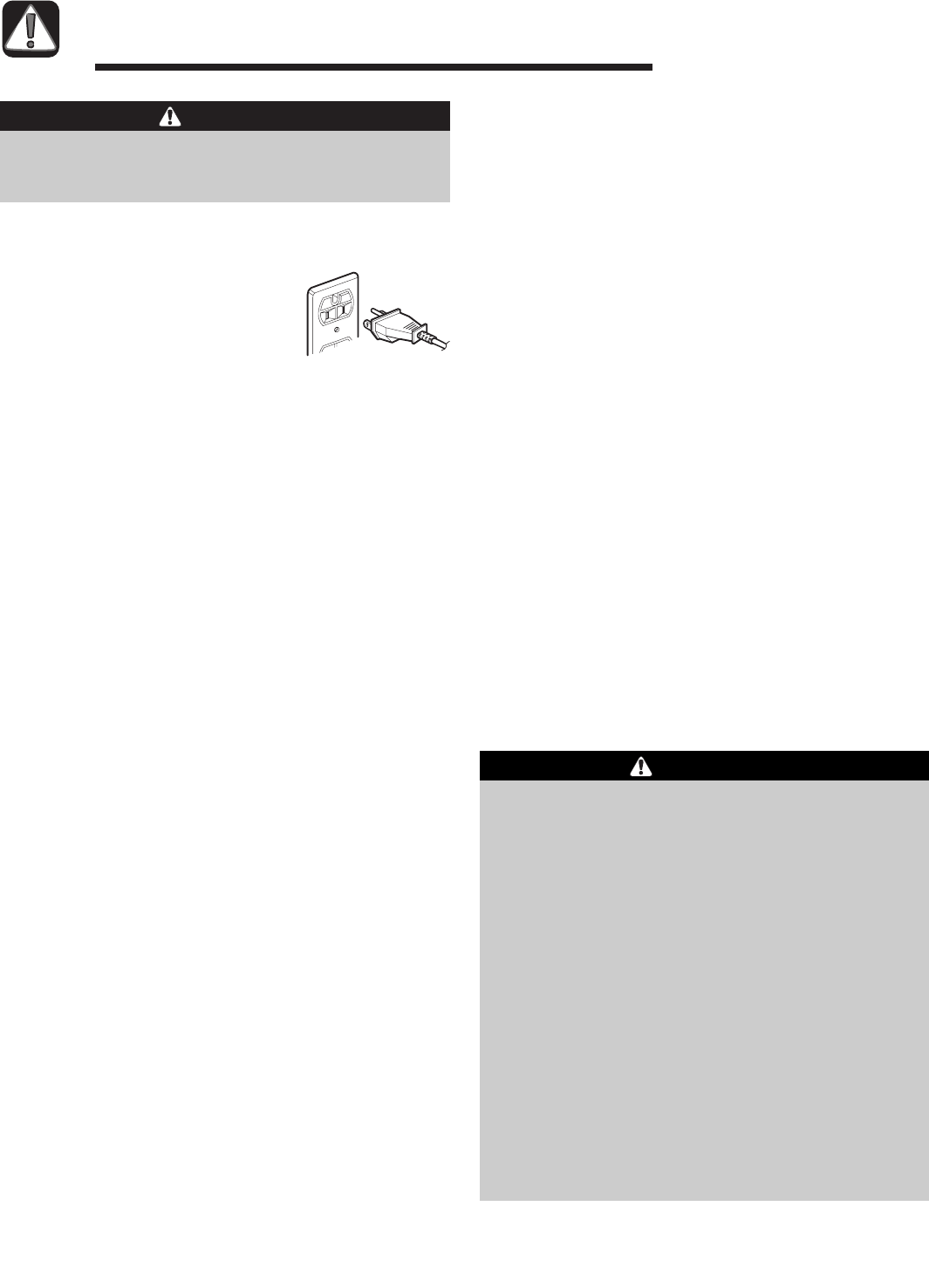
3
Important Safety Instructions
WARNING
To avoid risk of electrical shock or death, this oven
must be grounded and plug must not be altered.
WARNING
Liquids such as water, coffee, or tea are able to be
overheated beyond the boiling point without appearing to
be boiling due to surface tension of the liquid. Visible
bubbling or boiling when the container is removed from
the microwave oven is not always present. THIS COULD
RESULT IN VERY HOT LIQUIDS SUDDENLY BOILING
OVER WHEN A SPOON OR OTHER UTENSIL IS
INSERTED INTO THE LIQUID. To reduce the risk of
injury to persons:
1. Do not overheat the liquid.
2. Stir the liquid both before and halfway through heating
it.
3. Do not use straight-sided containers with narrow
necks.
4. After heating, allow the container to stand in the
microwave oven for a short time before removing the
container.
5. Use extreme care when inserting a spoon or other
utensil into the container.
●Move the microwave oven away from the receiver.
●Plug the microwave oven into a different outlet so that
the microwave oven and the receiver are on different
branch circuits.
The manufacturer is not responsible for any radio or
television interference caused by unauthorized
modification to this microwave oven. It is the
responsibility of the user to correct such interference.
Precautions to Avoid Possible
Exposure to Excessive
Microwave Energy
A. DO NOT attempt to operate this oven with the door open
since open door operation can result in harmful exposure
to microwave energy. It is important not to defeat or
tamper with the safety interlocks.
B. DO NOT place any object between the oven front face
and the door to allow soil or cleaner residue to
accumulate on sealing surfaces.
C. DO NOT operate the oven if it is damaged. It is
particularly important that oven door close properly and
that there is no damage to:
1. door (bent),
2. hinges and latches (broken or loosened),
3. door seals and sealing surfaces.
D. Oven should not be adjusted or repaired by anyone
except properly qualified service personnel.
Grounding Instructions
Oven MUST be grounded. Grounding
reduces risk of electric shock by
providing an escape wire for the
electric current if an electrical short
occurs. This oven is equipped with a
cord having a grounding wire with a grounding plug. The
plug must be plugged into an outlet that is properly
installed and grounded. See Installation Instructions.
Consult a qualified electrician or servicer if grounding
instructions are not completely understood, or if doubt
exists as to whether the oven is properly grounded.
Do not use an extension cord. If the product power
cord is too short, have a qualified electrician install a
three-slot receptacle. This oven should be plugged into a
separate 60 hertz circuit with the electrical rating as
shown in specifications table. When the oven is on a
circuit with other equipment, an increase in cooking
times may be required and fuses can be blown.
Microwave operates on standard household current,
110-120V.
Federal Communications
Commission Radio Frequency
Interference Statement
(U.S.A. Only)
This equipment generates and uses ISM frequency energy
and if not installed and used properly, that is in strict
accordance with the manufacturer's instructions, may
cause interference to radio and television reception. It has
been type tested and found to comply with limits for ISM
Equipment pursuant to part 18 of FCC Rules, which are
designed to provide reasonable protection against such
interference in a residential installation.
However, there is no guarantee that interference will not
occur in a particular installation. If this equipment does
cause interference to radio or television reception, which
can be determined by turning the equipment off and on,
the user is encouraged to try to correct the interference by
one or more of the following:
●
Reorient the receiving antenna of the radio or television.
●Relocate the microwave oven with respect to the
receiver.
SAVE THESE INSTRUCTIONS

4
Important Safety Instructions
WARNING
When using electrical appliances, basic safety
precautions should be followed to reduce the risk of
burns, electric shock, fire, or injury to persons or
exposure to excessive microwave energy.
1. READ all instructions before using oven.
2. READ AND FOLLOW the specific
“PRECAUTIONS TO AVOID POSSIBLE
EXPOSURE TO EXCESSIVE MICROWAVE
ENERGY” on page 3.
3. Install or locate this oven ONLY in accordance
with the installation instructions in this manual.
4. Some products such as whole eggs and sealed
containers—for example, closed glass jars—are
able to explode and SHOULD NOT be HEATED
in this oven.
5. Use this oven ONLY for its intended use as
described in this manual. Do not use corrosive
chemicals or vapors in this oven. This type of
oven is specifically designed to heat, cook, or
dry food. It is not designed for industrial or
laboratory use.
6. As with any appliance, CLOSE SUPERVISION
is necessary when used by CHILDREN or
INFIRM PERSONS.
7. See door cleaning instructions in the Care and
Cleaning section.
8. Baby food jars shall be open when heated and
contents stirred or shaken before consumption,
in order to avoid burns.
9. DO NOT use this oven for commercial
purposes. It is made for household use only.
10. DO NOT heat baby bottles in oven.
11. DO NOT operate this oven if it has a damaged
cord or plug, if it is not working properly, or if it
has been damaged or dropped.
12. This oven, including power cord, must be
serviced ONLY by qualified service personnel.
Special tools are required to service oven.
Contact nearest authorized service facility for
examination, repair, or adjustment.
13. DO NOT cover or block filter or other openings
on oven.
14. DO NOT store this oven outdoors. DO NOT use
this product near water – for example, near a
kitchen sink, in a wet basement, near a
swimming pool or similar locations.
15. DO NOT immerse cord or plug in water.
16. Keep cord AWAY from HEATED surfaces.
17. DO NOT let cord hang over edge of table or
counter.
18. Clean the ventilating hood frequently.
19. DO NOT allow grease to accumulate on the
hood or filters.
20. Use care when cleaning the ventilating hood fil-
ters. Corrosive cleaning agents such as lye-
based oven cleaners may damage the filters.
21. When flaming foods under the hood, turn the fan
on.
22. Suitable for use above both gas and electric
cooking equipment 36 inches or less wide.
CAUTION
To avoid risk of fire in the oven cavity:
a. DO NOT overcook food. Carefully attend oven when
paper, plastic, or other combustible materials are
placed inside the oven to facilitate cooking.
b. Remove wire twist-ties from paper or plastic bags
before placing bag in oven.
c. If materials inside the oven ignite, keep oven door
CLOSED, turn oven off and disconnect the power cord,
or shut off power at the fuse or circuit breaker panel.
d. DO NOT use the cavity for storage. DO NOT leave
paper products, cooking utensils, or food in the cavity
when not in use.
SAVE THESE INSTRUCTIONS
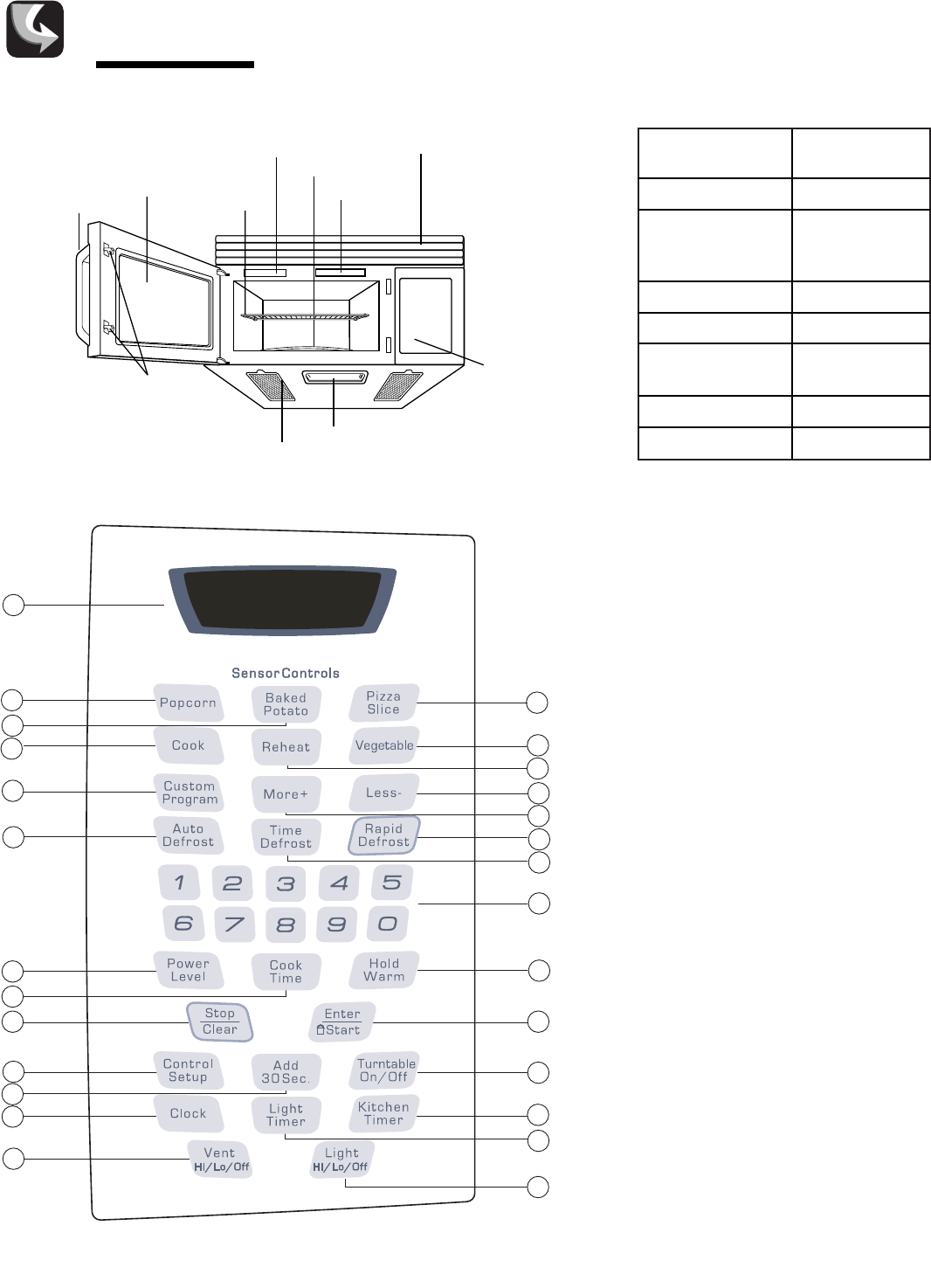
1
11
3
5
4
8
2
15
26
23
24
20
18
17
16
19
21
25
27
22
10
13
6
12
14
7
9
OVEN SPECIFICATIONS
Power Supply
Input Power
Cooking Power
Frequency
Rated Current
Outer Dimensions
(WxHxD)
Cavity Volume
Net Weight
120 VAC,
60 Hz
1,500 W
1,000 W
(IEC 60705
Standard)
2,450 MHz
13 A
29115/16" x 167/6"
x 153/8"
1.6 Cu. Ft.
52 lbs.
5
Features
FEATURES
1. DISPLAY: The Display includes
a clock and indicators to tell you time
of day, cooking time settings and
cooking functions selected.
2. POPCORN: Touch this pad when
popping popcorn in your microwave
oven. The oven’s sensor will tell the
oven how long to cook depending on
the amount of humidity it detects
from the popcorn. See page 11 for
more information.
3. BAKED POTATO: Touch this pad to
cook potatoes. The oven’s sensor will
tell the oven how long to cook
depending on the amount of humidity
it detects from the potato. See page 12
for more information.
4. REHEAT: Touch this pad to reheat
casserole, dinner plate, and
soup/sauce. The oven’s sensor will
tell the oven how long to cook
depending on the amount of humidity
coming from the food. See page 12
for more information.
Door Handle
Model and Serial
Number Plate
Metal Rack
Window with
Metal Shield
Glass Turntable
Cooking Guide
Vent Grille
Oven Control
Panel
Cooktop/Countertop Light
Grease Filter
Door Safety
Lock System

6
Features
5. COOK: Touch this pad to cook frozen
entree, casserole, and rice. The oven’s
sensor will tell the oven how long to
cook depending on the amount of
humidity coming from the food. See
page 12 for more information.
6. VEGETABLE: Touch this pad to cook
vegetables. The oven’s sensor will tell
the oven how long to cook depending
on the amount of humidity it detects
from the vegetables. See page 12 for
more information.
7.
PIZZA SLICE: Touch this pad to
reheat pizza. The oven’s sensor will
tell the oven how long to cook
depending on the amount of humidity
it detects. See page 11 for more
information.
8.
CUSTOM PROGRAM: Touch this
pad to recall one cooking instruction
previously programmed into memory.
See page 9 for more information.
9.
MORE+: Touch this pad to add ten
seconds of cooking time each time
you press it. See page 9 for more
information.
10.
LESS-: Touch this pad to subtract
ten seconds of cooking time each
time you press it. See page 9 for
more information.
11. AUTO DEFROST: Meat, poultry, fish.
Touch this pad to select food type and
defrost food by weight. See page 14
for more information.
12. TIME DEFROST: Touch this pad to
defrost most other frozen foods. See
page 15 for more information.
13. RAPID DEFROST: This pad provides
RAPID defrost for 1.0 pound of frozen
food. See page 15 for more
informa-
tion.
14. NUMBER: Touch number pads to
enter cooking time, power level,
quantities, or weights.
15. POWER LEVEL: Touch this pad to
select a cooking power level.
16. COOK TIME: Touch this pad to set a
cooking time. See page 9 for more
information.
17. HOLD WARM: Touch this pad to
keep hot, cooked foods warm in your
microwave oven for up to 99 minutes
99 seconds. See page 8 for more
information.
18. STOP/CLEAR: Touch this pad to
stop the oven or to clear all entries.
19. ENTER/START: Touch this pad to
start a function. If you open the door
after oven begins to cook, touch
ENTER/START again.
20. CONTROL SETUP: Touch this pad
to change the oven’s default settings
for sound, clock, display speed and
defrost weight. See page 7 for more
information.
21. ADD 30 SEC: Touch this pad to set
and start quickly at 100% power level.
See page 8 for more information.
22. TURNTABLE ON/OFF: Touch this
pad to turn off the turntable. OFF will
appear in the display. See page 7 for
more information.
23. CLOCK: Touch this pad to enter the
time of day. See page 7 for more
information.
24. LIGHT TIMER: Touch this pad to set
the light timer. See page 8 for more
information.
25. KITCHEN TIMER: Touch this pad to
set the kitchen timer. See page 7 for
more information.
26. VENT HI/LO/OFF: Touch this pad to
turn the fan on or off. See page 7 for
more information.
27. LIGHT HI/LO/OFF: Touch this pad to
turn on the cooktop/countertop light.
See page 8 for more information.
NOTE:
●
This option is not available in
sensor cook and defrost modes.
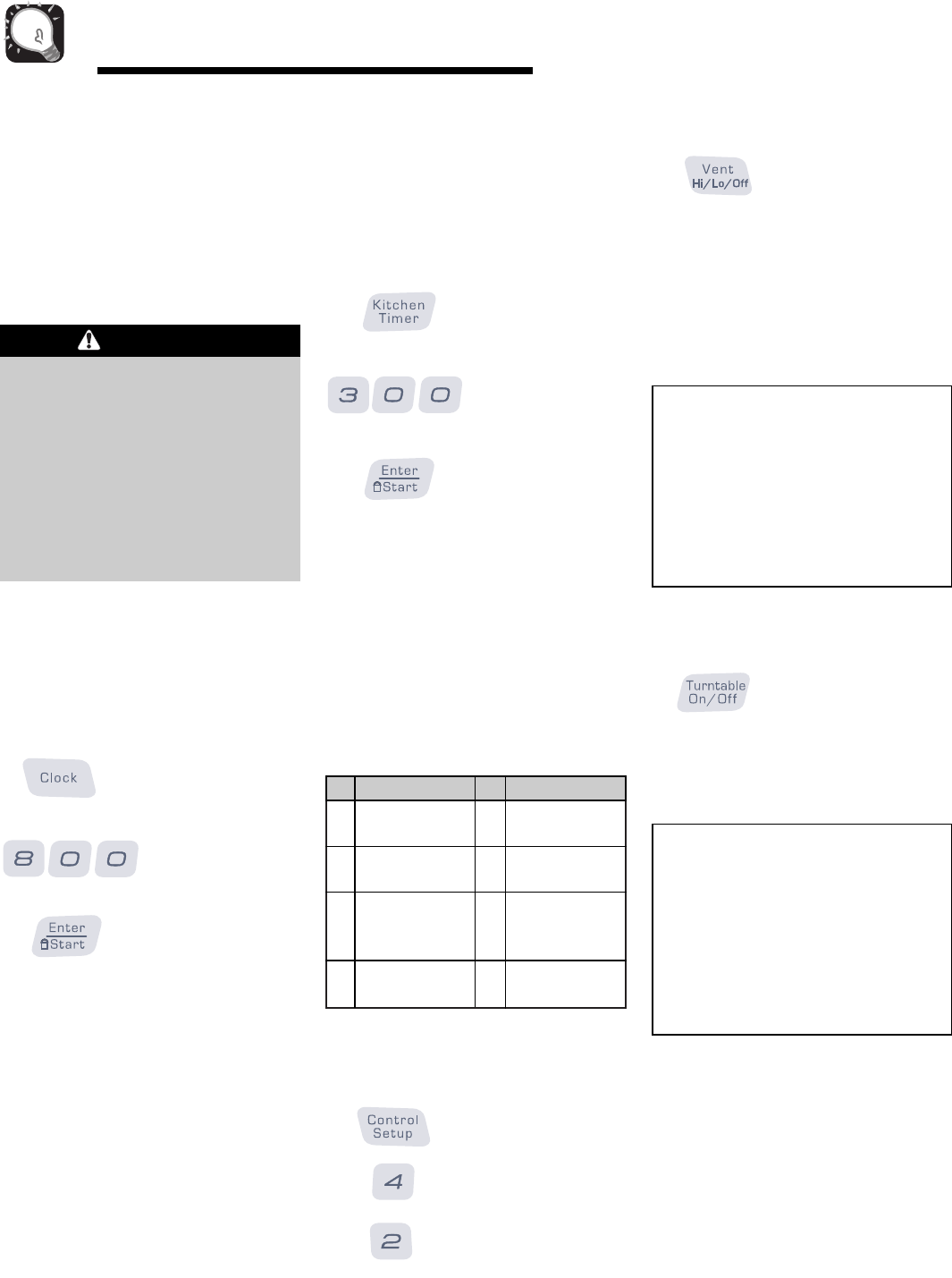
KITCHEN TIMER
You can use your microwave oven
as a timer. Use the Timer for timing
up to 99 minutes, 99 seconds.
Example: To set for 3 minutes.
1. Touch
KITCHEN
TIMER pad.
2. Enter the time
by using the
number key
pad.
3. Touch ENTER/
START pad.
When the time
is over, you will
hear beeps and
END will
display.
CONTROL SETUP
You can change the default values
for beep sound, clock, display speed
and defrost weight.
See following chart for more information.
Example: To change defrost
weight mode (from Lbs. to Kg).
1. Touch
CONTROL
SETUP pad.
2. Touch number 4
pad.
3. Touch number 2
pad.
LEARN ABOUT YOUR
MICROWAVE OVEN
This section discusses the concepts
behind microwave cooking and
introduces you to the basics you
need to know to operate your
microwave oven. Please read this
information before use.
CLOCK
This oven includes a 12-hour clock.
Example: To set 8:00 AM.
1. Touch CLOCK
pad.(Press once
for AM, twice for
PM)
2. Enter the time
by using the
number key
pad.
3. Touch ENTER/
START pad.
VENT HI/LO/OFF
The VENT moves
steam and other
vapors from the
cooking surface. The vent will
operate at low speed whenever the
oven is on.
To operate the vent manually: Touch
VENT once for High fan speed, twice
for Low fan speed, or three times to
turn the fan off.
TURNTABLE ON/OFF
For best cooking
results, leave the
turntable on. It can
be turned off for large dishes.
Press TURNTABLE ON/OFF to turn
the turntable on or off.
No. Function
1 Beep ON/ 1 Sound ON
OFF control 2 Sound OFF
2 Clock display 1 Clock ON
control 2 Clock OFF
3 Display 1 Slow speed
2 Normal speed
3 Fast speed
4 Defrost weight 1 Lbs.
mode selected 2 Kg.
No. Result
7
Operating Instructions
NOTES:
●This option is not available in sen-
sor cook and defrost modes.
●Sometimes the turntable can
become hot to touch. Be careful
touching the turntable during and
after cooking.
●Do not run the oven empty.
NOTE:
●If the temperature gets too hot
around the microwave oven, the
fan
in the vent hood will automatically
turn on at the HIGH setting to cool
the oven. It may stay on up to an
hour. When this occurs, the vent
cannot be turned off.
●To avoid risk of personal
injury or property damage,
do not run oven empty.
●To avoid risk of personal
injury or property damage,
do not use stoneware,
aluminum foil, metal utensils,
or metal trimmed utensils in
the oven.
CAUTION
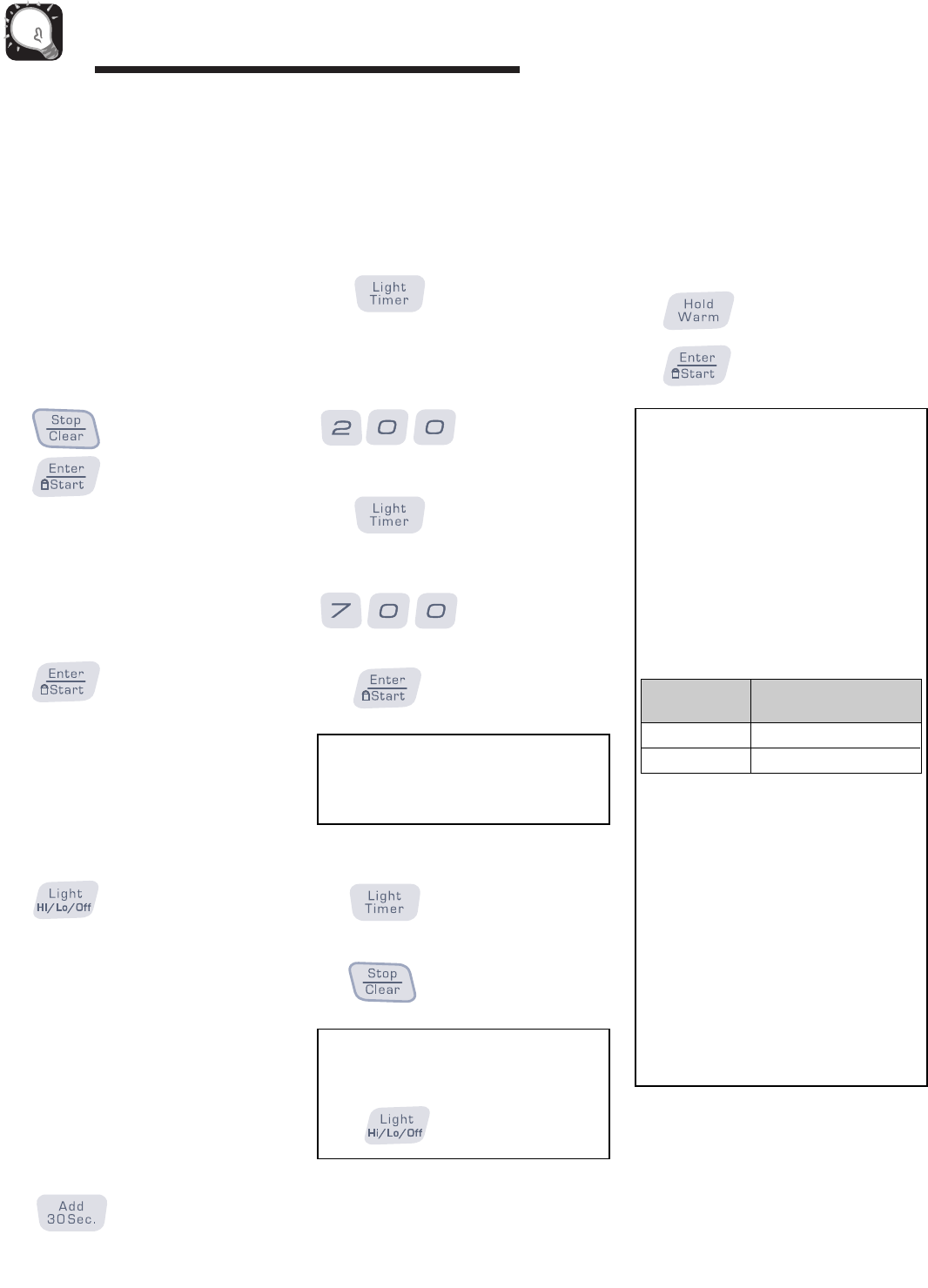
8
Operating Instructions
CHILD LOCK
You may lock the control panel to
prevent the microwave from being
accidentally started or used by
children.
The Child Lock feature is also useful
when cleaning the control panel.
Child Lock prevents accidental
programming when wiping the
control
panel.
Example: To set the child lock.
1. Touch STOP/
CLEAR pad.
2. Touch and hold
ENTER/START
pad more than 4
seconds.
LOCKED will
appear in the
display window
with two beeps.
Example: To cancel the child lock.
1. Touch and hold
ENTER/START
pad more than 4
seconds.
LOCKED will
disappear and
you hear two
beeps.
LIGHT HI/LO/OFF
Touch LIGHT
HI/LO/OFF pad
once for bright
light, twice for
night light, or three
times to turn the
light off.
ADD 30 SEC.
A time-saving pad, this simplified
control lets you quickly set and start
microwave cooking without the need
to touch the ENTER/ START pad.
Example: To set ADD 30 SEC. for 2
minutes.
1. Touch ADD 30
SEC. pad 4 times.
The oven begins
cooking and display
shows time
counting down
.
LIGHT TIMER
You can set the LIGHT to turn on
and off automatically at any time.
The light comes on at the same time
every day until reset.
Example: Turn on 2:00 AM, turn off
7:00 AM.
1. Touch LIGHT
TIMER
pad.(Press once
for AM, twice for
PM.)
2. Enter the time
you want the
LIGHT to turn
on.
3. Touch LIGHT
TIMER pad
again.(Press
once for AM,
twice for PM.)
4. Enter the time
you want the
LIGHT to turn
off.
5. Touch ENTER/
START pad.
Example: To cancel the LIGHT
TIMER.
1. Touch LIGHT
TIMER pad.
2. Touch STOP/
CLEAR pad.
HOLD WARM
You can keep cooked food warm in
your microwave oven for up to 99
minutes 99 seconds. You can use
HOLD WARM by itself or to follow a
cooking cycle automatically.
Example: To use HOLD WARM.
1. Touch HOLD
WARM pad.
2. Touch ENTER/
START pad.
NOTE:
●To reset the time to turn on and
off the LIGHT, repeat steps 1 to 5.
NOTE:
●If you want to cancel the LIGHT
TIMER in operation, touch
the pad.
NOTES:
●HOLD WARM operates for up to
99 minutes 99 seconds.
●Food cooked covered should be
covered during HOLD WARM.
●Pastry items (pies, turnovers,
etc.) should be uncovered during
HOLD WARM.
●Complete meals kept warm on a
dinner plate can be covered
during HOLD WARM.
To make HOLD WARM automati-
cally follow another cycle:
●While you are programming the
cooking instructions, touch HOLD
WARM before touching ENTER/
START.
●When the last cooking cycle is
over, you will hear two beeps and
“HOLD WARM” will appear in the
oven display.
●You can set HOLD WARM to
follow AUTO DEFROST, or multi-
cycle cooking.
Food Recommended
Type Quantity
Liquid 1-2 cups
Dry 5-10 ozs.
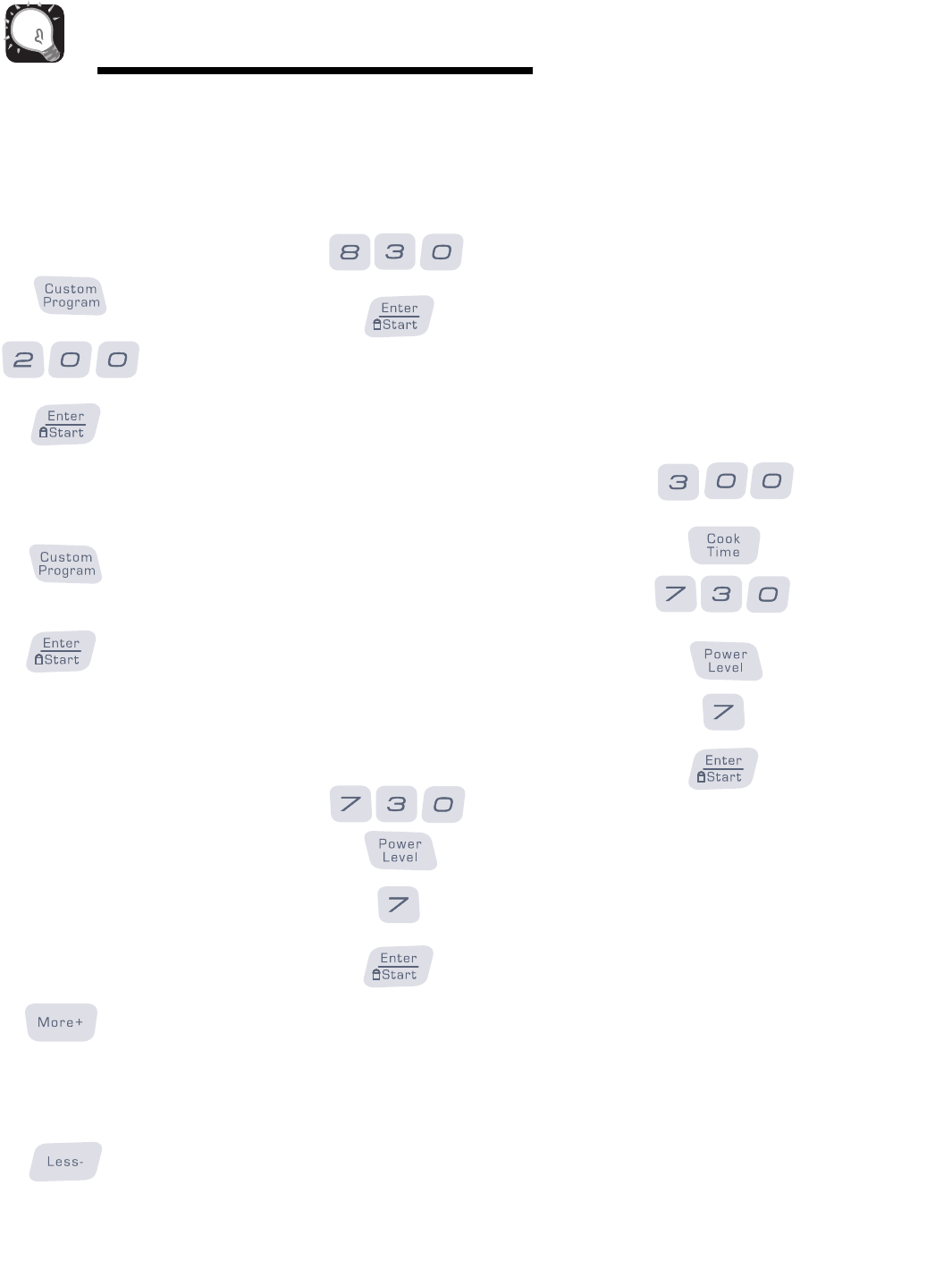
CUSTOM PROGRAM
CUSTOM PROGRAM lets you recall
one cooking instruction previously
placed in memory and begin cooking
quickly.
Example: To cook for 2 minutes.
1. Touch CUSTOM
PROGRAM
pad.
2. Enter the cook
time.
3. Touch ENTER/
START pad.
Example: To recall the custom
program.
1. Touch CUSTOM
PROGRAM
pad.
2. Touch ENTER/
START pad.
When the cook
time is over, you
will hear four
beeps and END
will display.
MORE+/LESS-
By using the MORE+ or LESS- keys,
all of the pre-programmed cook and
time cook features can be adjusted
to cook food for a longer or shorter
time.
1. Pressing
MORE+ will add
10 seconds of
cooking time
each time you
press it.
2. Pressing LESS-
will subtract 10
seconds of
cooking time
each time you
press it.
COOKING AT HIGH
POWER LEVELS
Example: To cook food for 8
minutes 30 seconds at 100% power.
1. Enter the cook
time.
2. Touch ENTER/
START pad.
When the cook
time is over,
you will hear
four beeps and
END will
display.
COOKING AT LOWER
POWER LEVELS
HIGH power cooking does not
always give you the best results with
foods that need slower cooking, such
as roasts, baked goods, or custards.
Your oven has 10 power settings in
addition to HIGH.
Example: To cook food for 7
minutes 30 seconds at 70% power.
1. Enter the cook
time.
2. Touch POWER
LEVEL pad.
3. Enter the power
level.
4. Touch ENTER/
START pad.
When the cook
time is over, you
will hear four
beeps and END
will display.
See cooking
guide for Power
levels, page 10.
COOKING WITH
MORE THAN ONE
COOK CYCLE
For best results, some recipes call for
one Power Level for a certain length
of time, and another Power Level for
another length of time.Your oven can
be set to change from one to another
automatically, for up to three cycles if
the first heating cycle is defrost.
Example: To cook food for 3
minutes at 100% power and then
70% power for 7 minutes 30
seconds.
1. Enter the first
cook time.
2. Touch COOK
TIME pad.
3. Enter the
second cook
time.
4. Touch POWER
LEVEL pad.
5. Enter the power
level.
6. Touch ENTER/
START pad.
When the cook
time is over, you
will hear four
beeps and END
will display.
9
Operating Instructions
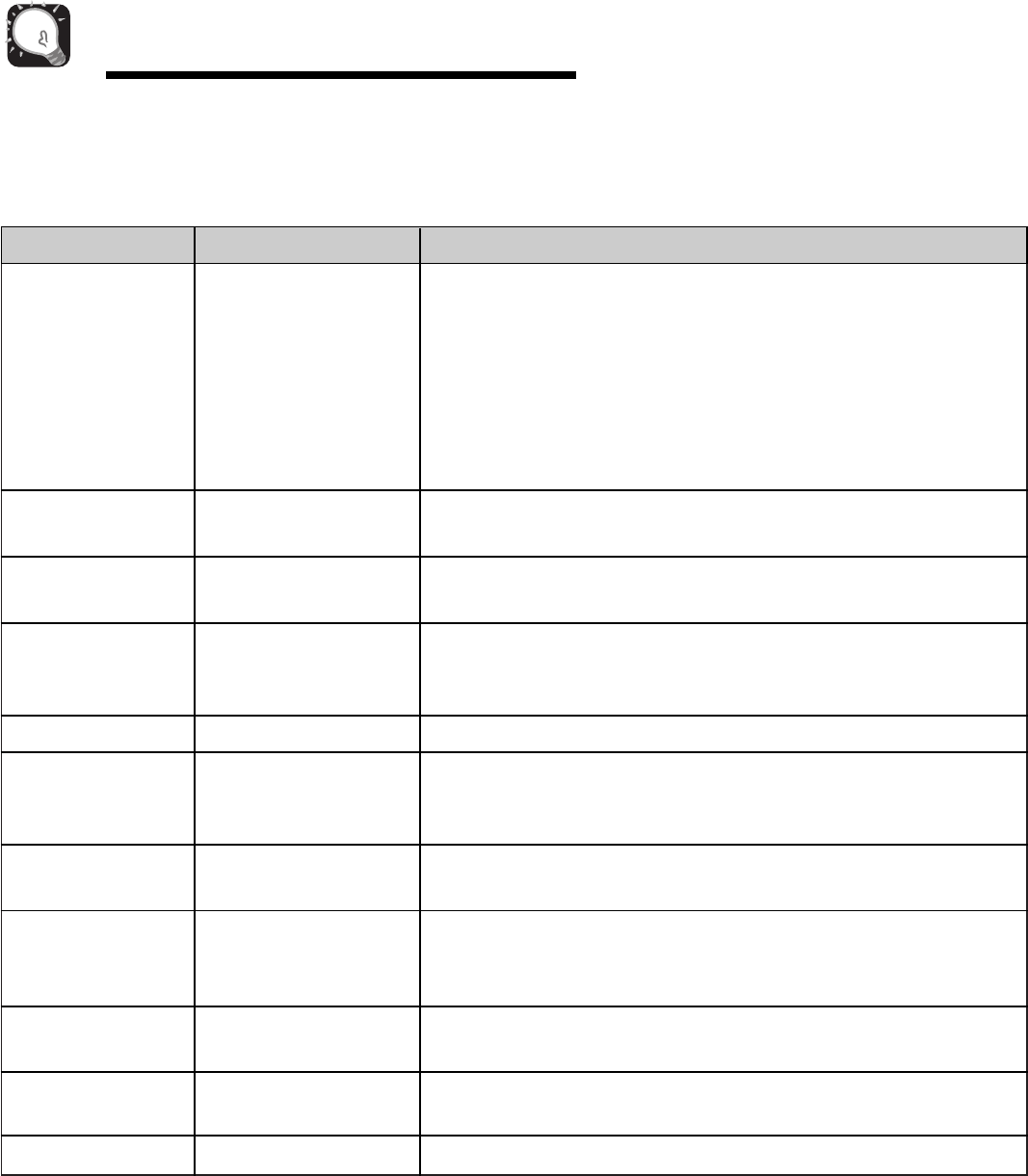
10
Operating Instructions
COOKING GUIDE FOR LOWER POWER LEVELS
The 10 power levels in addition to HIGH allow you to choose the best power level for the food you are cooking. Below
are listed all the power levels, examples of foods best cooked at each level, and the amount of microwave power you
are using.
10 High 100% ●Boil water.
●Cook ground beef.
●Make candy.
●Cook fresh fruits and vegetables.
●Cook fish and poultry.
●Preheat browning dish.
●Reheat beverages.
●Bacon slices. Place utensil on metal oven rack.
9 90%
●Reheat meat slices quickly.
●Saute onions, celery, and green pepper.
8 80%
●All reheating.
●Cook scrambled eggs.
7 70%
●Cook breads and cereal products.
●Cook cheese dishes, veal.
●Cook cakes, muffins, brownies, cupcakes.
6 60%
●Cook pasta.
5 50%
●Cook meats, whole poultry.
●Cook custard.
●Cook whole chicken, turkey, spare ribs, rib roast, sirloin roast.
4 40%
●Cook less tender cuts of meat.
●Reheat frozen convenience foods.
3 30%
●Thaw meat, poultry, and seafood.
●Cook small quantities of food.
●Finish cooking casserole, stew, and some sauces.
2 20%
●Soften butter and cream cheese.
●Heat small amounts of food.
1 10%
●Soften ice cream.
●Raise yeast dough.
0 ●Standing time.
POWER LEVEL MICROWAVE OUTPUT USE
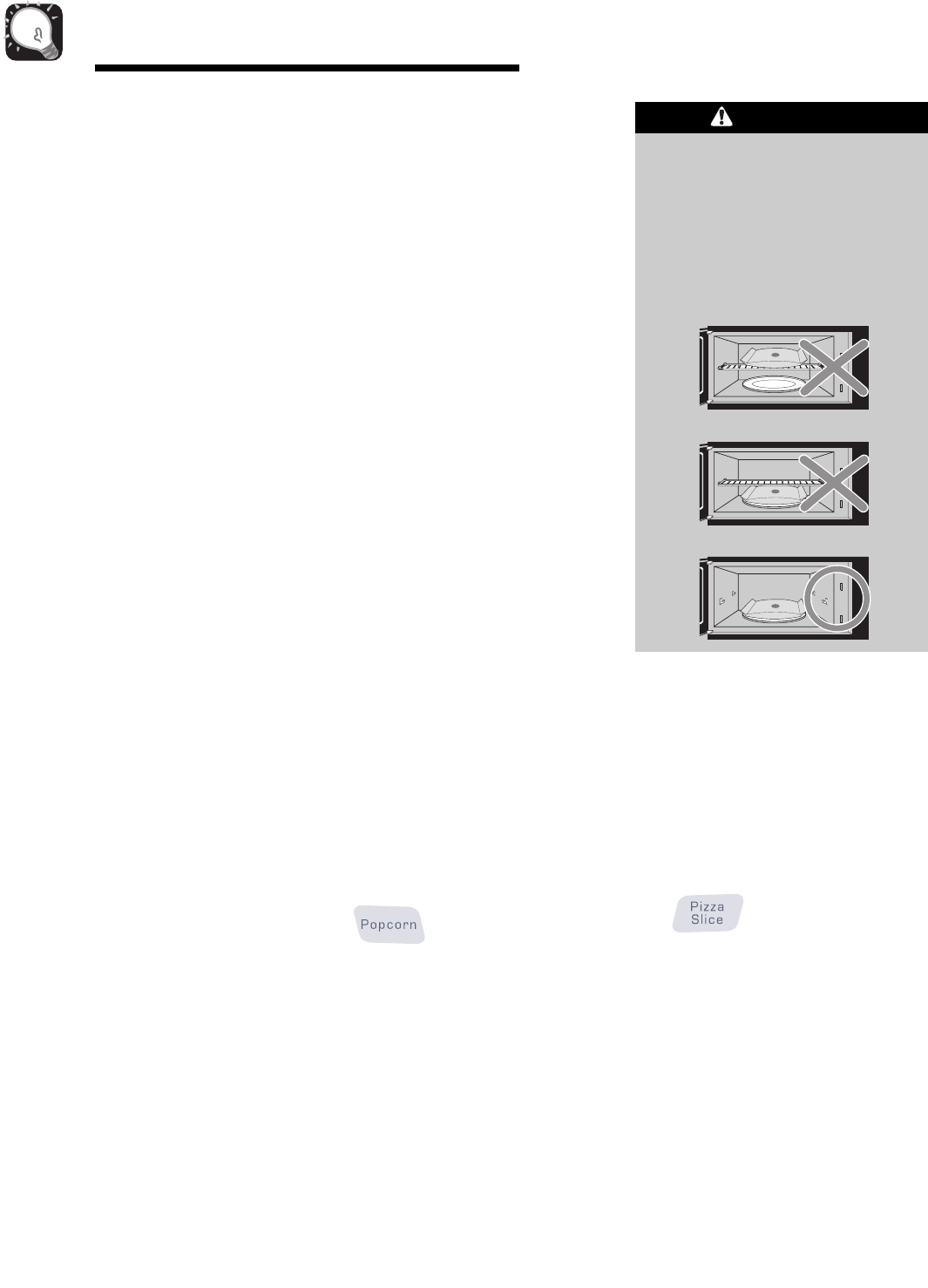
SENSOR OPERATING
INSTRUCTIONS
Sensor Cook allows you to cook
most of your favorite foods without
selecting cooking times and power
levels. The display will indicate
SENSING during the initial sensing
period. The oven automatically
determines required cooking time for
each food item. When the internal
sensor detects a certain amount of
humidity coming from the food, it will
tell the oven how much longer to
heat. The display will show the
remaining heating time. For best
results for cooking by Sensor, follow
these recommendations:
1. Food cooked with the sensor
system should be at normal
storage temperature.
2. Glass turntable and outside of
container should be dry to assure
best cooking results.
3. Foods should always be covered
loosely with microwavable plastic
wrap, waxed paper, or a lid.
4. Do not open the door or touch the
STOP/CLEAR pad during the
sensing time. When sensing time
is over, the oven beeps twice and
the remaining cooking time will
appear in the display window. At
this time you can open the door to
stir, turn, or rearrange the food.
SENSOR COOKING
GUIDE
Appropriate containers and coverings
help assure good Sensor cooking
results.
1. Always use microwavable con-
tainers and cover them with lids or
vented plastic wrap.
2. Never use tight-sealing plastic
covers. They can prevent steam
from escaping and cause food to
overcook.
3. Match the amount to the size of
the container. Fill containers at
least half full for best results.
4. Be sure the outside of the cooking
container and the inside of the
microwave oven are dry before
placing food in the oven. Beads of
moisture turning into steam can
mislead the sensor.
ADDING OR
SUBTRACTING
COOK TIME
By using the MORE+ or LESS- pads
all of the sensor cook and time cook
settings can be adjusted to cook food
for a longer or shorter time. Pressing
MORE+ will add 10 seconds of
cooking time each time you press it.
Pressing LESS- will subtract 10
seconds of cooking time each time
you press it.
POPCORN
POPCORN lets you pop commercial-
ly packaged microwave popcorn.
Pop only one package at a time. For
best results, use fresh bags of
popcorn.
Example: To pop popcorn
1. Touch
POPCORN pad.
When the cook
time is over, you
will hear four
beeps and END
will display.
● Recommended amounts:
3.0-3.5 ozs.
PIZZA SLICE
Reheating pizza with PIZZA SLICE
lets you reheat one or several slices
of pizza without selecting cooking
times and power levels.
Example: To reheat 2 slices of
pizza.
1. Touch PIZZA
SLICE pad.
When the cook
time is over, you
will hear four
beeps and END
will display.
●Recommended amounts: 1-3 slices,
(about 3-5 ozs. each slice).
●DO NOT leave microwave
oven unattended while pop-
ping corn.
●When popping commercially
packaged popcorn,remove
the rack from the oven;
Do not place the bag of
microwave popcorn on the
rack or under the rack.
11
Operating Instructions
CAUTION
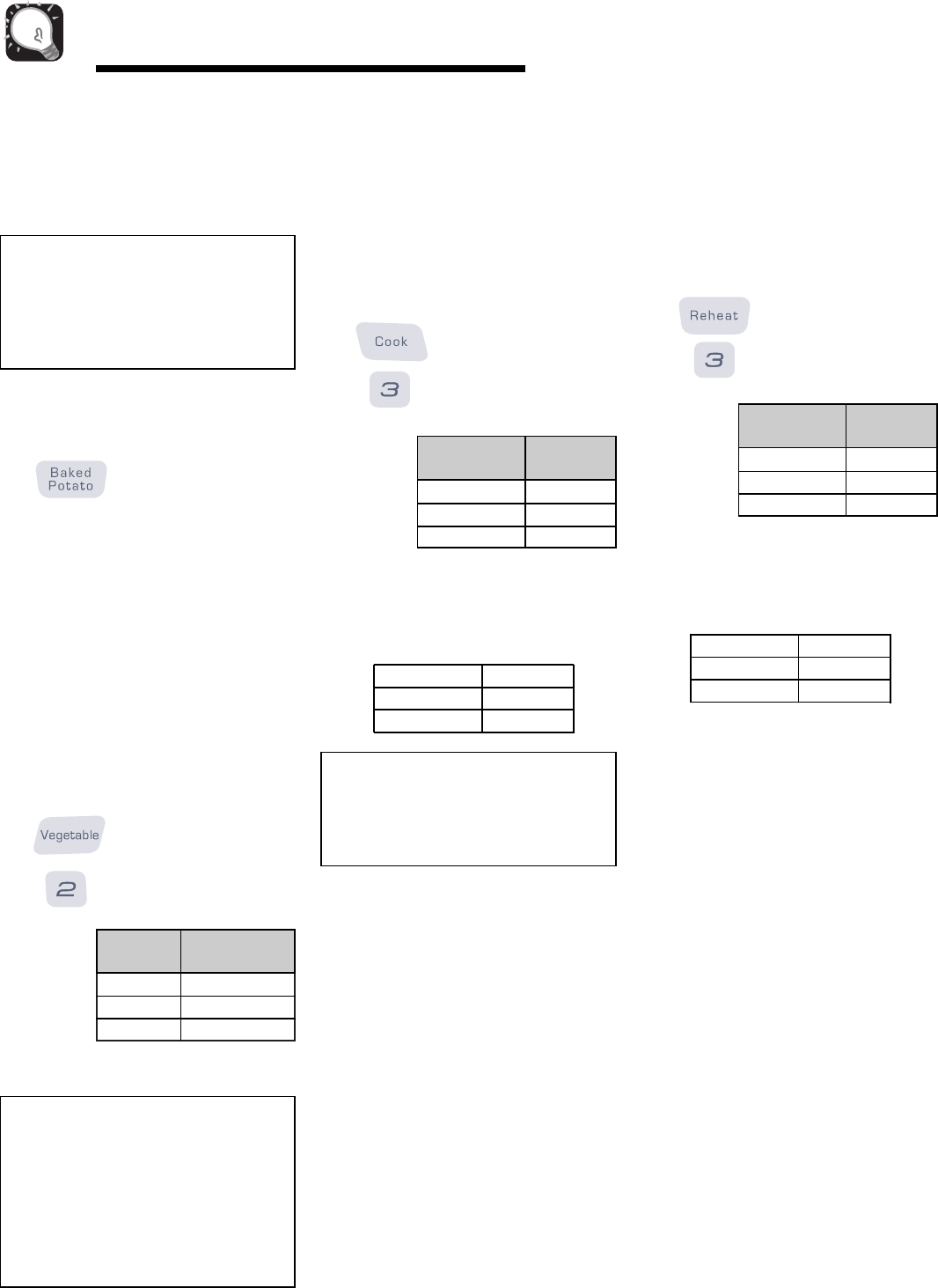
COOK
Using COOK lets you heat common
microwave-prepared foods without
needing to program times and Cook
Powers. COOK has preset Cook
Power for 3 food categories: Frozen
Entree, Casserole, and Rice.
Example: To cook Rice.
1. Touch COOK
pad.
2. Choose food
category.
When the cook time is over, you will
hear four beeps and END will
display.
BAKED POTATO
The BAKED POTATO pad lets you
bake one or several potatoes without
selecting cooking times and power
levels.
Example: To cook 2 potatoes.
1. Touch BAKED
POTATO pad.
When the cook
time is over, you
will hear four
beeps and END
will display.
●Recommended amounts: 1-4
potatoes (about 9-11 ozs. each)
VEGETABLE
VEGETABLE has preset cook pow-
ers for 3 food categories: Fresh,
Frozen, and Canned.
Example: To cook Frozen
Vegetable.
1. Touch
VEGETABLE
pad.
2. Choose food
category.
When the cook time is over, you will
hear four beeps and END will display.
12
Operating Instructions
REHEAT
REHEAT lets you heat foods without
needing to program times and Cook
Powers. REHEAT has preset Cook
Powers for 3 categories: Casserole,
Dinner Plate, and Soup/Sauce.
Example: To reheat Casserole.
1. Touch REHEAT
pad.
2. Choose food
category.
When the cook time is over, you will
hear four beeps and END will display.
Category Touch Pad
Number
Fresh
Frozen
Canned
1
2
3
Category
Touch Pad
Number
Frozen Entree
Casserole
Rice
1
2
3
Category
Touch Pad
Number
Dinner Plate
Soup/Sauce
Casserole
1
2
3
Recommended amounts:
Frozen Entree
Casserole
Rice
10-21 ozs.
1-4 cups
1/2-2 cups
Recommended amounts:
Dinner Plate
Soup/Sauce
Casserole
1-2 servings
1-4 cups
1-4 cups
NOTES:
●Before baking, pierce potato with
fork several times.
●After baking, let stand for 5 min-
utes.
NOTE:
● Use only long grain rice with
sensor cook program. See page
20 to cook other types of rice.
NOTE:
●Place canned vegetables in a
microwavable bowl or casserole.
Cover with plastic wrap and vent.
Let stand 5 minutes.
-
Recommended amounts: 1-4 cups
- Recommend 1/4”-1/2” venting of
cover.
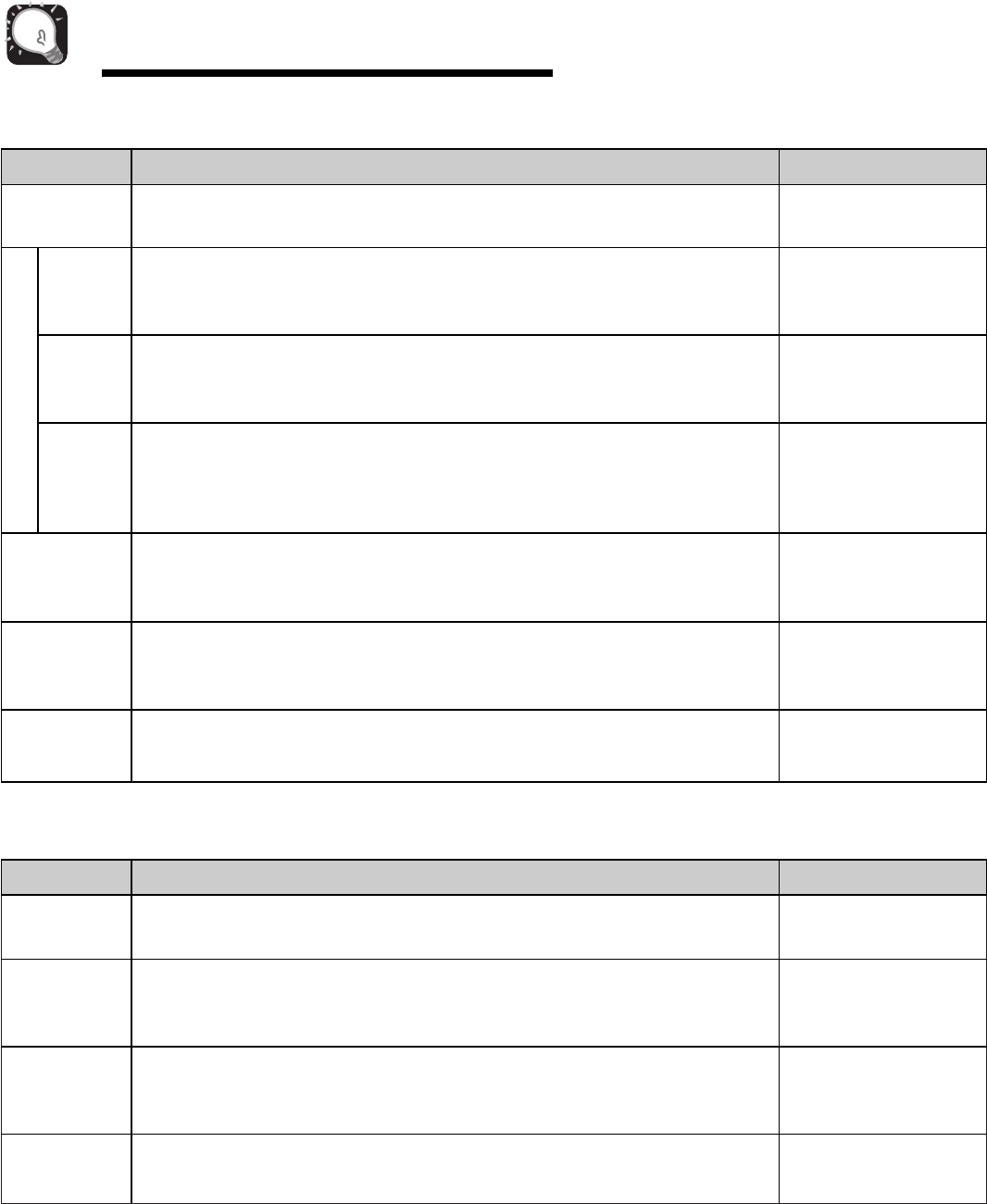
SENSOR COOK TABLE
CATEGORY DIRECTIONS AMOUNT
Pierce each potato with a fork and place on the oven tray around the
edge, at least one inch apart.
Prepare as desired, wash, and leave residual water on the vegetables.
Place in an appropriately-sized microwave container, cover with
plastic wrap and vent.
Remove from package, rinse off frost under running water. Place in
an appropriately-sized microwave container, cover with plastic wrap
and vent.
Remove from the outer display can.
Place in an appropriately sized microwave container, cover with plastic
wrap and vent.
After cooking, stir and allow to stand for 3 minutes.
Assemble the ingredients per the recipe in a 1-2 quart casserole.
Cooking with plastic wrap and vent.
After cooking, stir and allow to stand for 3 minutes
Add twice the amount of water to the rice.
Use a microwave container large enough to prevent water from boiling
over dish. Cover with plastic wrap or lid.
Remove from outer display package. Slit cover. If not in microwave-
safe container, place on plate, cover with plastic wrap and vent.
1 - 4 medium approx.
8 -10 ozs. each
1 - 4 cups
1 - 4 cups
1 - 4 cups
1 - 4 cups
1/2- 2 cups
10 - 21 ozs.
Potato
Casserole
Rice
Frozen
Entree
Fresh
Vegetable
Frozen
Vegetable
Canned
Vegetable
VEGETABLE
SENSOR REHEAT TABLE
CATEGORY DIRECTIONS AMOUNT
This is a reheat function for leftover pizza.
Place on paper towel on a microwave safe plate.
Place on a low plate.
Cover with vented plastic wrap.
Let stand 3 minutes.
Place in shallow microwavable casserole.
Cover with vented plastic wrap.
After cooking, stir and let stand 3 minutes.
Cover dish containing the casserole with plastic wrap and vent.
After cooking, stir and allow to stand for 3 minutes.
1 - 3 slices
(3 - 5 ozs. each)
1 - 2 servings
1 - 4 cups
1 - 4 cups
Pizza
Dinner Plate
Soup/Sauce
Casserole
13
Operating Instructions
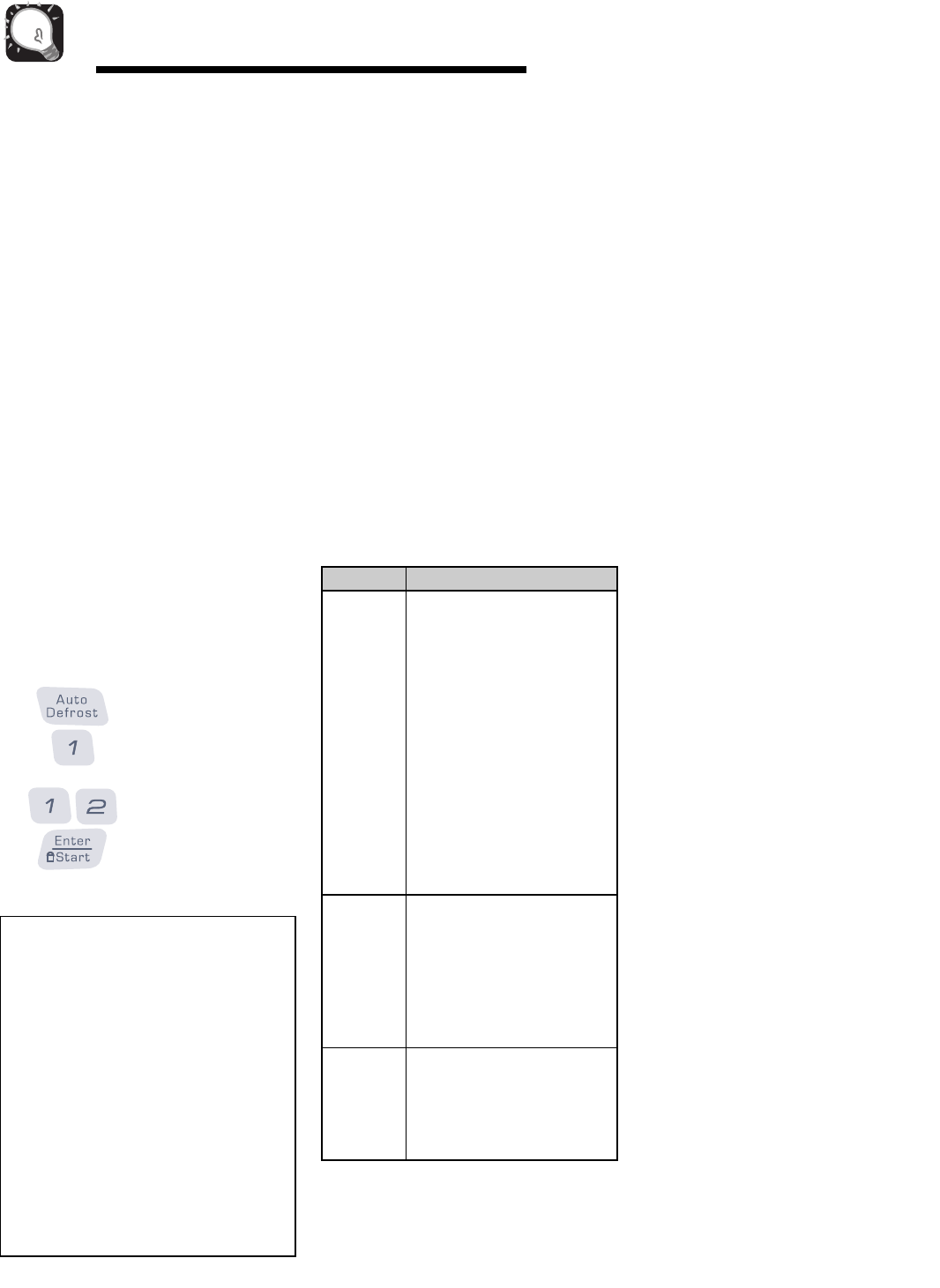
For best results:
●Remove fish, shellfish, meat, and
poultry from its original closed
paper or plastic package (wrapper).
Otherwise, the wrap will hold steam
and juice close to the foods, which
can cause the outer surface of the
foods to cook.
●Form the meat into the shape of a
doughnut before freezing. When
defrosting, scrape off thawed meat
when the beep sounds and
continue defrosting.
●Place foods in a shallow glass
baking dish or a on a microwave
roasting rack to catch drippings.
●Foods should still be somewhat icy
in the center when removed from
the oven.
AUTO DEFROST TABLE
AUTO DEFROST
Three defrost choices are preset in
the oven. The defrost feature
provides you with the best defrosting
method for frozen foods, because the
oven automatically sets the
defrosting times for each food item
according to the weight you enter.
For added convenience, the AUTO
DEFROST includes a built-in tone
mechanism that reminds you to
check, turn over, separate, or
rearrange the food during the defrost
cycle. Three different defrosting
options are provided.
1. MEAT
2. POULTRY
3. FISH
After touching the AUTO DEFROST
once, select the food category.
Available weight ranges for Meat,
Poultry and Fish are 0.1 to 6.0 lbs.
Example : To defrost 1.2 lbs of
meat.
1. Touch AUTO
DEFROST pad.
2. Choose food
category.
3. Enter the
weight.
4. Touch
ENTER/START
pad.
NOTES:
●After you touch ENTER/ START,
the display counts down the
defrost time. The oven will beep
once during the Defrost cycle. At
this time, open the door and turn,
separate, or rearrange the food as
needed. Remove any portions that
have thawed then return frozen
portions to the oven and touch
ENTER/START to resume the
defrost cycle.
●The oven will not stop during
the BEEP unless the door is
opened.
14
Operating Instructions
DEFROST TIPS
●When using AUTO DEFROST, the
weight to be entered is the net
weight in pounds and tenths of
pounds (the weight of the food
minus the container).
●Use AUTO DEFROST only for raw
food. AUTO DEFROST gives best
results when food to be thawed is a
minimum of 0°F (taken directly from
a true freezer). If food has been
stored in a refrigerator-freezer that
does not maintain a temperature of
5°F or below, always program a
lower food weight (for a shorter
defrosting time) to prevent cooking
the food.
●If the food is stored outside the
freezer for up to 20 minutes, enter a
lower food weight.
●The shape of the package alters the
defrosting time. Shallow rectangular
packets defrost more quickly than a
deep block.
●Separate pieces as they begin to
defrost. Separated pieces defrost
more easily.
●You can use small pieces of alu-
minum foil to shield foods like
chicken wings, leg tips, and fish
tails, but the foil must not touch the
side of the oven. Foil causes arcing,
which can damage the oven lining.
●Shield areas of food with small
pieces of foil if they start to become
warm.
●For better results, a preset standing
time is included in the defrosting
time.
●For best results, elevate food to be
defrosted on a microwave safe
roasting rack. This prevents the
possibility of warm meat juices
cooking food during defrost.
Category Food
MEAT
0.1 to 6.0 lbs
POULTRY
0.1 to 6.0 lbs
FISH
0.1 to 6.0 lbs
BEEF
Ground beef, Round steak,
Cubes for stew, Tenderloin
steak, Pot roast, Rib roast,
Rump roast, Chuck roast,
Hamburger patty.
LAMB
Chops (1-inch thick),
Rolled roast.
PORK
Chops (1/2-inch thick), Hot
dogs, Spareribs, Country-
style ribs.
Rolled roast, Sausage.
POULTRY
Whole (under 4 lbs), Cut up,
Breasts (boneless).
CORNISH HENS
Whole.
TURKEY
Breast (under 6 lbs).
FISH
Fillets, Whole Steaks.
SHELLFISH
Crab meat, Lobster tails,
Shrimp, Scallops.
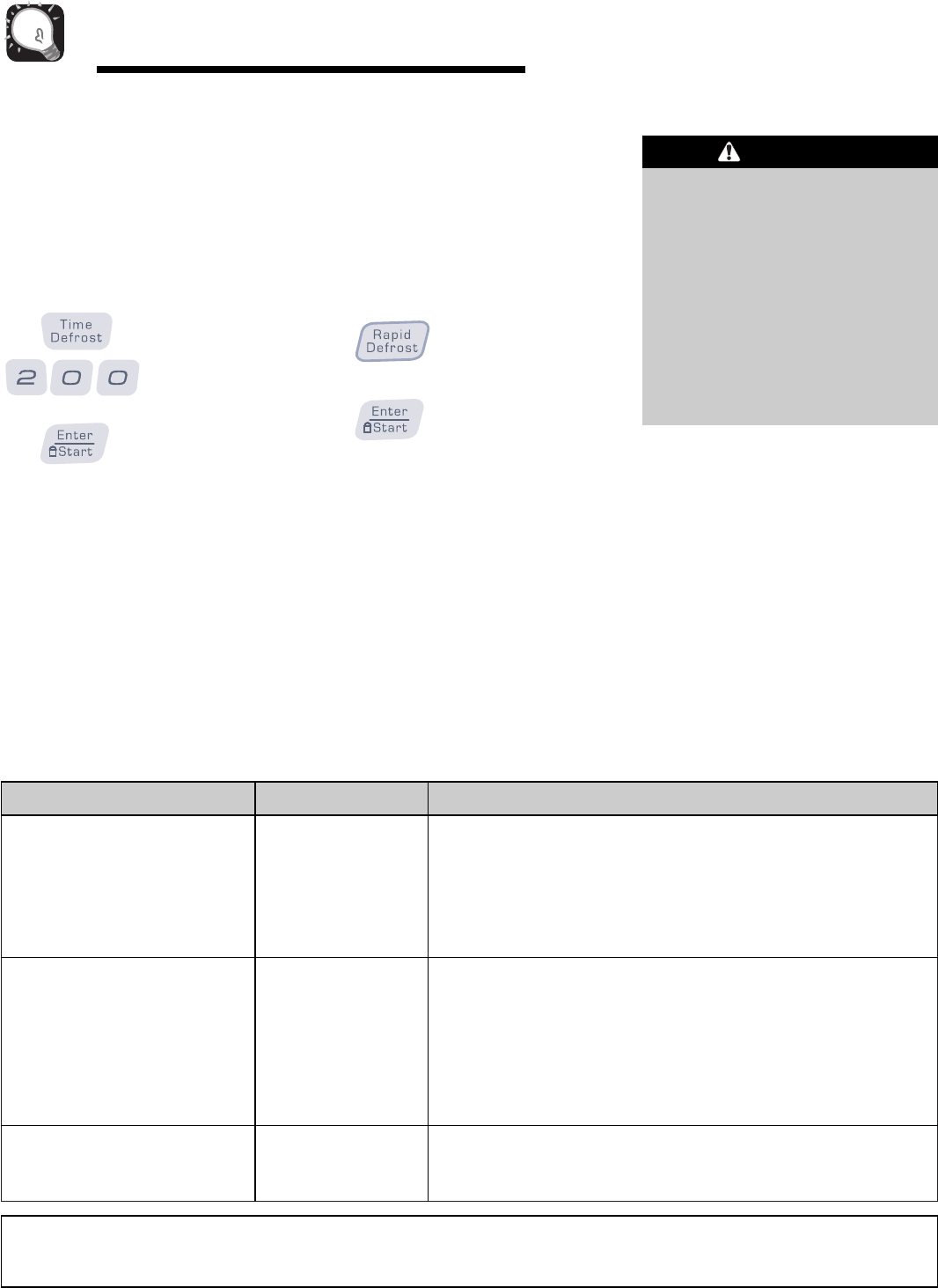
15
Operating Instructions
RAPID DEFROST
The RAPID DEFROST feature
provides a rapid defrost for 1.0
pound frozen food. The oven
automatically sets the defrosting time
for ground beef.
Example: To defrost 1lb. ground
beef.
1. Touch RAPID
DEFROST pad.
2. Touch
ENTER/START
pad.
TIME DEFROST
This feature allows you to choose the
time you want to defrost.
The Time Defrost Chart provides
some basic guidelines for using Time
Defrost.
Example: To defrost for 2 minutes.
1. Touch TIME
DEFROST pad.
2. Enter the
defrosting time
you want.
3. Touch
ENTER/START
pad.(Defrost
starts)
When the defrost time is over, you
will hear four beeps and END will
display.
METAL RACK
The metal rack gives you extra space
when cooking in more than one
container at the same time.
To use rack:
1. Place rack securely in the four
plastic supports.
●Rack MUST NOT touch metal
walls or back of microwave
oven.
2. Place equal amounts of food both
ABOVE AND BELOW rack.
●Amount of food must be
approximately the same to
balance out cooking energy.
NOTE:
● Defrost times are approximate and are intended as guidelines.
To avoid risk of property
damage:
●Do not use rack to pop
popcorn.
●Rack must be on the four
plastic supports when used.
●Use the rack only when
cooking food on rack position.
●Do not cook with rack on floor
of the oven.
CAUTION
TIME DEFROST CHART
FOOD TIME SPECIAL INSTRUCTIONS
Turn meat over at beep. Stand for 5 minutes after defrosting.
Turn meat over at beep. Stand for 5 minutes after defrosting.
Turn meat over at beep. Shield warm areas with foil.
Stand for 5 to 10 minutes.
Same as above.
Turn meat over at beep. Shield warm areas with foil.
Stand for 20 to 30 minutes. Cover with foil.
Turn meat over at beep. Shield warm areas with foil.
Stand for 20 to 30 minutes. Cover with foil.
Turn meat over at beep. Shield warm areas with foil.
Stand for 20 to 30 minutes. Cover with foil.
Place block in casserole. Turn food over and break up
after beep. Stand for 5 minutes.
MEAT
Bacon (1 lb.)
Ground meat (1 lb.)
Roasts
Steaks, chops and cutlets
POULTRY
Chicken, broiler-fryer
cut up (21/2 to 3 lbs.)
Chicken, whole (2 to 3 lbs.)
Cornish hen
FISH & SEAFOOD
Fillets (1 lb.)
Shellfish, small pieces (1 lb.)
2 - 4 minutes
41/2- 6 minutes
41/2- 6 minutes
41/2- 6 minutes per lb.
13 - 16 minutes
15 - 18 minutes
5 - 7 minutes per lb.
4 - 5
1/2
minutes
4 - 5 minutes
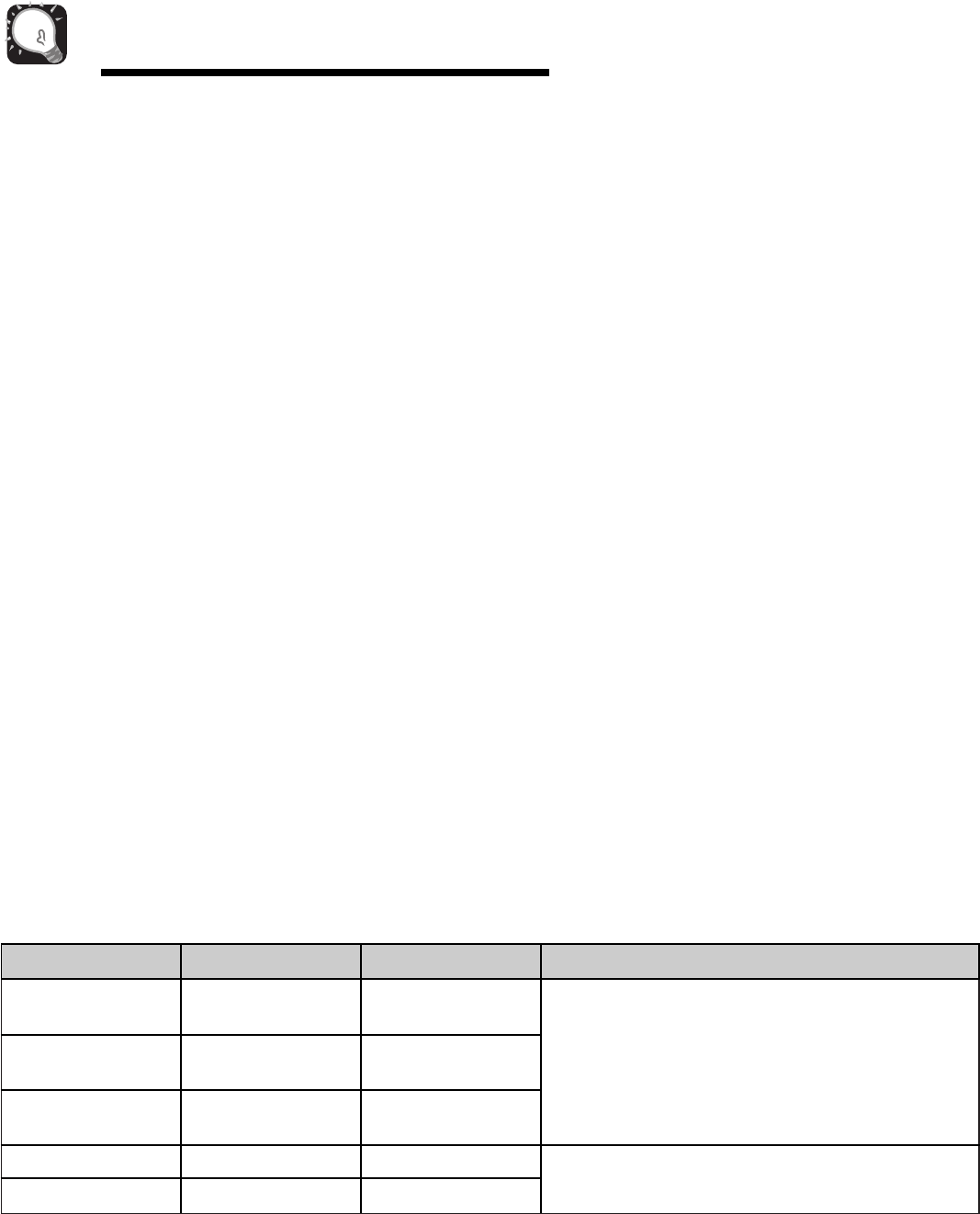
16
Operating Instructions
GETTING THE BEST
COOKING RESULTS
To get the best results from your
microwave oven, read and follow the
guidelines below.
●Storage Temperature: Foods
taken from the freezer or refrigerator
take longer to cook than the same
foods at room temperature.
The time for recipes in this book is
based on the normal storage
temperature of the food.
●Size: Small pieces of food cook
faster than large ones, pieces
similar in size and shape cook more
evenly. For even cooking, reduce
the power when cooking large
pieces of food.
●Natural Moisture: Very moist foods
cook more evenly because
microwave energy is attracted to
water molecules.
●Stir foods such as casseroles and
vegetables from the outside to the
center to distribute the heat evenly
and speed cooking. Constant
stirring is not necessary.
●Turn over foods like pork chops,
baking potatoes, roasts, or whole
cauliflower halfway through the
cooking time to expose all sides
equally to microwave energy.
●Place delicate areas of foods, such
as asparagus tips, toward the
center of the dish.
●Arrange unevenly shaped foods,
such as chicken pieces or salmon
steaks, with the thicker, meatier
parts toward the outside of the dish.
●Shield, with small pieces of
aluminum foil, parts of food that
may cook quickly, such as wing tips
and leg ends of poultry.
●Let It Stand: After you remove the
food from the microwave, cover
food with foil or casserole lid and let
it stand to finish cooking in the
center and avoid overcooking the
outer edges. The length of standing
time depends on the density and
surface area of the food.
●Wrapping in waxed paper or
paper towel: Sandwiches and
many other foods containing
prebaked bread should be wrapped
prior to microwaving to prevent
drying out.
FISH AND SHELLFISH
Cooking Fish and Shellfish:
General Directions
●Prepare the fish for cooking.
- Completely defrost the fish or
shellfish.
- Arrange unevenly shaped pieces
with thicker parts toward the
outside of the dish. Arrange
shellfish in a single layer for even
cooking.
- The type of cover you use
depends on how you cook.
Poached fish needs a
microwavable lid or vented plastic
wrap.
- Baked fish, coated fish, or fish in
sauce needs to be covered lightly
with waxed paper to keep the
coating crisp and sauce from
getting watery.
- Always set the shortest cooking
time. Fish is done when it turns
opaque and the thickest part
begins to flake. Shellfish is done
when the shell turns from pink to
red and the flesh is opaque and
firm.
● The Fish and Shellfish Cooking
Table below provides specific direc-
tions with Power Level and Cooking
Time settings for most types of fish
and shellfish.
FISH AND SHELLFISH COOKING TABLE
FISH POWER LEVEL COOKING TIME DIRECTIONS
Fish fillets HI 31/2-41/2minutes
Fish steaks HI 41/2-51/2minutes
Whole fish 74
1/2-6 minutes
Scallops HI 31/2-5 minutes
Shrimp, shelled HI 31/2-5 minutes
Arrange fish in a single layer with thickest portion
toward outside edge of 11/2quart microwavable
baking dish. Brush with melted butter and season,
if desired. Cook covered with vented plastic wrap.
Let stand covered 2 minutes. If you are cooking
more than 1 lb. of fish, turn the fish halfway
through cooking.
Arrange in a single layer. Prepare as directed
above, except stir instead of turning the shellfish.

17
Operating Instructions
APPETIZERS/SAUCES/
SOUPS
Cooking Appetizers: Tips and
Techniques
Recommended
●Crisp crackers, such as melba
toast, shredded wheat, and crisp
rye crackers are best for
microwave use.Wait until party
time to add the spreads. Place a
paper towel under the crackers
while they cook in the microwave
oven to absorb extra moisture.
●Arrange individual appetizers in a
circle for even cooking.
●Stir dips to distribute heat and
shorten cooking time.
Cooking Sauces: Tips and
Techniques
●Use a microwavable casserole or
glass measuring cup that is at least
2 or 3 times the volume of the
sauce.
●Sauces made with cornstarch
thicken more rapidly than those
made with flour.
●Cook sauces made with cornstarch
or flour uncovered so you may stir
them 2 or 3 times during cooking for
a smooth consistency.
●To adapt a conventional sauce or
gravy recipe, reduce the amount of
liquid slightly.
Cooking Soups: Tips and
Techniques
●Cook soups in a microwavable dish
which holds double the volume of
the recipe ingredients to prevent
boil-over, especially if you use
cream or milk in the soup.
●Generally, cover microwaved soups
with VENTED plastic wrap or a
microwavable lid.
●Cover foods to retain moisture.
Uncover foods to retain crispness.
●Avoid overcooking by using the
minimum suggested time. Add
more time, if necessary, only after
checking the food.
●Stirring occasionally will help blend
flavors, distribute heat evenly, and
may even shorten the cooking time.
●When converting a conventional
soup recipe to cook in the
microwave, reduce the liquid, salt,
and strong seasonings.
Not Recommended
●Appetizers with a crisp coating or
puff pastry are best done in a
conventional oven with dry heat.
●Breaded products can be warmed
in the microwave oven but will not
come out crisp.
MEAT
Cooking Meat: General Directions
●Prepare the meat for cooking.
- Defrost completely.
- Trim off excess fat to avoid
spattering.
- Place the meat, fat side down, on
a microwavable rack in a
microwavable dish.
- Use oven cooking bag for less
tender cuts of meat.
- Arrange the meat so that thicker
portions are toward the outside of
the dish.
- Cover the meat with waxed paper
to prevent spattering.
●Tend the meat as it cooks.
- Drain juices as they accumulate to
reduce spattering and keep from
overcooking the bottom of the
meat.
- Shield thin or bony portions with
strips of foil to prevent
overcooking.
●Let the meat stand covered with foil
10-15 minutes after you remove it
from the oven. The internal
temperature of the meat may rise
from 5-10° F during standing time.
The Meat Cooking Table on the next
page provides detailed directions,
Power Level, and Cooking Time
settings for most cuts of meat.
NOTE:
●Keep the foil at least 1 inch from
the oven walls, and do not cover
more than one-third of the meat
with foil at any one time.
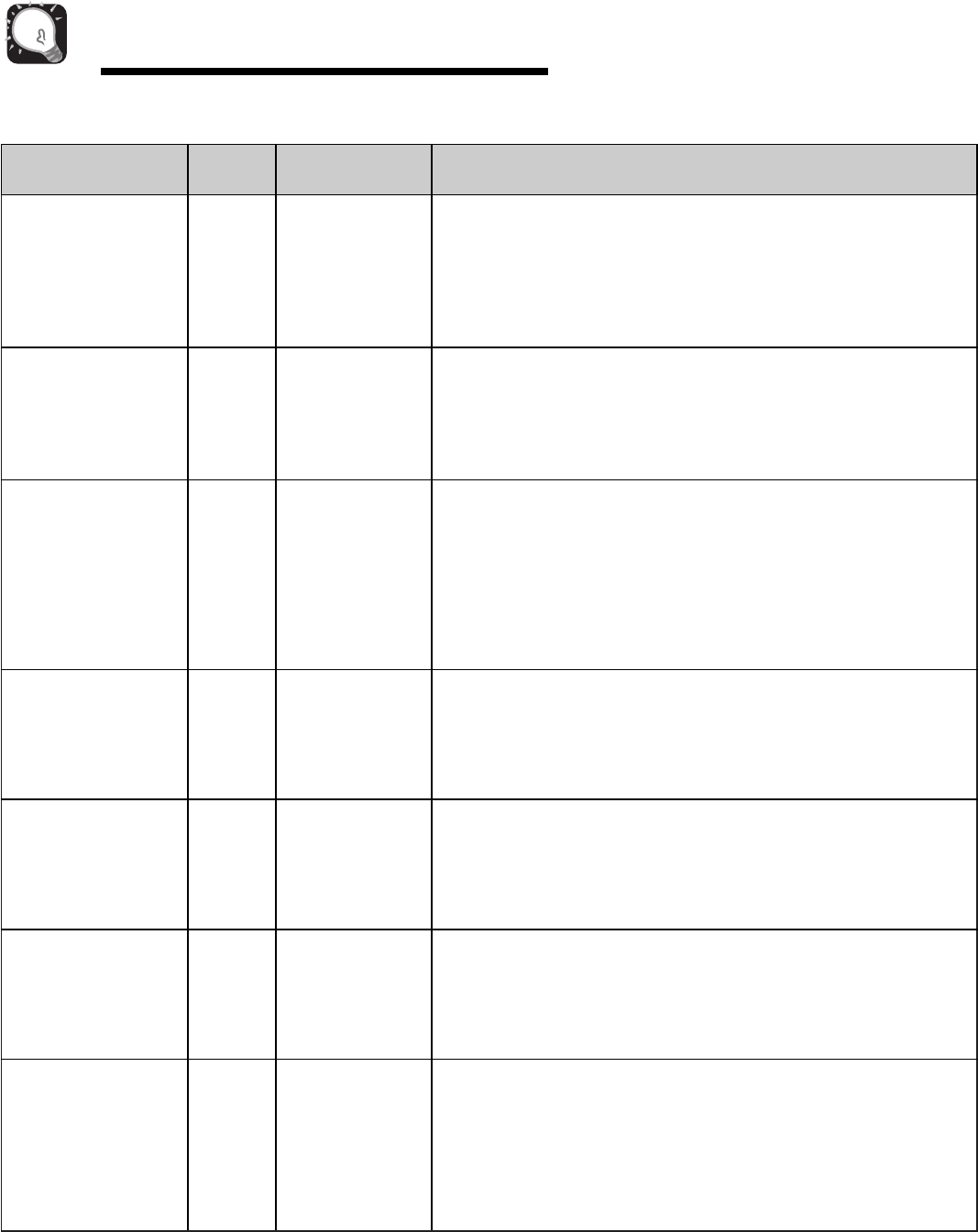
18
Operating Instructions
MEAT COOKING TABLE
MEAT
BEEF
Hamburgers,
Fresh or defrosted
(4 oz. each)
1 patty
2 patties
4 patties
Sirloin tip roast
(3-4 lbs.)
LAMB
Lamb roast, rolled
boneless (3-4 lbs.)
PORK
Bacon slices
2 slices
4 slices
6 slices
10 slices
Chops
(5-7 oz. each)
2 chops
4 chops
Loin Roast,
rolled, boneless
(31/2- 41/2lbs.)
Sausage links,
Fresh or Frozen,
defrosted
(1-2 oz. each)
2 links
4 links
6 links
10 links
1-11/2minutes
11/2-2 minutes
21/2-31/2minutes
8-10 minutes
per pound
RARE (135°F)
11-13 minutes
per pound
MEDIUM (155°F)
11-12 minutes
per pound
RARE (135°F)
12-13 minutes
per pound
MEDIUM (145°F)
13-14 minutes
per pound
WELL (155°F)
11/2-2 minutes
2-3 minutes
4-5 minutes
7-8 minutes
18-20 minutes
per pound
15-17 minutes
per pound
25-27 minutes
per pound
(165°F)
45-60 seconds
1-11/2minutes
11/2-2 minutes
13/4-2 minutes
Form patties with depression in center of each.
Place on microwavable roasting rack. Brush with browning
agent, if desired. Cover with waxed paper.
Turn over halfway through cooking.
Let stand covered 1 minute.
Place roast fat side down on microwavable roasting rack.
Add desired seasonings and cover with waxed paper.
Turn meat over halfway through cooking and shield if
necessary. Remove roast from microwave oven when
desired temperature is reached. Let stand covered with foil
15 minutes. (Temperature may rise about 10°F).
Place roast fat side down on microwavable roasting rack.
Brush lamb with marinade or desired seasonings such as
rosemary, thyme or marjoram. Cover with waxed paper.
Turn roast over after 15 minutes, and again after 30 minutes.
Shield if necessary.
Remove roast from microwave when desired temperature
is reached. Let stand covered with foil 15 minutes.
(Temperature may rise about 10°F).
Place bacon slices on microwavable roasting rack.
Cover with paper towels.
Place microwavable roasting rack on the metal oven rack.
After cooking, let stand 1 minute.
Place chops in microwavable baking dish.
Add desired seasonings and cover with vented plastic wrap.
Cook until no longer pink or until internal temperature
reaches 170° F. Turn chops over halfway through cooking.
Let stand covered 5 minutes.
(Temperature may rise about 10°F).
Place roast in cooking bag in microwavable dish.
Add seasonings and browning agent if desired. Close bag
loosely with microwavable closure or string. After cooking,
let stand in bag 15 minutes. (Temperature may rise about
10°F.) Internal temperature of pork should reach 170°F
before serving.
Pierce links and place on microwavable roasting rack.
Cover with waxed paper or paper towel.
Turn over halfway through cooking.
After cooking, let stand covered 1 minute.
HI
5
5
HI
3
3
HI
POWER
LEVEL COOKING
TIME DIRECTIONS
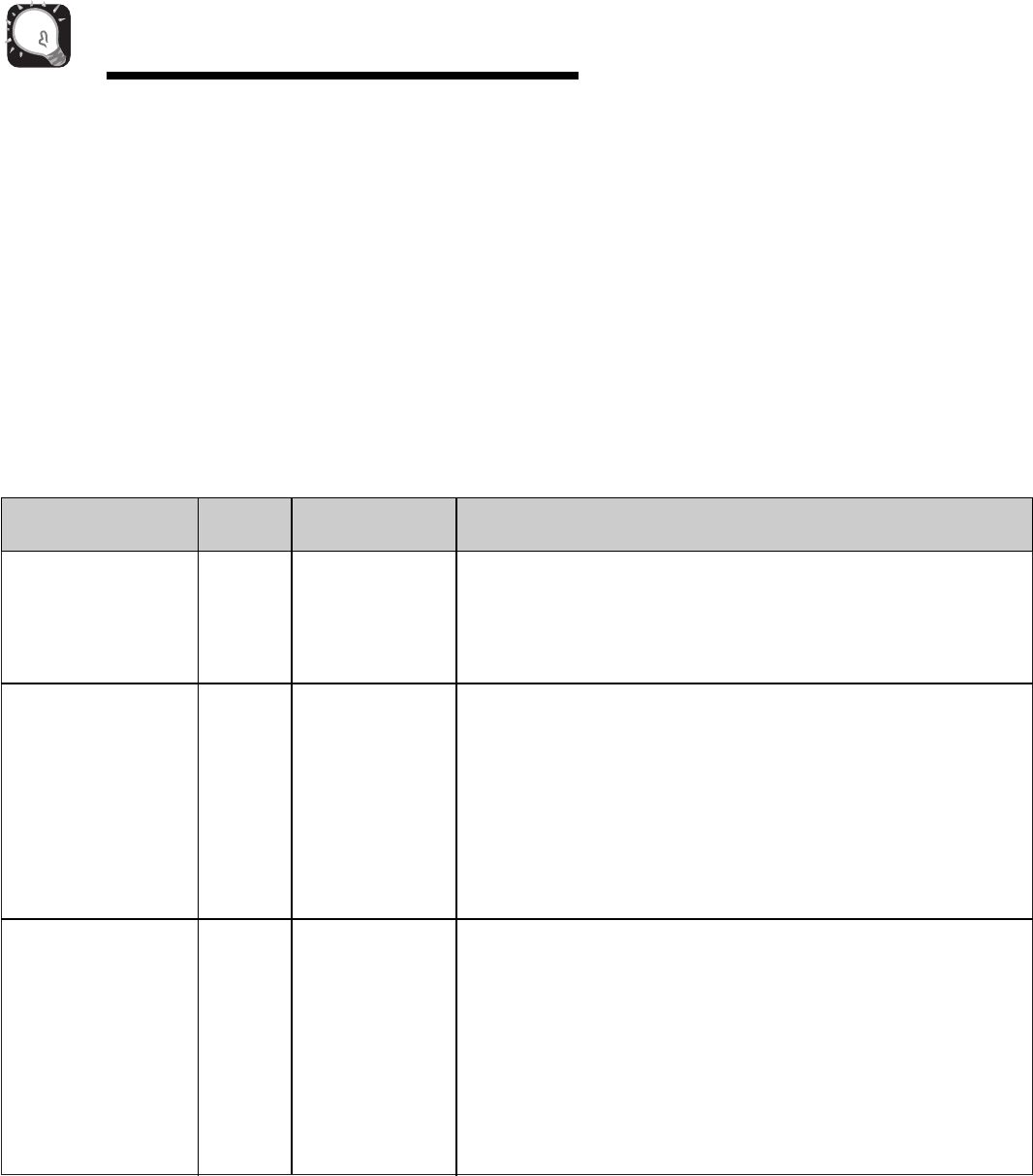
19
Operating Instructions
POULTRY
Cooking Poultry: General Directions
●Prepare the poultry for cooking.
- Defrost completely.
- Arrange poultry pieces with thicker pieces at the outside
edge of the baking dish. When cooking legs, arrange
them like the spokes of a wheel.
- Cover the baking dish with waxed paper to reduce
spattering.
- Use a browning agent or cook with a sauce to give a
browned appearance.
●Watch the poultry as it cooks.
- Drain and discard juices as they accumulate.
- Shield thin or bony pieces with small strips of aluminum
foil to prevent overcooking. Keep foil at least 1 inch
from the oven walls and other pieces of foil.
●Poultry is done when it is no longer pink and the juices
run clear. When done, the temperature in the thigh meat
should be 180-185°F.
●Let the poultry stand after cooking covered with foil for
10 minutes.
The Poultry Cooking Table below provides detailed
directions, Power Level, and Cooking Time settings for
most cuts and types of poultry.
POULTRY COOKING TABLE
POULTRY
Chicken pieces
(21/2-3 lbs.)
Chicken whole
(3-31/2lbs.)
Cornish Hens
whole
(1-11/2lbs. each)
HI
HI
HI
41/2-51/2minutes
per pound
12-13 minutes
per pound
6-7 minutes
per pound
Before cooking, wash pieces and shake the water off.
Place pieces in a single layer in a microwavable baking
dish with thicker pieces to the outside. Brush with butter or
browning agent and seasonings if desired. Cover with
waxed paper. Cook until no longer pink and juices run
clear. Let stand covered 5 minutes.
Before cooking, wash and shake off water. Place breast
side down on a microwavable roasting rack. Brush with
butter, or browning agent and seasoning if desired. Cover
with waxed paper. Cook 1/3of estimated time. Turn breast
side up, brush with butter, or browning agent. Replace
waxed paper. Cook 1/3of estimated time again. Shield if
necessary. Cook remaining 1/3of estimated time or until no
longer pink and juices run clear. Let stand covered with foil
10 minutes. (The temperature may rise about 10°F.) The
temperature in the thigh should be 180°F-185°F when
the poultry is done.
Before cooking, wash and shake the water off.
Tie wings to body of hen and the legs to tail. Place hens
breast side down on microwavable rack. Cover with waxed
paper. Turn breast side up halfway through cooking. Shield
bone ends of drumsticks with foil.
Remove and discard drippings. Brush with butter or
browning agent and seasonings if desired. Cook until
no longer pink and juices run clear. Remove hens from
microwave when they reach desired temperature.
Let stand covered with foil 5 minutes. (Temperature may
rise about 10°F). Temperature in breast should be 170°F
before serving.
POWER
LEVEL COOKING
TIME DIRECTIONS
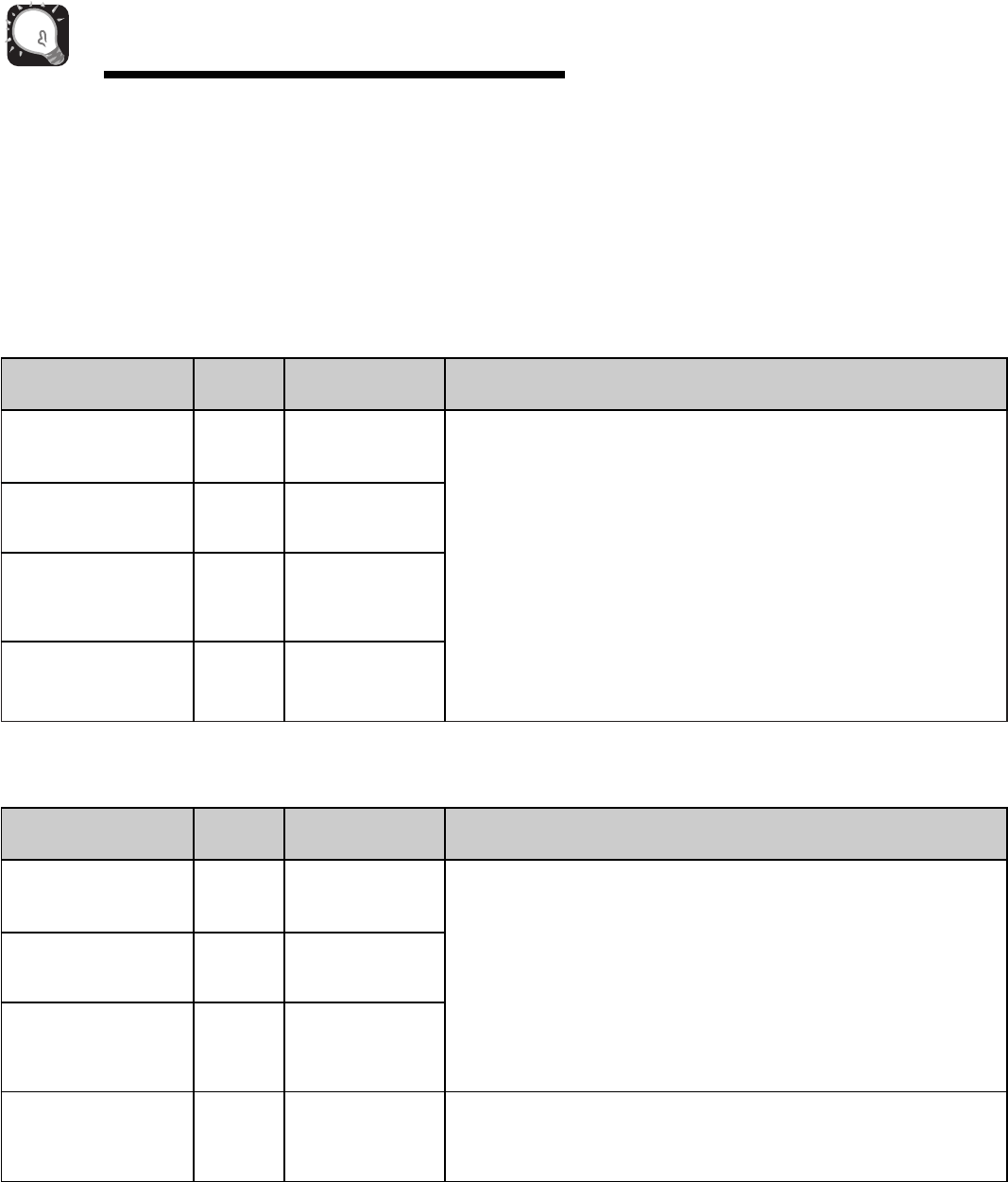
20
Operating Instructions
PASTA AND RICE
Microwave cooking and conventional cooking of pasta,
rice, and cereal require about the same amount of time,
but the microwave is a more convenient method because
you can cook and serve in the same dish. There is no
stirring needed and leftover pasta tastes just like fresh
cooked when reheated in the microwave oven.
Cooking Pasta and Rice: Tips and Techniques
●If you are planning to use rice or pasta in a casserole,
undercook it so it is still firm.
●Allow for standing time with rice, but not for pasta.
●The Pasta and Rice Cooking Tables below provide
specific directions, with Power Level and cooking time
settings for most common types of pasta and rice.
PASTA COOKING TABLE
PASTA
Spaghetti
4 cups water
Add 8 ozs. spaghetti
Macaroni
3 cups water
Add 2 cups macaroni
Lasagna noodles
4 cups water
Add 8 ozs. lasagna
noodles
Egg noodles
6 cups water
Add 4 cups noodles
HI
5
HI
5
HI
5
HI
5
9-10 minutes
71/2-81/2minutes
6-7 minutes
51/2-61/2minutes
7-8 minutes
11-121/2minutes
8-10 minutes
51/2-61/2minutes
Combine hot tap water and salt, if desired.
Use a 2-quart microwavable baking dish and cover with vented
plastic wrap for spaghetti and lasagna noodles.
Use microwavable lid or vented plastic wrap for macaroni
and egg noodles.
Cook as directed in chart or until water boils.
Stir in pasta; cook covered as directed in chart or until tender.
Drain in a colander.
POWER
LEVEL COOKING
TIME DIRECTIONS
RICE COOKING TABLE
RICE
Long grain
2¼ cups water
Add 1 cup rice
Brown
21/4cups water
Add 1 cup rice
Long grain and
wild rice mix
21/3cups water
Add 6 oz. package
Quick cooking
1 cup water
Add 1 cup rice
HI
3
HI
3
HI
3
HI
5-7 minutes
19 minutes
41/2-51/2minutes
28 minutes
4-5 minutes
24 minutes
2-3 minutes
Combine hot tap water and salt, if desired, in 2 quart
microwavable casserole.
Cover with microwavable lid or vented plastic wrap.
Cook as directed in chart or until water boils.
Stir in rice and any seasonings.
Cook covered as directed in chart or until water is absorbed
and rice is tender.
Let stand covered 5 to 10 minutes.
Fluff with fork.
Cook water until it boils.
Stir rice into boiling water and let stand, covered 5 to 10
minutes or until water is absorbed and rice is tender.
Fluff with fork.
POWER
LEVEL COOKING
TIME DIRECTIONS
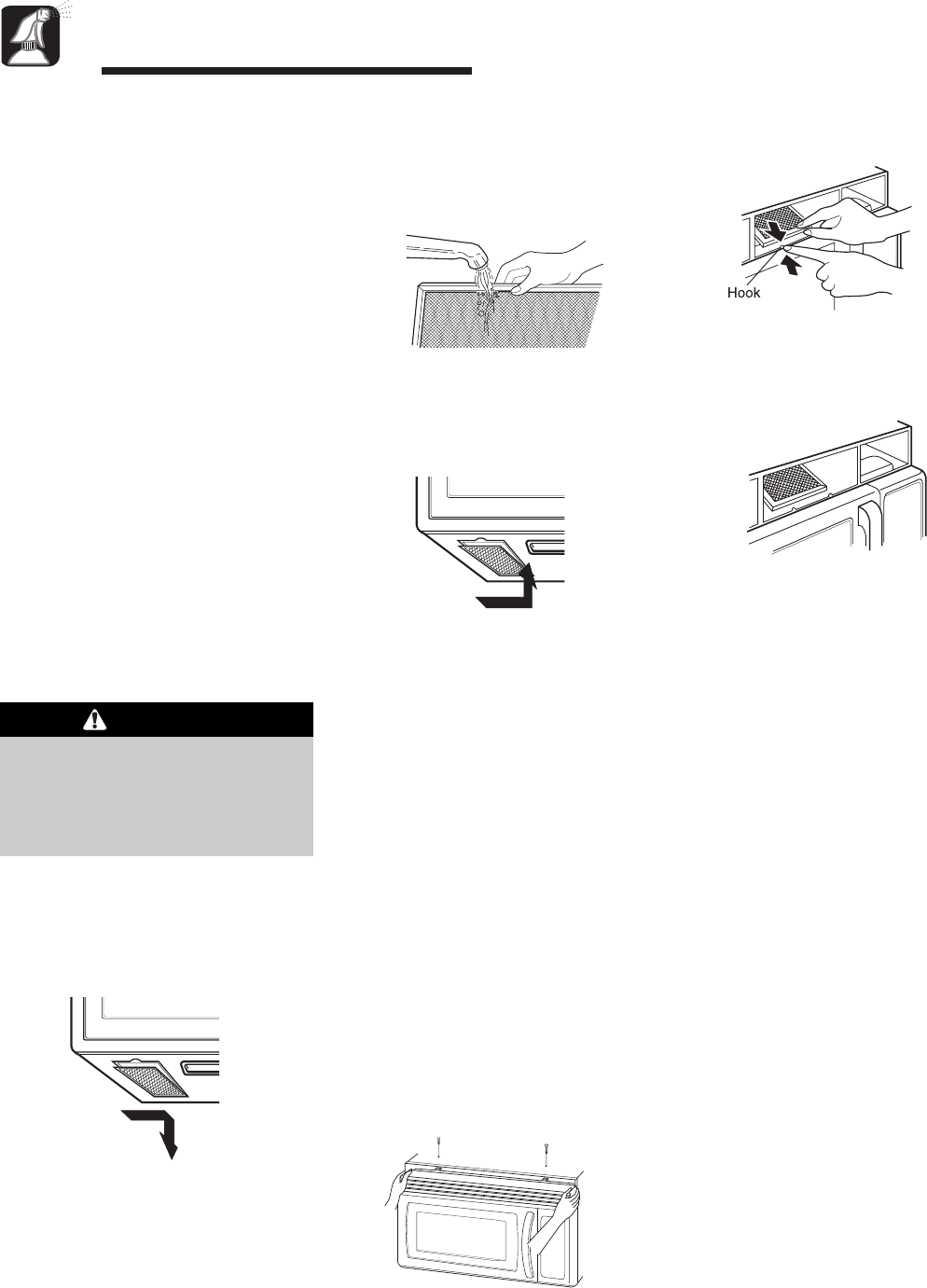
21
Care and Cleaning
CARE AND CLEANING
For best performance and safety,
keep the oven clean inside and out-
side. Take special care to keep the
inner door panel and the oven front
frame free of food or grease build-up.
Never use rough powder or pads.
Wipe the microwave oven inside and
out, including the hood bottom cover,
with a soft cloth and a warm (not hot)
mild detergent solution. Then rinse
and wipe dry. Use a chrome cleaner
and polish on chrome, metal and
aluminum surfaces. Wipe spatters
immediately with a wet paper towel,
especially after cooking chicken or
bacon. Clean your oven weekly or
more often, if needed.
CLEANING THE
GREASE FILTER
The grease filter should be removed
and cleaned often, at least once a
month.
1. To remove grease filter, slide filter
to the side. Pull filter downward
and push to the other side. The
filter will drop out.
2. Soak grease filter in hot water and
a mild detergent. Rinse well and
shake to dry. Do not use ammonia
or place in a dishwasher. The
aluminum will darken.
3. To reinstall the filter, slide it into
the side slot, then push up and
toward oven center to lock.
CHARCOAL FILTER
REPLACEMENT
If your oven is vented inside, the
charcoal filter should be replaced
every 6 to 12 months, and more
often if necessary. The charcoal filter
cannot be cleaned. To order a new
charcoal filter, contact the Parts
Department at your nearest
Authorized Service Center or call
1-800-843-0304 (inside U.S.A) or
1-866-587-2002 (Canada). Order
Charcoal Filter kit #: MVHRK4.
1. Unplug oven or turn off power at
the main power supply.
2. Remove the two vent grille
mounting screws. (2 middle
screws)
3. Tip the grille forward, then lift it
out.
4. Open the door.
5. Push the hook and remove old
filter.
6. Slide a new charcoal filter into
place and close the door. The fil-
ter should rest at the angle shown.
7. Slide the bottom of the vent cover
into place. Push the top until it
snaps into place. Replace the
mounting screws. Turn the power
back on at the main power supply
and set the clock.
To avoid risk of personal injury
or property damage, do not
operate oven hood without
filters in place.
CAUTION
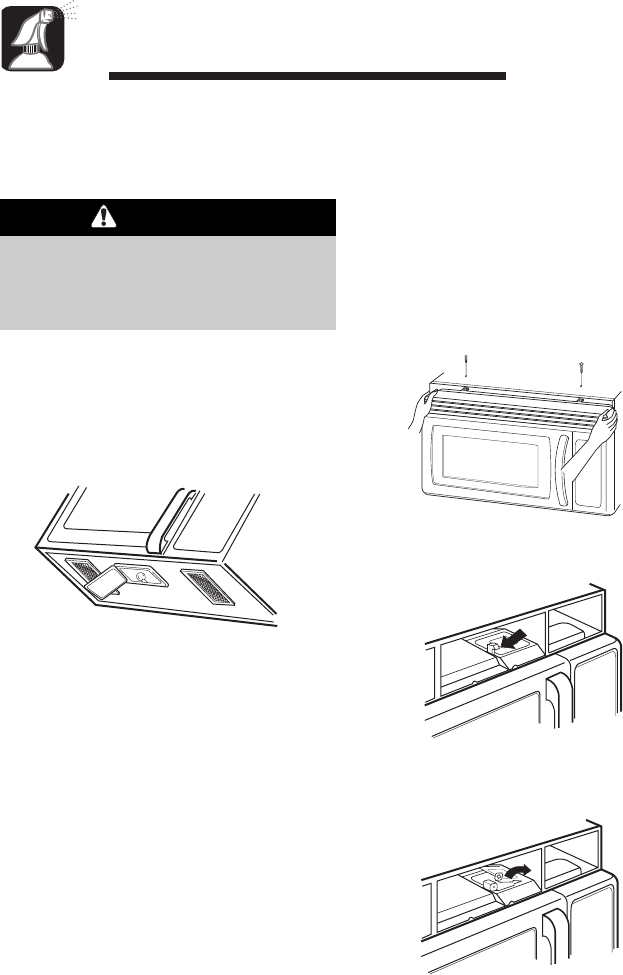
22
Care and Cleaning
COOKTOP/NIGHT LIGHT
REPLACEMENT
1. Unplug the oven or turn off power
at the main power supply.
2. Remove the bulb cover mounting
screws.
3. Replace bulb with 30 or 40 watt
appliance bulb.
4. Replace bulb cover, and mounting
screws.
5. Turn the power back on at the
main power supply.
OVEN LIGHT
REPLACEMENT
1. Unplug oven or turn off power at
the main power supply.
2. Remove the vent cover mounting
screws. (2 middle screws)
3. Tip the cover forward, then lift out
to remove.
4. Lift up the bulb holder.
5. Remove bulb holder.
6. Replace bulb with a 30 or 40 watt
appliance bulb.
7. Replace the bulb holder.
8. Slide the bottom of the vent cover
into place. Push the top until it
snaps into place. Replace the
mounting screws. Turn the power
back on at the main power supply.
To avoid personal injury or
property damage, wear gloves
when replacing light bulb.
CAUTION

23
Cooking Utensils
MICROWAVE UTENSIL GUIDE
USE
OVENPROOF GLASS (treated for
high intensity heat):
Utility dishes, loaf dishes, pie
plates, cake plates, liquid
measuring cups, casseroles and
bowls without metallic trim.
CHINA:
Bowls, cups, serving plates and
platters without metallic trim.
PLASTIC:
Plastic wrap (as a cover)-- lay
the plastic wrap loosely over the
dish and press it to the sides.
Vent plastic wrap by turning back
one edge slightly to allow excess
steam to escape. The dish
should be deep enough so that
the plastic wrap will not touch the
food.
As the food heats it may melt the
plastic wrap wherever the wrap
touches the food.
Use plastic dishes, cups,
semirigid freezer containers and
plastic bags only for short
cooking times. Use these with
care because the plastic may
soften from the heat of the
food.
PAPER:
Paper towels, waxed paper,
paper napkins, and paper plates
with no metallic trim or design.
Look for the manufacturer's label
for use in the microwave oven.
DO NOT USE
METAL UTENSILS:
Metal shields the food from microwave energy and produces uneven
cooking. Also avoid metal skewers, thermometers or foil trays. Metal
utensils can cause arcing, which can damage your microwave oven.
METAL DECORATION:
Metal-trimmed or metal-banded dinnerware, casserole dishes, etc. The
metal trim interferes with normal cooking and may damage the oven.
ALUMINUM FOIL:
Avoid large sheets of aluminum foil because they hinder cooking and
may cause harmful arcing. Use small pieces of foil to shield poultry legs
and wings. Keep ALL aluminum foil at least 1 inch from the side walls
and door of the oven.
WOOD:
Wooden bowls and boards will dry out and may split or crack when you
use them in the microwave oven. Baskets react in the same way.
TIGHTLY COVERED UTENSILS:
Be sure to leave openings for steam to escape from covered utensils.
Pierce plastic pouches of vegetables or other food items before cooking.
Tightly closed pouches could explode.
BROWN PAPER:
Avoid using brown paper bags.
They absorb too much heat and could burn.
FLAWED OR CHIPPED UTENSILS:
Any utensil that is cracked, flawed, or chipped may break in the oven.
METAL TWIST TIES:
Remove metal twist ties from plastic or paper bags.
They become hot and could cause a fire.
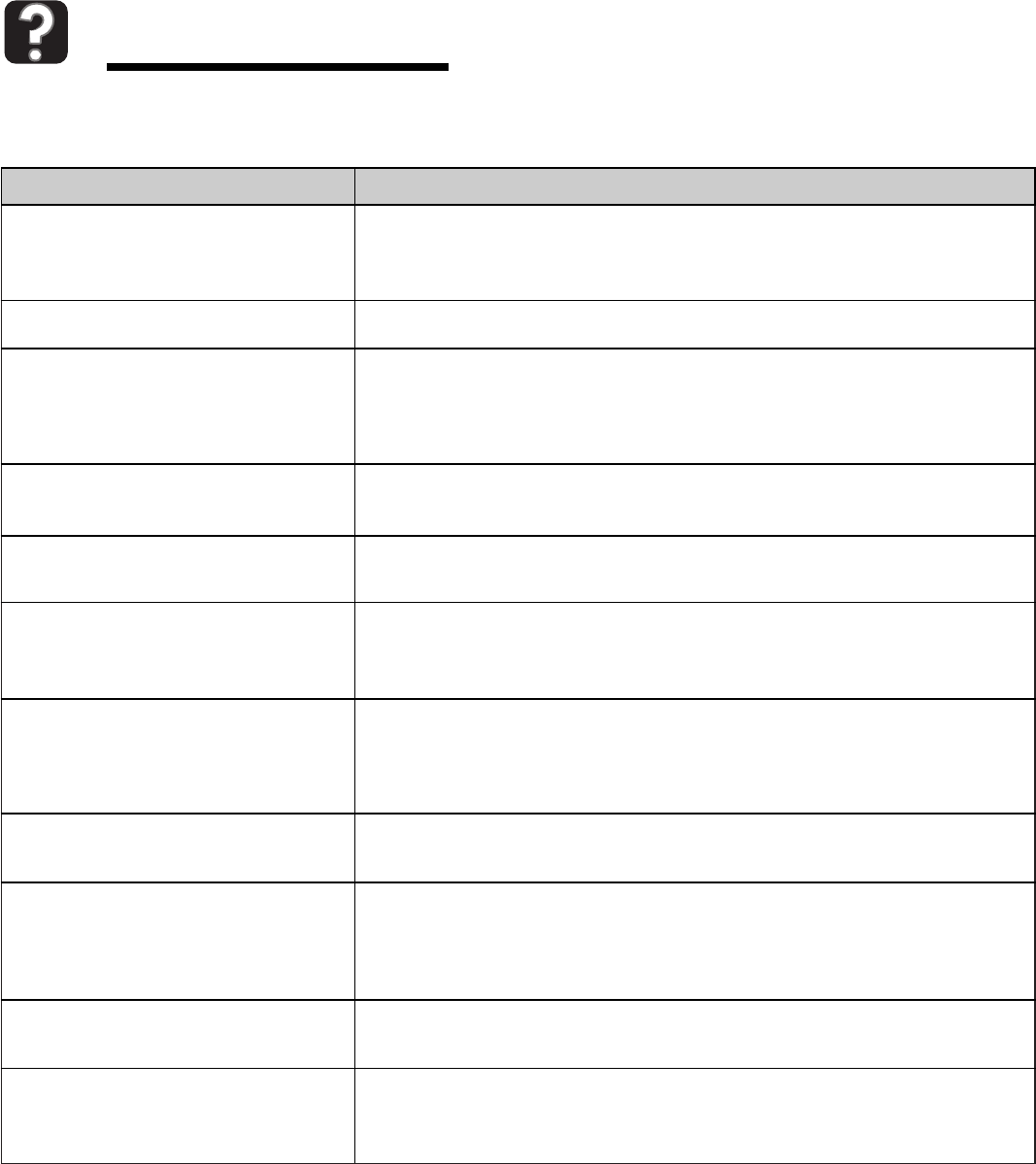
24
Troubleshooting
PROBLEM
If nothing on the oven operates
If the oven interior light does not work
If oven will not cook
If oven takes longer than normal to
cook or cooks too rapidly
If the time of day clock does not
always keep correct time
If food cooks unevenly
If food is undercooked
If food is overcooked
If arcing (sparks) occur
If the display shows a time counting
down but the oven is not cooking
Vent fan starts automatically
POSSIBLE CAUSES
●
check for a blown circuit fuse or a tripped main circuit breaker.
●
check if oven is properly connected to electric circuit in house.
●
check that controls are set properly.
●
the light bulb is loose or defective.
●
check that control panel was programmed correctly.
●
check that door is firmly closed.
●
check that Enter/Start Pad was touched.
●
check that timer wasn’t started instead of a cooking function.
●
be sure the Power Level is programmed properly.
●
check that the power cord is fully inserted into the outlet receptacle.
●
be sure the oven is the only appliance on the electrical circuit.
●
be sure food is evenly shaped.
●
be sure food is completely defrosted before cooking.
●
check placement of aluminum foil strips used to prevent overcooking.
●
check recipe to be sure all directions (amount, time, and power levels) were
correctly followed.
●
be sure microwave oven is on a separate circuit.
●
be sure food is completely defrosted before cooking.
●
check recipe to be sure all directions (amount, power level, time, size of dish)
were followed.
●
be sure microwavable dishes were used.
●
be sure wire twist ties were not used.
●
be sure oven was not operated when empty.
●
make sure metal rack (if used) is properly installed on 4 supports.
●
check that door is firmly closed.
●
check that timer was not started instead of a cooking function.
●
If the temperature gets too hot around the microwave oven, the fan in the vent
hood will automatically turn on at the HI setting to cool the oven. It may stay
on up to an hour to cool the oven.
Check the following list to be sure a service call is necessary. Reviewing additional information on items to check may
prevent an unneeded service call.
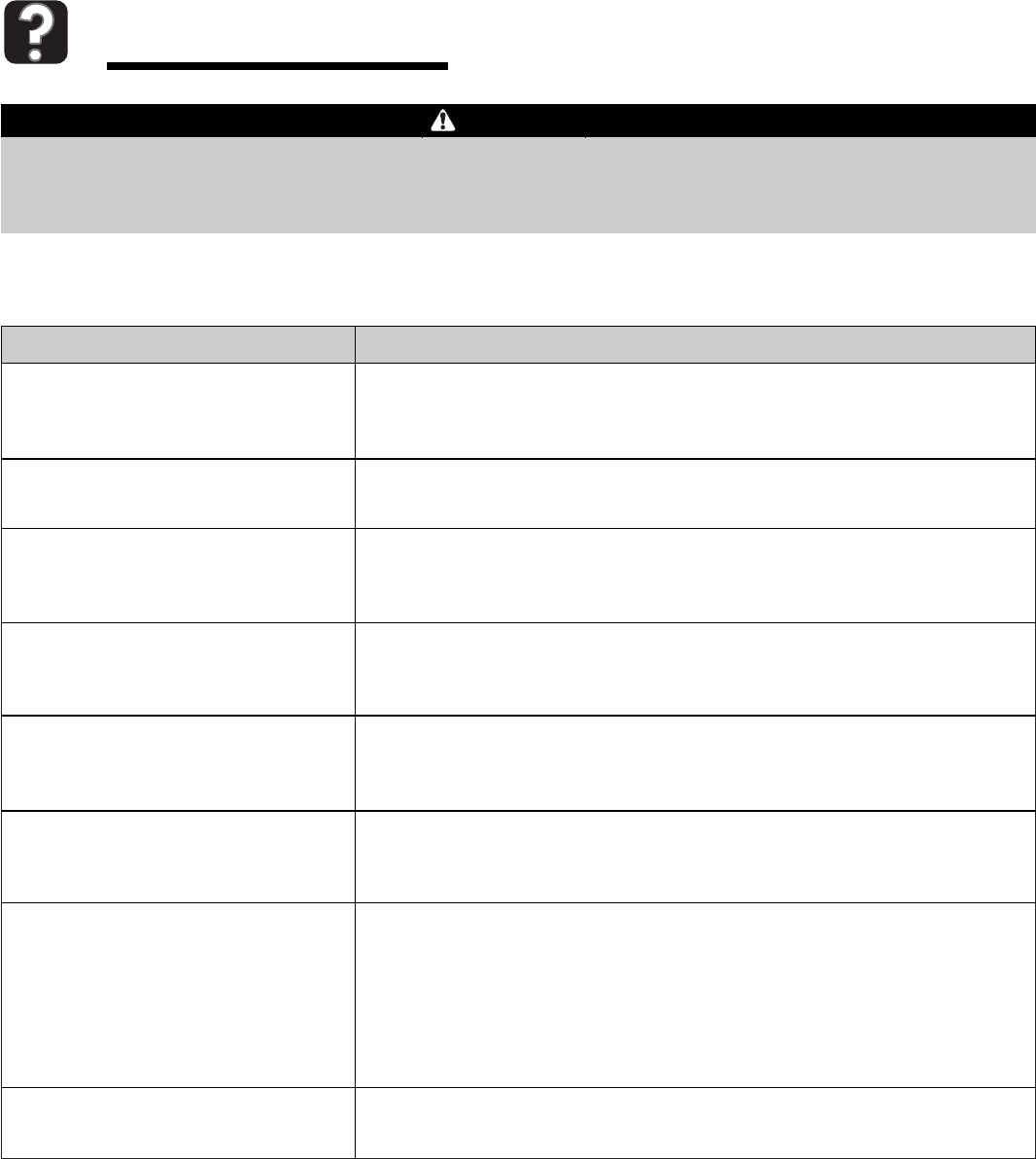
25
Troubleshooting
To avoid electrical shock which can cause severe personal injury or death, do not remove outer case at any time,
only an authorized servicer should remove outer case.
QUESTION
Can I use a rack in my microwave
oven so that I may reheat or cook in
two rack positions at a time?
Can I use either metal or aluminum
pans in my microwave oven?
Sometimes the door of my microwave
oven appears wavy.
Is this normal?
What are the humming noises I hear
when my microwave oven is
operating?
Why does the dish become hot when I
microwave food in it?
What does standing time mean?
Can I pop popcorn in my microwave
oven?
How do I get the best results?
Why does steam come out of the air
exhaust vent?
ANSWER
Only use the rack that is supplied with your microwave oven.
Use of any other rack can result in poor cooking performance and/or arcing
and may damage your oven.
Usable metal includes aluminum foil for shielding (use small, flat pieces).
Never allow metal to touch walls or door.
This appearance is normal and does not affect the operation of your oven.
This is the sound of the transformer when the magnetron tube cycles on and off.
As the food becomes hot it will conduct the heat to the dish.
Use hot pads to remove food after cooking.
Dish may not be microwave safe.
Standing time means that food should be taken out of the oven and covered
for additional time after cooking. This process allows the cooking to finish,
saves energy, and frees the oven for other purposes.
Yes. Pop packaged microwave popcorn following manufacturer’s guidelines or
use the preprogrammed Popcorn pad.
Do not use regular paper bags. Use the listening test by stopping the oven as
soon as the popping slows to a pop every one or two seconds. Do not try to
repop unpopped kernels. You can also use special microwave poppers. When
using a popper, be sure to follow manufacturer’s directions. Do not pop
popcorn in glass utensils.
Steam is normally produced during cooking.
The microwave oven has been designed to vent this steam out the vent.
QUESTIONS AND ANSWERS
WARNING

26
Warranty
Full One Year
Amana will repair or replace, including related labor, any part which proves defective as to workmanship or materials.
Limited Warranty
After one year from the date of original retail purchase, Amana will provide a free part, as listed below, to replace any
part that fails due to a defect in materials or workmanship. The owner will be responsible for paying all other costs
including labor, mileage, transportation, trip and diagnostic charges, if required.
Second through Fifth Year
Amana will provide replacement magnetron, touch pad and microprocessor, part and labor, which proves defective as to
workmanship or materials.
Limited Parts Warranty Outside the United States and Canada
For one (1) year from the date of original retail purchase, any part which fails in normal home use will be repaired or
replaced free of charge for the part itself, with the owner paying all other costs, including labor, mileage, transportation, trip
and diagnostic charges, if required.
Canadian Residents
This warranty covers only those appliances installed in Canada that have been listed with Canadian Standards
Association unless the appliances are brought into Canada due to transfer or residence from the United States to Canada.
What is not covered by these
warranties
●Replacement of household fuses, resetting of circuit
breakers, or correction to household wiring or plumbing.
●Normal product maintenance and cleaning, including
light bulbs.
●Products with original serial numbers removed, altered,
or not readily determined.
●Products purchased for commercial, industrial, rental, or
leased use.
●Products located outside of the United States or
Canada.
●Premium service charges, if the servicer is requested to
perform service in addition to normal service or outside
normal service hours or area.
●Adjustments after the first year.
●Repairs resulting from the following:
- Improper installation, exhaust system, or maintenance.
- Any modification, alteration, or adjustment not
authorized by the manufacturer.
- Accident, misuse, abuse, fire, flood, or acts of nature.
- Connections to improper electrical current, voltage
supply, or gas supply.
- Use of improper pans, containers, or accessories that
cause damage to the product.
●Travel.
If you need service
■
Call the dealer from whom your appliance was pur-
chased or call Maytag ServicesSM, Amana Customer
Assistance at 1-800-843-0304, USA or 1-866-587-2002
Canada to locate an authorized servicer.
■
Be sure to retain proof of purchase to verify warranty
status. Refer to WARRANTY for further information on
owner’s responsibilities for warranty service.
■
If the dealer or service company cannot resolve the
problem, write to Maytag ServicesSM, Attn: CAIR®Center
P.O. Box 2370, Cleveland, TN 37320-2370, or call
1-800-843-0304 U.S.A. or 1-866-587-2002 Canada.
■
User’s guides, service manuals and parts information are
available from Maytag ServicesSM, Amana Customer
Assistance.
IN NO EVENT SHALL MAYTAG BE LIABLE FOR INCIDENTAL OR CONSEQUENTIAL DAMAGES.
This warranty gives you specific legal rights, and you may have others which vary from state to state. For example, some
states do not allow the exclusion or limitation of incidental or consequential damages, so this exclusion may not apply to you.
NOTE:
●When writing or calling about a service problem, please
include the following information:
a. Your name, address and telephone number;
b. Model number and serial number;
c. Name and address of your dealer or servicer;
d. A clear description of the problem you are having;
e. Proof of purchase (sales receipt).
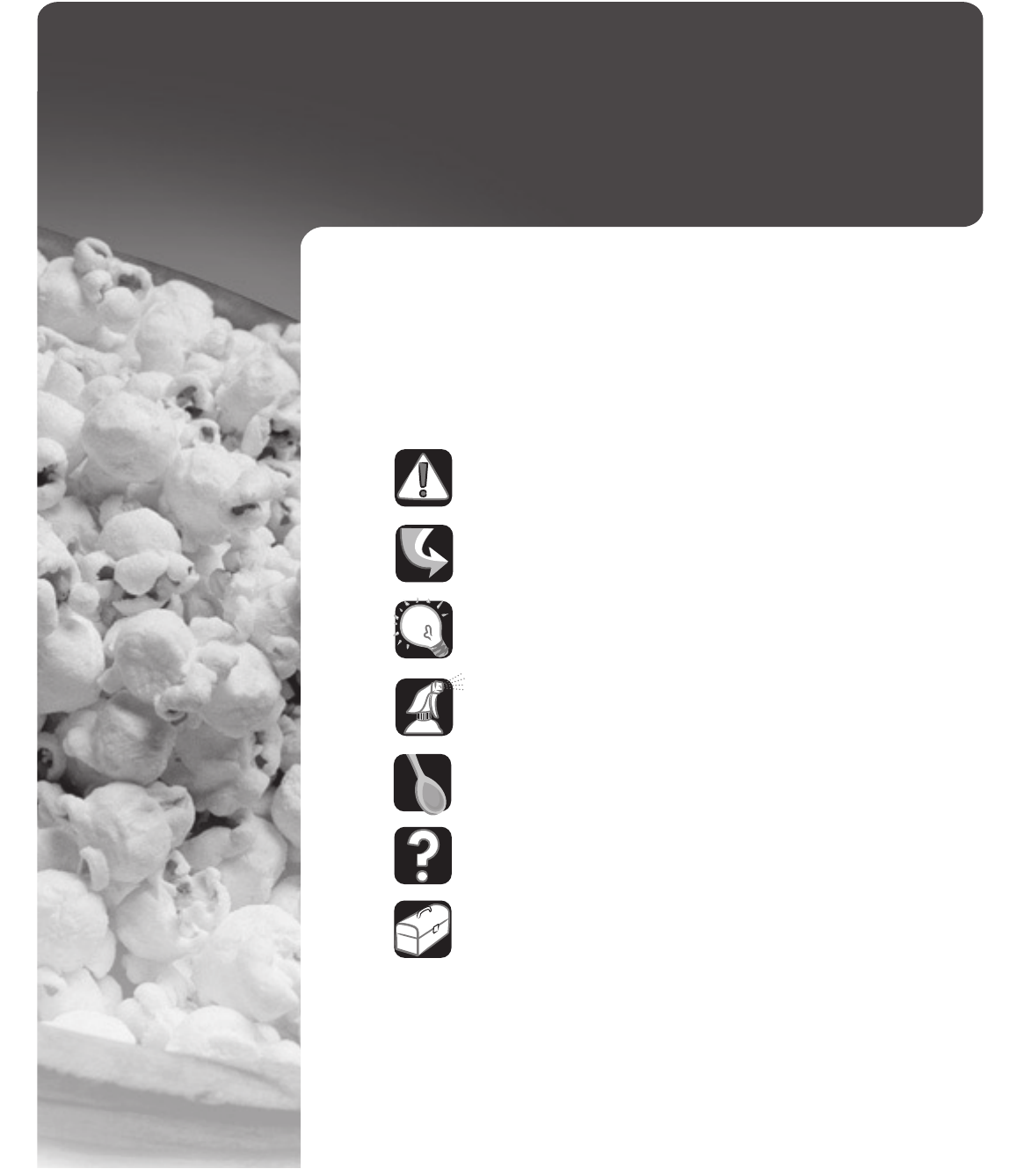
Conserver ces instructions comme références.
Ce guide doit être rangé près du four.
Four à micro-ondes
à hotte intégrée
Guide d’utilisation et d’entretien
Modèle AMV5164AA/AC
Instructions de sécurité importantes .... 28-30
Caractéristiques ......................................... 31-32
Utilisation .................................................... 33-46
Entretien et nettoyage............................... 47-48
Ustensiles recommandés............................... 49
Guide de dépannage................................. 50-51
Garantie.............................................................. 52
Guía de Uso y Cuidado.................................... 53

AVERTISSEMENT
AVERTISSEMENT – risques ou pratiques non sûres, qui
POURRAIENT résulter en de graves blessures ou même la mort.
28
Instructions de sécurité importantes
Installateur : Remettre ce guide au propriétaire.
Consommateur : Lire le manuel et le conserver comme
référence.
Conserver la facture d’achat ou le chèque encaissé comme
preuve de l’achat.
Numéro de modèle ________________________________
Numéro de série___________________________________
Date d’achat ______________________________________
Dans le cadre de nos pratiques d’amélioration constante de
la qualité et de la performance de nos appareils, des
modifications de l’appareil qui ne sont pas mentionnées
dans ce manuel ont pu être introduites.
Pour toute question, nous écrire ou nous contacter (indiquer
le numéro de modèle et le numéro de téléphone) à :
Maytag Services
SM
Attn: CAIR
®
Center
P.O. Box 2370
Cleveland, TN 37320-2370
1-800-843-0304 (É.-U)
1-866-587-2002 (Canada)
(Lundi - vendredi, 8 h - 20 h - heure de I’Est)
Internet: http://www.amana.com
Ce qu'il faut savoir sur les
instructions de sécurité
Les instructions de sécurité importantes et les avertissements
paraissant dans ce guide ne sont pas destinés à couvrir
toutes les situations et conditions éventuelles qui peuvent se
présenter. Il faut faire preuve de bon sens et de prudence lors de
l’installation, de l’entretien ou de l’utilisation d’un four à micro-
ondes.
Toujours prendre contact avec le détaillant, le distributeur, l'agent
de service ou le fabricant, au sujet de problèmes ou conditions
que l'on ne comprend pas.
Reconnaître les étiquettes, phrases ou
symboles sur la sécurité
DANGER – risques immédiats qui RÉSULTERONT en de
graves blessures ou même la mort.
ATTENTION
ATTENTION
Pour éviter blessures ou dommages matériels, observer les
précautions suivantes :
1. Ne pas faire frire à grande friture dans le four à micro-
ondes. La graisse pourrait surchauffer et présenter un
risque à manipuler.
2. Ne pas faire cuire ou réchauffer des œufs dans leur
coquille ou avec un jaune entier dans un four à micro-
ondes. La pression pourrait s’accumuler et faire exploser
l’œuf. Percer le jaune d’œuf à l’aide d’une fourchette ou
d’un couteau avant de le faire cuire.
3. Percer la peau des pommes de terre, tomates et aliments
semblables avant de les faire cuire au four à micro-
ondes. Lorsque la peau est percée, la vapeur s’échappe
uniformément.
4. Ne pas faire fonctionner le four sans aliment présent
dans la cavité.
5. N’utiliser que du maïs à éclater dans des emballages
prévus pour être utilisés dans un four à micro-ondes. La
durée de préparation varie selon la puissance du four. Ne
pas continuer à chauffer si l’éclatement du maïs est
terminé. Le maïs risquerait de brûler ou de se ratatiner.
Ne pas laisser le four sans surveillance.
6. Ne pas utiliser de thermomètre à cuisson standard dans
le four à micro-ondes. La plupart des thermomètres
contiennent du mercure, ce qui peut entraîner la
formation d’un arc électrique, le mauvais fonctionnement
ou encore l’endommagement du four.
7. Ne pas utiliser d’ustensile métallique dans le four.
8. Ne pas utiliser de papier, plastique ou autres matériaux
combustibles non prévus pour la cuisson.
9. Lors de la cuisson avec du papier, plastique ou autres
matériaux combustibles, suivre les recommandations du
fabricant sur l’utilisation du produit.
10. Ne pas utiliser de papier essuie-tout qui contient du nylon
ou autres fibres synthétiques. Les matériaux synthétiques
chauffés pourraient fondre et faire s’enflammer le papier.
11. Ne pas faire chauffer dans le four de sac plastique ou
contenant fermé. Le liquide ou l’aliment pourrait se dilater
rapidement et faire casser le sachet ou le contenant.
Percer ou ouvrir le contenant ou le sachet avant de le
faire chauffer aux micro-ondes.
12. Pour éviter le mauvais fonctionnement d’un stimulateur
cardiaque, consulter un médecin ou le fabricant de ce
stimulateur pour connaître les effets potentiels de
l’énergie des micro-ondes sur celui-ci.
DANGER
ATTENTION – risques ou pratiques non sûres qui POURRAIENT
résulter en blessures mineures.
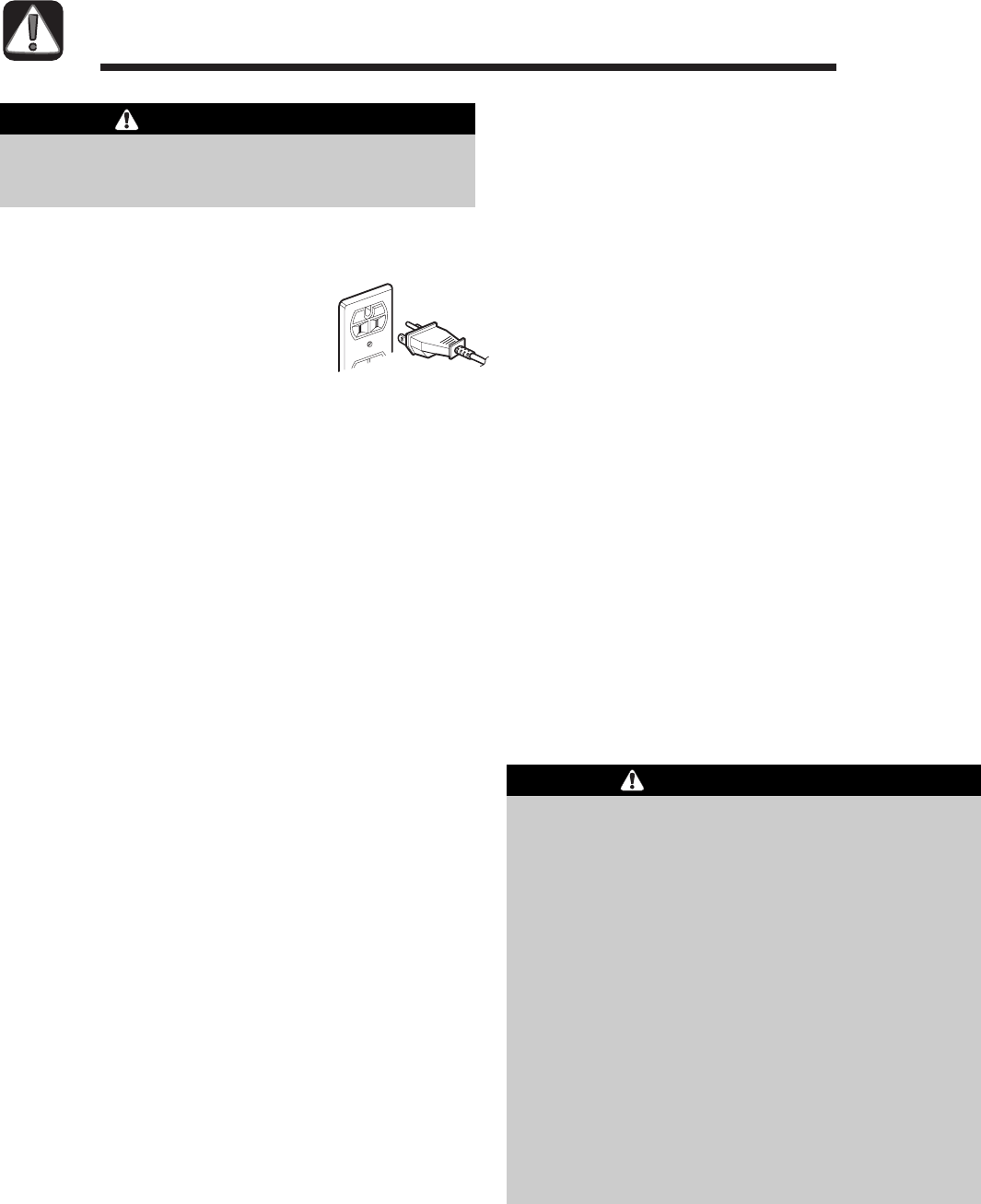
29
Instructions de sécurité importantes
Pour éviter tout risque de choc électrique ou même la mort,
ce four doit être mis à la terre et sa fiche ne doit pas être
modifiée.
Les liquides comme eau, café ou thé peuvent surchauffer
au-delà du point d’ébullition sans paraître bouillir, en raison
de la tension superficielle du liquide. Lorsque le contenant
est retiré du four à micro-ondes, il n’y a pas toujours
présence d’ébullition ou de bulles visibles. CECI PEUT
ENTRAÎNER L’ÉBULLITION SOUDAINE ET LA
PROJECTION DE LIQUIDES TRÈS CHAUDS
LORSQU’UNE CUILLÈRE OU AUTRE USTENSILE EST
PLACÉ DANS LE LIQUIDE. Pour réduire le risque de
blessures :
1. Ne pas surchauffer le liquide.
2. Remuer le liquide avant de le faire chauffer et au milieu du
temps de chauffage.
3. Ne pas utiliser de contenants à côtés rectilignes avec
goulots étroits.
4. Après le chauffage, prévoir un temps d’attente et laisser le
contenant dans le four à micro-ondes avant de l’en retirer.
5. User de prudence en mettant une cuillère ou autre
ustensile dans le contenant.
Instructions de liaison à la terre
lI FAUT que ce four soit relié à la terre.
La liaison à la terre permet l’évacuation du
courant vers la terre, ce qui réduit le risque
de choc électrique. Ce four est doté d’un
cordon avec fiche de branchement à trois
broches, pour liaison à la terre. On doit brancher la fiche sur
une prise de courant convenablement installée et reliée à la
terre. Voir les instructions d'installation.
En cas de non-compréhension des instructions de liaison à la
terre ou en cas d’incertitude quant à la qualité de la liaison à la
terre de l’appareil, consulter un technicien ou électricien
qualifié.
Ne pas utiliser de rallonge électrique. Si le cordon de
l’appareil est trop court, faire installer une prise de courant à
trois alvéoles. Ce four doit être branché sur un circuit
indépendant de 60 hertz aux caractéristiques nominales
indiquées dans le tableau des spécifications. Si le four est
branché sur le même circuit qu’un autre équipement, il pourrait
en résulter une augmentation des durées de cuisson avec
risque que les fusibles ne grillent. Le four à micro-ondes
fonctionne sur un courant domestique standard de 110-120 V.
Énoncé sur les interférences avec les
fréquences radio – Commission
fédérale des communications
(É.-U. seulement)
Ce four à micro-ondes génère de l’énergie à des fréquences
élevées; s’il n’est pas installé et utilisé correctement, c’est-à-
dire en stricte conformité avec les instructions du fabricant, le
four peut susciter des interférences perturbant la réception des
ondes de radio et télévision. Cet appareil a été testé et il a été
trouvé conforme aux limites imposées par les spécifications de
la partie 18 des règlements de la Commission fédérale des
communications (FCC) – portant sur les équipements ISM, et
qui sont conçus pour offrir une protection raisonnable à de
telles interférences dans une installation résidentielle.
Cependant, il n’y a aucune garantie qu’aucune interférence ne
se produira dans une installation en particulier. Si cet
équipement n’entraîne pas d’interférence avec la réception des
ondes de radio et de télévision (effet qui peut être diagnostiqué
par l’arrêt puis la mise en marche de l’équipement), l’utilisateur
est encouragé à essayer de corriger la situation au moyen
d’une ou de plusieurs des mesures suivantes :
• Réorienter l’antenne de réception de télévision ou de radio.
• Modifier la position du four à micro-ondes par rapport au
récepteur de radio ou de télévision.
• Éloigner le four à micro-ondes du récepteur.
• Brancher le four à micro-ondes dans une prise différente de
sorte que le four à micro-ondes et le récepteur soient
alimentés par des circuits différents.
Le fabricant n’est pas responsable des interférences aux
ondes de radio et de télévision causées par une modification
non autorisée du four à micro-ondes. Il revient à l’utilisateur
d’éliminer de telles interférences.
Précautions à observer pour éviter une
exposition excessive à l'énergie des
micro-ondes
A. NE PAS tenter de faire fonctionner ce four lorsque la porte
est ouverte; le fonctionnement du four lorsque la porte est
ouverte pourrait susciter une exposition dangereuse à
l’énergie des micro-ondes. Il est important de ne pas
circonvenir ou modifier les dispositifs d’interverrouillage de
sécurité.
B. Veiller à NE placer AUCUN objet entre la face avant du four
et la porte, et à NE PAS laisser des souillures ou résidus de
produits de nettoyage s’accumuler sur les surfaces de
contact porte/châssis.
C. NE PAS faire fonctionner le four s’il est endommagé. Il est
particulièrement important que la porte du four puisse
fermer parfaitement et qu’il n’y ait aucune détérioration de :
1. porte (déformation),
2. charnières et loquets (brisés ou desserrés),
3. joints de porte et surfaces de contact.
D. Seul un personnel qualifié est habilité à exécuter des
réglages ou réparations sur le four à micro-ondes.
CONSERVER CES INSTRUCTIONS
AVERTISSEMENT
AVERTISSEMENT

30
Instructions de sécurité importantes
AVERTISSEMENT
10. NE PAS faire réchauffer de biberons dans le four.
11. NE PAS faire fonctionner ce four si le cordon ou la
fiche de branchement ont été endommagés, s’il ne
fonctionne pas correctement ou s’il a subi des
dommages ou une chute.
12. SEUL un technicien est habilité à exécuter des
travaux d’entretien sur cet appareil. Des outils
spéciaux sont nécessaires pour ce faire. Prendre
contact avec l’établissement de service agréé le plus
proche pour permettre l’inspection, la réparation ou le
réglage.
13. NE PAS recouvrir ou obstruer un filtre ou une
ouverture de l’appareil.
14. NE PAS remiser cet appareil à l’extérieur. NE PAS
l’utiliser à proximité d’eau, par exemple près d’un
évier de cuisine, dans un sous-sol humide ou à
proximité d’une piscine ou endroit semblable.
15. NE PAS immerger le cordon ou la fiche de
branchement dans de l’eau.
16. Maintenir le cordon d’alimentation À DISTANCE de
toute surface CHAUFFÉE.
17. NE PAS laisser le cordon d’alimentation pendre sur
le rebord d’une table ou d’un plan de travail.
18. Nettoyer fréquemment la hotte d’extraction.
19. NE PAS laisser la graisse s’accumuler sur la hotte
ou les filtres.
20. Procéder avec prudence lors du nettoyage du filtre
de la hotte d’extraction. Un produit de nettoyage
corrosif comme un nettoyant pour le four à base de
potasse, peut endommager le filtre.
21. Faire fonctionner le ventilateur, lors du flambage
d’aliments sous la hotte.
22. Peut être utilisé au-dessus d’un appareil de cuisson à
gaz ou électrique, de 36 po (91,44 cm) de largeur ou
moins.
ATTENTION
Pour réduire le risque de feu dans la cavité du four :
a. NE PAS cuire excessivement un aliment. Surveiller
attentivement l’appareil si on a placé un article en
papier, plastique ou autre matériau combustible dans
la cavité pour faciliter la cuisson.
b. Enlever les attaches métalliques des sachets en
papier ou en plastique avant de les placer dans le
four.
c. Advenant l’inflammation d’un article à l’intérieur du
four, maintenir la porte FERMÉE, arrêter le four et
débrancher le cordon d’alimentation, ou interrompre
l’alimentation du circuit au niveau du tableau de
fusibles ou de disjoncteurs.
d. NE RIEN remiser dans la cavité du four. NE PAS
placer des produits en papier, aliments ou ustensiles
de cuisine dans la cavité du four lorsqu’il n’est pas
utilisé.
CONSERVER CES INSTRUCTIONS
Lors de l’utilisation d’appareils électriques, des
précautions de sécurité de base doivent être suivies pour
réduire le risque de brûlure, choc électrique, incendie ou
blessure ainsi que le risque d’exposition excessive à
l’énergie des micro-ondes.
1. LIRE la totalité des instructions avant d’utiliser
l’appareil.
2. LIRE ET RESPECTER les instructions spécifiques
« PRÉCAUTIONS À OBSERVER POUR ÉVITER
UNE EXPOSITION EXCESSIVE À L’ÉNERGIE DES
MICRO-ONDES », page 29.
3. Installer l’appareil UNIQUEMENT conformément aux
instructions d’installation fournies dans ce guide.
4. Certains produits, comme œufs entiers et contenants
scellés, par exemple bocaux fermés, peuvent
exploser. Il NE FAUT PAS les faire CHAUFFER dans
ce four.
5. Utiliser cet appareil UNIQUEMENT dans les
applications prévues dans ce guide. Ne pas utiliser
dans cet appareil un produit émetteur de vapeur ou
composé chimique corrosif. Ce type de four est
spécifiquement conçu pour les opérations de
chauffage, cuisson ou dessiccation d’aliments. Il n’est
pas conçu pour une utilisation industrielle ou de
laboratoire.
6. Comme pour tout appareil ménager, il est nécessaire
de SUPERVISER ÉTROITEMENT les ENFANTS ou
PERSONNES INFIRMES lors de l’utilisation de
l’appareil.
7. Consulter les instructions de nettoyage données dans
la section Entretien et nettoyage du guide.
8. Les petits pots pour bébé doivent être ouverts
lorsqu’ils sont chauffés au four à micro-ondes, et leur
contenu mélangé ou agité avant d’être consommé,
pour éviter toute brûlure.
9. NE PAS utiliser ce four à des fins commerciales. Il
n’est destiné qu’à un usage domestique.
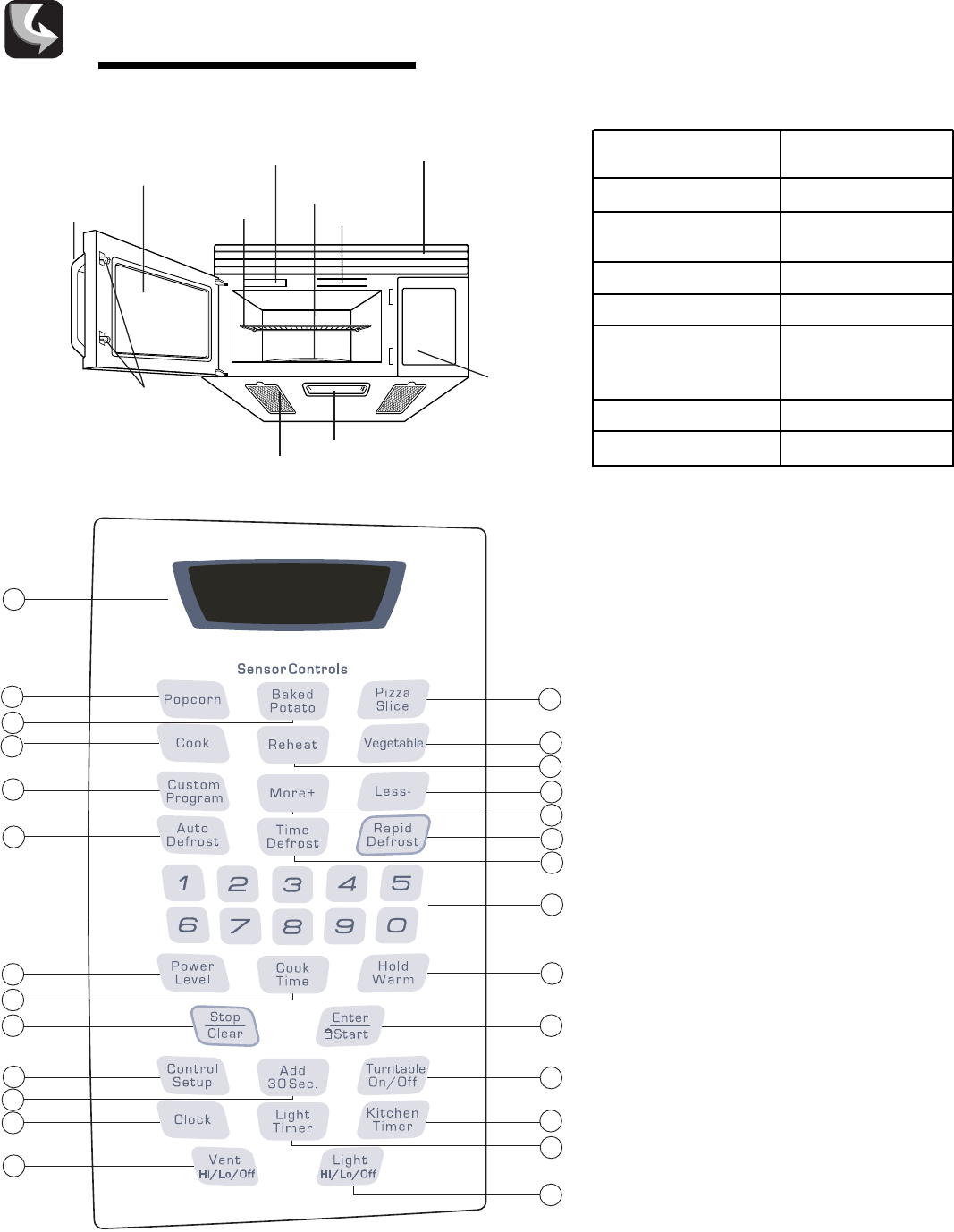
1
11
3
54
8
2
15
26
23
24
20
18
17
16
19
21 25
27
22
10
13
6
12
14
7
9
31
Caractéristiques
CARACTÉRISTIQUES
1. AFFICHEUR : L’afficheur inclut une
horloge et des indicateurs; ils affichent
l’heure, les durées de cuisson et les
fonctions de cuisson sélectionnées.
2. POPCORN (MAÏS À ÉCLATER) :
Appuyer sur cette touche pour
commander une opération
d’éclatement de maïs dans le four à
micro-ondes. La durée de chauffage
sera déterminée par le capteur en
fonction de la quantité d’humidité
émise par le maïs. Pour d’autres
informations, voir page 37.
3. BAKED POTATO (POMME DE
TERRE AU FOUR) : Appuyer sur
cette touche pour commander une
opération de cuisson de pomme de
terre. La durée de chauffage sera
déterminée par le capteur en fonction
de la quantité d’humidité émise par la
pomme de terre. Pour d’autres
informations, voir page 38.
4. REHEAT (RÉCHAUFFAGE) :
Appuyer sur cette touche pour
commander le réchauffage de divers
mets : mets en sauce, assiette de
dîner, soupe/sauce. La durée de
chauffage sera déterminée par le
capteur en fonction de la quantité
d’humidité émise par le mets. Pour
d’autres informations, voir
page 38.
SPÉCIFICATIONS DU FOUR
Alimentation électrique
Puissance absorbée
Puissance de cuisson
Fréquence
Demande de courant
Dimensions externes
(l x h x p)
Volume de la cavité
Poids net
120 VAC,
60 Hz
1 500 W
1 000 W
(Norme C.E.I. 60705)
2 450 MHz
13 A
29
15
/
16
po (76,0 cm)
x 16
7
/
16
po (41,8 cm)
x 15
3
/
8
po (39 cm)
1,6 pi
3
(0,045 m
3
)
52 lb (23,6 kg)
Poignée de
la porte
Plaque signalétique (numéro
de modèle et numéro de série)
Grille
métallique
Hublot avec
écran métallique Plateau tournant
en verre
Guide de cuisson
Grille d’évent
Tableau de
commande
Lampe d’éclairage
Filtre à graisse
Système de verrouillage
de sécurité

32
Caractéristiques
5. COOK (CUISSON) : Appuyer sur
cette touche pour commander la
cuisson de divers mets : mets
surgelé, mets en sauce ou riz. La
durée de chauffage sera déterminée
par le capteur en fonction de la
quantité d’humidité émise par le
mets. Pour d’autres informations, voir
page 38.
6. VEGETABLE (LÉGUMES) :
Appuyer sur cette touche pour
commander la cuisson de légumes.
La durée de chauffage sera
déterminée par le capteur en fonction
de la quantité d’humidité émise par
les légumes. Pour d’autres
informations, voir page 38.
7. PIZZA SLICE (PART DE PIZZA) :
Appuyer sur cette touche pour
commander le réchauffage d’une part
de pizza. La durée de chauffage sera
déterminée par le capteur en fonction
de la quantité d’humidité émise par la
part de pizza. Pour d’autres
informations, voir page 37.
8. CUSTOM PROGRAM
(PROGRAMME PERSONNALISÉ) :
Appuyer sur cette touche pour
commander l’exécution d’une
opération de cuisson antérieurement
programmée dans la mémoire de
l’appareil. Pour d’autres informations,
voir page 35.
9. MORE+ (PLUS+) : Appuyer sur cette
touche pour ajouter 10 secondes de
durée de cuisson (chaque pression).
Pour d’autres informations, voir
page 35.
10. LESS- (MOINS-) : Appuyer sur cette
touche pour réduire de 10 secondes
(chaque pression) la durée de
cuisson déjà programmée. Pour
d’autres informations, voir page 35.
11. AUTO DEFROST
(DÉCONGÉLATION
AUTOMATIQUE) : Pour viande,
volaille, poisson. Appuyer sur cette
touche pour sélectionner le type
d’aliment et commander la
décongélation en fonction du poids.
Pour d’autres informations, voir
page 40.
12. TIME DEFROST
(DÉCONGÉLATION MINUTÉE) :
Appuyer sur cette touche pour
commander la décongélation de la
plupart des autres aliments surgelés.
Pour d’autres informations, voir
page 41.
13. RAPID DEFROST
(DÉCONGÉLATION RAPIDE) :
Cette touche commande une
opération de décongélation RAPIDE
pour 1 lb (0,45 kg) d’aliments
surgelés. Pour d’autres informations,
voir page 41.
14. TOUCHES NUMÉRIQUES : Utiliser
les touches numériques pour entrer
les valeurs de durée de cuisson,
puissance de chauffage, quantité ou
poids.
15. POWER LEVEL (NIVEAU DE
PUISSANCE) : Appuyer sur cette
touche pour sélectionner le niveau de
puissance de chauffage.
16. COOK TIME (DURÉE DE
CUISSON) :Appuyer sur cette
touche pour définir une durée de
cuisson. Pour d’autres informations,
voir page 35.
17. HOLD WARM (MAINTIEN AU
CHAUD) : Appuyer sur cette touche
pour maintenir la température d’un
mets cuit dans le four à micro-ondes,
pendant une période qui peut
atteindre 99 minutes, 99 secondes.
Pour d’autres informations, voir
page 34.
18. STOP/CLEAR
(ARRÊT/EFFACEMENT) : Appuyer
sur cette touche pour arrêter le four
ou effacer toute l’information entrée.
19. ENTER/START (ENTRÉE/MISE EN
MARCHE) : Appuyer sur cette
touche pour commander l’exécution
d’une fonction. Si on ouvre la porte
du four après le déclenchement
d’une cuisson, appuyer de nouveau
sur ENTER /START pour reprendre
la cuisson.
20. CONTROL SETUP (SÉLECTION
DES PARAMÈTRES) : Appuyer sur
cette touche pour modifier les
paramètres de programmation
utilisés par le four pour signaux
sonores, horloge, vitesse d’affichage
et poids pour décongélation. Pour
d’autres informations, voir page 33.
21. ADD 30 SEC. (ADDITION
30 SECONDES) : Appuyer sur cette
touche pour commander le
déclenchement instantané d’une
opération de cuisson au niveau de
puissance 100 %. Pour d’autres
informations, voir page 34.
22. TURNTABLE ON/OFF (PLATEAU
TOURNANT – MARCHE/ARRÊT) :
Appuyer sur cette touche pour
commander la mise en marche ou
l’arrêt du plateau tournant. Le
symbole OFF (ARRÊT) apparaît sur
l’afficheur. Pour d’autres
informations, voir page 33.
23. CLOCK (HORLOGE) : Appuyer sur
cette touche pour entrer l’heure
exacte. Pour d’autres informations,
voir page 33.
24. LIGHT TIMER (MINUTERIE
D'ÉCLAIRAGE) : Appuyer sur cette
touche pour régler la minuterie
d’éclairage. Pour d’autres
informations, voir page 34.
25. KITCHEN TIMER (MINUTERIE) :
Appuyer sur cette touche pour la
programmation de la minuterie. Pour
d’autres informations, voir page 33.
26. VENT HI/LO/OFF (VENTILATEUR –
HAUT/BAS/ARRÊT) : Appuyer sur
cette touche pour commander la
mise en marche ou l’arrêt du
ventilateur. Pour d’autres
informations, voir page 33.
27. LIGHT HI/LO/OFF
(LAMPE – JOUR/NUIT/ARRÊT) :
Appuyer sur cette touche pour
commander l’allumage ou l’extinction
de la lampe d’éclairage. Pour
d’autres informations, voir page 34.
REMARQUE :
• Cette option n’est pas disponible pour
les modes de décongélation et de
cuisson avec capteur.
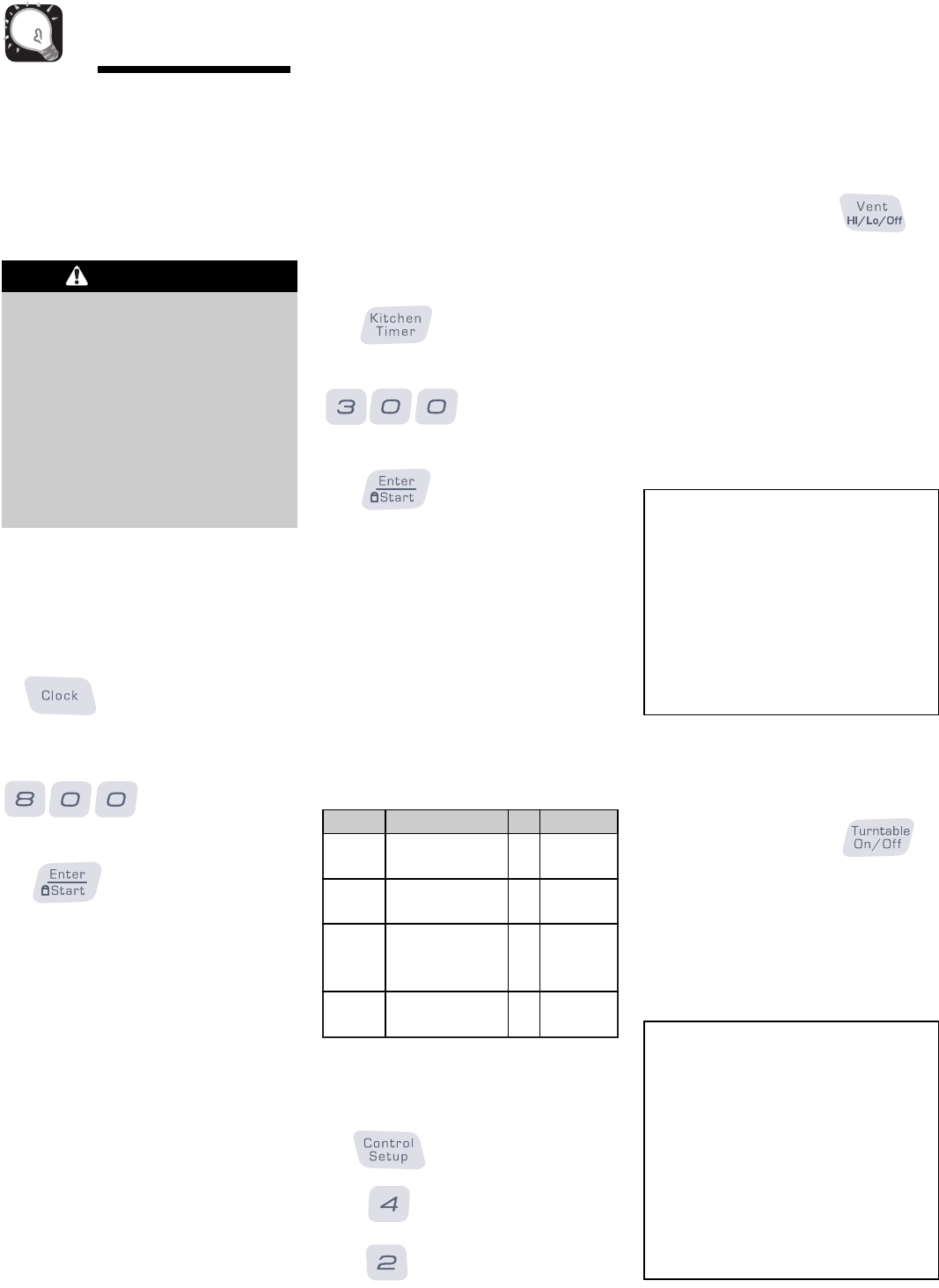
33
LE FOUR À
MICRO-ONDES
On décrit dans cette section les principes
de fonctionnement du four à micro-ondes
et les connaissances de base qui
devront permettre de l’utiliser. Lire cette
information avant d’utiliser le four.
CLOCK (HORLOGE)
L’appareil est doté d’une horloge (format
12 heures).
Exemple : Pour régler l’horloge pour
8 h 00.
1. Appuyer sur la
touche CLOCK
(appuyer 1 fois
pour AM/matin;
appuyer 2 fois
pour PM/soir).
2. Entrer l’heure
exacte à l’aide des
touches
numériques.
3.
Appuyer sur la touche
ENTER/START.
KITCHEN TIMER
(MINUTERIE)
On peut utiliser l’horloge du four à micro-
ondes comme minuterie, pour décompter
une période qui peut atteindre 99 minutes,
99 secondes.
Exemple : Réglage pour une période
de décompte de 3 minutes.
1. Appuyer sur la
touche KITCHEN
TIMER.
2. Entrer la durée de
décompte à l’aide
des touches
numériques.
3. Appuyer sur
ENTER /START.
Lorsque la
période de
décompte est
écoulée, l’appareil
émet des signaux
sonores et affiche
END (FIN).
CONTROL SETUP
(SÉLECTION DES
PARAMÈTRES)
Il est possible de modifier les paramètres
utilisés par le four pour signaux sonores,
horloge, vitesse d’affichage et poids de
décongélation.
Voir le tableau qui suit.
Exemple : Pour permuter le mode de
sélection du poids pour la
décongélation (entre lb et kg).
1. Appuyer sur la
touche
CONTROL
SETUP.
2. Appuyer sur la
touche 4.
3. Appuyer sur la
touche 2.
VENT HI/LO/OFF
(VENTILATEUR –
HAUT/BAS/ARRÊT)
Le ventilateur permet
d’évacuer la vapeur
d’eau et d’autres vapeurs
émises par les aliments sur la table de
cuisson. Le ventilateur fonctionne à la
vitesse basse chaque fois que le four
fonctionne.
Pour commander manuellement le
fonctionnement du ventilateur : appuyer
une fois sur la touche VENT pour
sélectionner la haute vitesse; appuyer
une seconde fois sur la touche pour
sélectionner la basse vitesse; appuyer
une troisième fois sur la touche pour
commander l'arrêt du ventilateur.
TURNTABLE ON/OFF
(PLATEAU TOURNANT –
MARCHE/ARRÊT)
Pour obtenir les meilleurs
résultats de cuisson,
laisser le plateau
tournant fonctionner en permanence. On
peut commander l’arrêt du plateau
tournant pour la cuisson d’une grande
quantité d’aliments.
Appuyer sur la touche TURNTABLE
ON/OFF pour commander la mise en
marche ou l’arrêt du plateau tournant.
Utilisation
• Pour éviter tout risque de dommages
matériels ou corporels, ne pas faire
fonctionner le four sans avoir placé un
aliment dans la cavité.
• Pour éviter tout risque de dommages
matériels ou corporels, ne pas placer
dans le four des articles comme les
suivants : vaisselle ou ustensile en
grès, feuille d’aluminium, ustensile
métallique ou ustensile avec garniture
métallique.
Touche Fonction
1 Signal sonore- 1 ACTIF
ACTIF/INACTIF 2 INACTIF
2 Affichage de 1 ACTIF
l’horloge 2 INACTIF
4 Poids pour 1 lb
décongélation 2 kg
3 Vitesse de 1 Basse
défilement de 2 Normale
l'afficheur 3 Haute
N° Résultat
REMARQUE :
• Si la température augmente
excessivement autour du four à
micro-ondes, le ventilateur de la hotte
d’extraction se met en marche
automatiquement (à vitesse HAUTE)
pour le refroidissement du four. Le
ventilateur peut ainsi fonctionner
pendant une période d’une heure.
Lorsque ceci se produit, on ne peut
commander l’arrêt du ventilateur.
REMARQUES :
• Cette option n’est pas disponible pour
les modes de décongélation et de
cuisson avec capteur.
• Le plateau tournant peut parfois
s’échauffer considérablement. On
doit être prudent s’il est nécessaire de
toucher le plateau tournant durant ou
après la cuisson.
• Ne pas faire fonctionner le four
sans y avoir placé des aliments.
ATTENTION
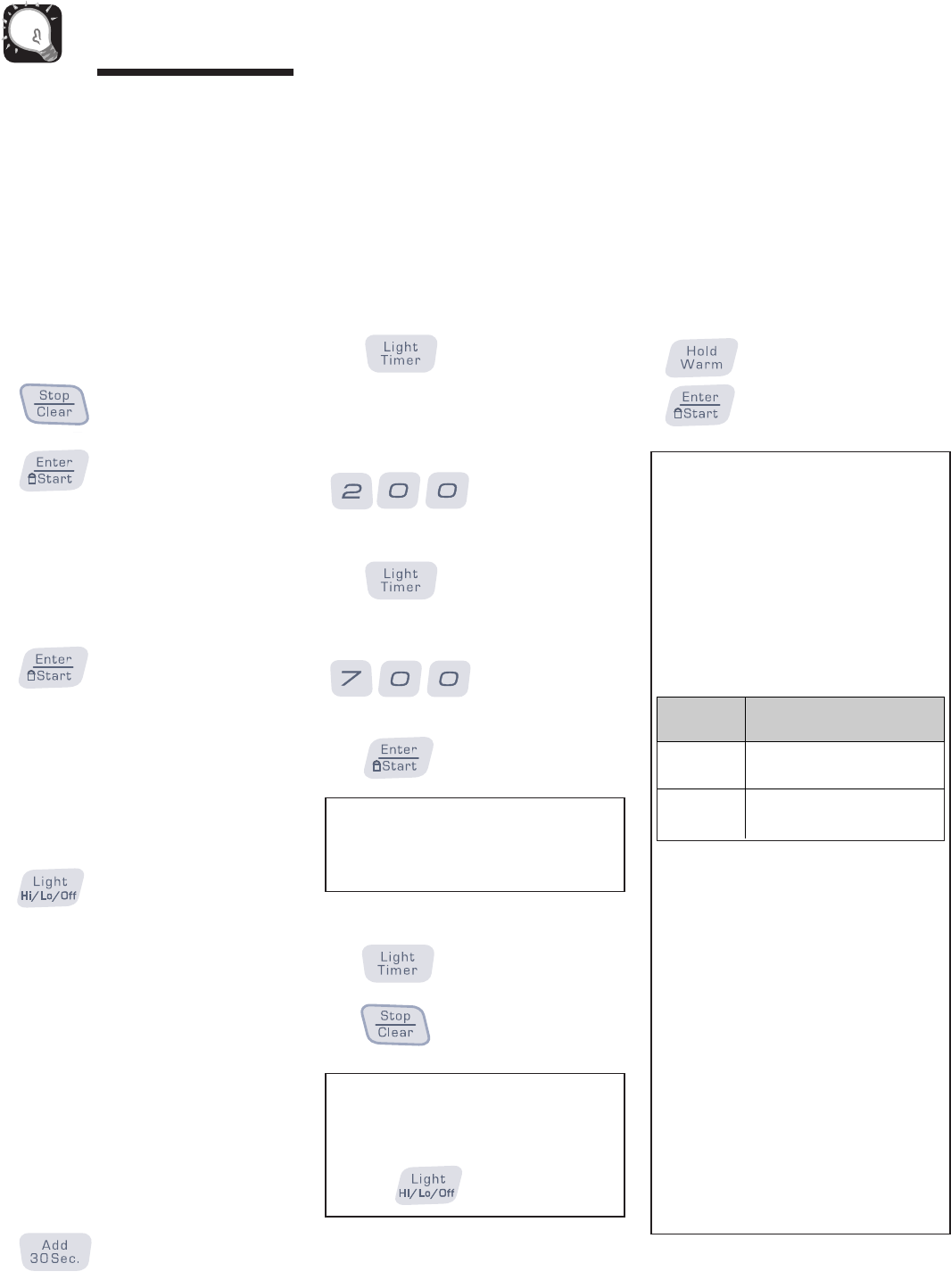
HOLD WARM (MAINTIEN
AU CHAUD)
Il est possible de maintenir au chaud un
mets cuit dans le four, pendant une
période qui peut atteindre 99 minutes,
99 secondes. On peut utiliser la fonction
de MAINTIEN AU CHAUD indépen-
damment, ou automatiquement après
l’exécution d’un programme de cuisson.
Exemple : Utilisation de la fonction de
MAINTIEN AU CHAUD.
1. Appuyer sur la touche
HOLD WARM.
2. Appuyer sur la touche
ENTER/START.
LIGHT TIMER (MINUTERIE
D'ÉCLAIRAGE)
On peut programmer l’appareil pour que
la LAMPE s’allume et s’éteigne
automatiquement à l’heure choisie. La
lampe s’allumera ensuite à la même
heure chaque jour, jusqu’à une
modification de la programmation.
Exemple : Allumage à 2 h 00, extinction
à 7 h 00.
1. Appuyer sur la
touche LIGHT
TIMER (appuyer
1 fois pour
AM/matin;
appuyer 2 fois
pour PM/soir).
2. Entrer l’heure
d’ALLUMAGE
désirée.
3. Appuyer de
nouveau sur la
touche LIGHT
TIMER (appuyer
1 fois pour
AM/matin;
appuyer 2 fois
pour PM/soir).
4. Entrer l’heure
D'EXTINCTION
désirée.
5. Appuyer sur la
touche
ENTER/START.
Exemple : Désactivation de la
minuterie d'éclairage.
1. Appuyer sur la
touche LIGHT
TIMER.
2. Appuyer sur
STOP/CLEAR.
34
Utilisation
VERROUILLAGE POUR
ENFANTS
Il est possible de désactiver le tableau de
commande pour empêcher la mise en
marche du four à micro-ondes,
accidentellement ou par des enfants.
La fonction de verrouillage est également
utile lorsqu’on doit nettoyer le tableau de
commande; ceci empêche l’entrée
accidentelle de commandes durant le
nettoyage.
Exemple : Verrouillage du tableau de
commande.
1. Appuyer sur la touche
STOP/CLEAR.
2. Maintenir la pression sur
ENTER/START pendant
4secondes ou plus.
LOCKED
(VERROUILLÉ)
apparaît sur l’afficheur et
l’appareil émet
2 signaux sonores.
Exemple : Déverrouillage du tableau de
commande.
1. Maintenir la pression sur
ENTER/START
pendant 4secondes ou
plus. LOCKED
(VERROUILLÉ)
disparaît et l’appareil
émet 2 signaux sonores.
LIGHT HI/LO/OFF (LAMPE
– JOUR/NUIT/ARRÊT)
Appuyer une fois sur la touche LIGHT
HI/LO/OFF pour
commander l’allumage
avec l’intensité maximale;
appuyer une seconde fois
sur la touche pour passer à l’intensité
d’illumination nocturne; appuyer une
troisième fois pour commander
l’extinction.
ADD 30 SEC. (ADDITION
30 SECONDES)
Cette touche de commande rapide
permet de commander la mise en marche
du four à micro-ondes sans qu’il soit
nécessaire d’appuyer sur la touche
ENTER/START.
Exemple : Sélection d’une période de
chauffage de 2 minutes.
1. Appuyer 4 fois sur la
touche ADD 30 SEC. Le
four se met en marche
et affiche le décompte
de la durée de cuisson.
REMARQUE :
• Pour modifier la programmation de la
minuterie d’ÉCLAIRAGE, répéter les
étapes 1 à 5.
REMARQUES:
• La durée de MAINTIEN AU CHAUD
peut atteindre 99 minutes, 99 secondes.
• Durant cette période, maintenir couvert
un mets qui a été cuit couvert.
• Ne pas couvrir un article de pâtisserie
(tarte, chausson, etc.) durant son
MAINTIEN AU CHAUD.
• Un repas complet qu’on maintient au
chaud sur une assiette peut être
couvert durant cette période.
Pour activer automatiquement la
fonction de MAINTIEN AU CHAUD
après un autre programme de
cuisson :
• Durant la programmation des
instructions de cuisson, appuyer sur la
touche HOLD WARM avant d’appuyer
sur la touche ENTER/START.
• Après l’exécution de la dernière
opération du programme de cuisson,
l’appareil émet 2 signaux sonores, et
HOLD WARM apparaît sur l’afficheur.
• On peut commander une durée de
MAINTIEN AU CHAUD après une
période de DÉCONGÉLATION
AUTOMATIQUE ou après un
programme de cuisson en plusieurs
phases.
REMARQUE :
• Pour désactiver la MINUTERIE
D'ÉCLAIRAGE alors qu’elle est
programmée, appuyer sur la
touche .
Type Quantité
d’aliment recommandée
Liquide 1 à 2 tasses
(237 à 473 mL)
Sec 5 à 10 oz
(148 mL à 296 mL)

CUSTOM PROGRAM
(PROGRAMME
PERSONNALISÉ)
La touche CUSTOM PROGRAM permet
de déclencher immédiatement un
programme de cuisson dont les
instructions ont été antérieurement
programmées et mémorisées.
Exemple : Période de cuisson de
2 minutes.
1. Appuyer sur la
touche CUSTOM
PROGRAM.
2. Entrer une durée
de cuisson.
3. Appuyer sur la
touche
ENTER/START.
Exemple : Rappel du programme
PROGRAMME PERSONNALISÉ).
1. Appuyer sur la
touche CUSTOM
PROGRAM.
2. Appuyer sur
ENTER/START.
Lorsque la durée
de cuisson est
écoulée, l’appareil
émet 4 signaux
sonores et affiche
END (FIN).
MORE+/LESS-
(PLUS+/MOINS-)
Les touches MORE+ et LESS-
permettent de modifier la durée de
cuisson pour une opération de cuisson
préprogrammée ou pour une période de
cuisson minutée.
1. Chaque pression
sur la touche
MORE+ ajoute
10 secondes à la
durée de cuisson.
2. Chaque pression
sur la touche
LESS- réduit la
durée de cuisson
de 10 secondes.
CUISSON AUX NIVEAUX
DE PUISSANCE ÉLEVÉS
Exemple : Période de cuisson de
8 minutes 30 secondes au niveau de
puissance 100 %.
1. Entrer la durée de
cuisson.
2. Appuyer sur
ENTER/START.
Lorsque la durée
de cuisson est
écoulée, l’appareil
émet 4 signaux
sonores et affiche
END (FIN).
CUISSON AUX NIVEAUX
DE PUISSANCE
INFÉRIEURS
L’emploi de la puissance de chauffage
HIGH (ÉLEVÉE) ne produit pas toujours
les meilleurs résultats avec les aliments
qui nécessitent une cuisson lente,
comme rôti, mets à cuire au four ou
entremets. En plus de la puissance
ÉLEVÉE, le four offre un choix de
10 niveaux de puissance de chauffage.
Exemple : Période de cuisson de
7 minutes 30 secondes, au niveau de
puissance 70 %.
1. Entrer la durée de
cuisson.
2. Appuyer sur la
touche POWER
LEVEL .
3. Entrer le niveau
de puissance.
4. Appuyer sur
ENTER/START.
Lorsque la durée
de cuisson est
écoulée, l’appareil
émet 4 signaux
sonores et affiche
END (FIN).
Pour le choix des niveaux de puissance,
voir le guide de cuisson à la page 36.
PROGRAMME DE
CUISSON À PLUSIEURS
PHASES
Pour l’obtention des meilleurs résultats,
certaines recettes stipulent l’emploi d’un
niveau de puissance de chauffage
pendant une certaine période, puis d’un
autre niveau de puissance de chauffage
durant une autre période. On peut
programmer le four pour qu’il exécute
successivement jusqu’à trois périodes de
chauffage si la première période est une
opération de décongélation.
Exemple : Cuisson d’un mets pendant
3 minutes au niveau de puissance
100 %, puis durant 7 minutes
30 secondes au niveau de puissance
70 %.
1. Entrer la durée de
cuisson pour la
première période.
2. Appuyer sur la
touche COOK
TIME.
3. Entrer la durée de
cuisson pour la
seconde période.
4. Appuyer sur la
touche POWER
LEVEL.
5. Entrer le niveau de
puissance pour la
seconde période.
6. Appuyer sur
ENTER/ START.
Lorsque la durée
de cuisson est
écoulée, l’appareil
émet 4 signaux
sonores et affiche
END (FIN).
35
Utilisation
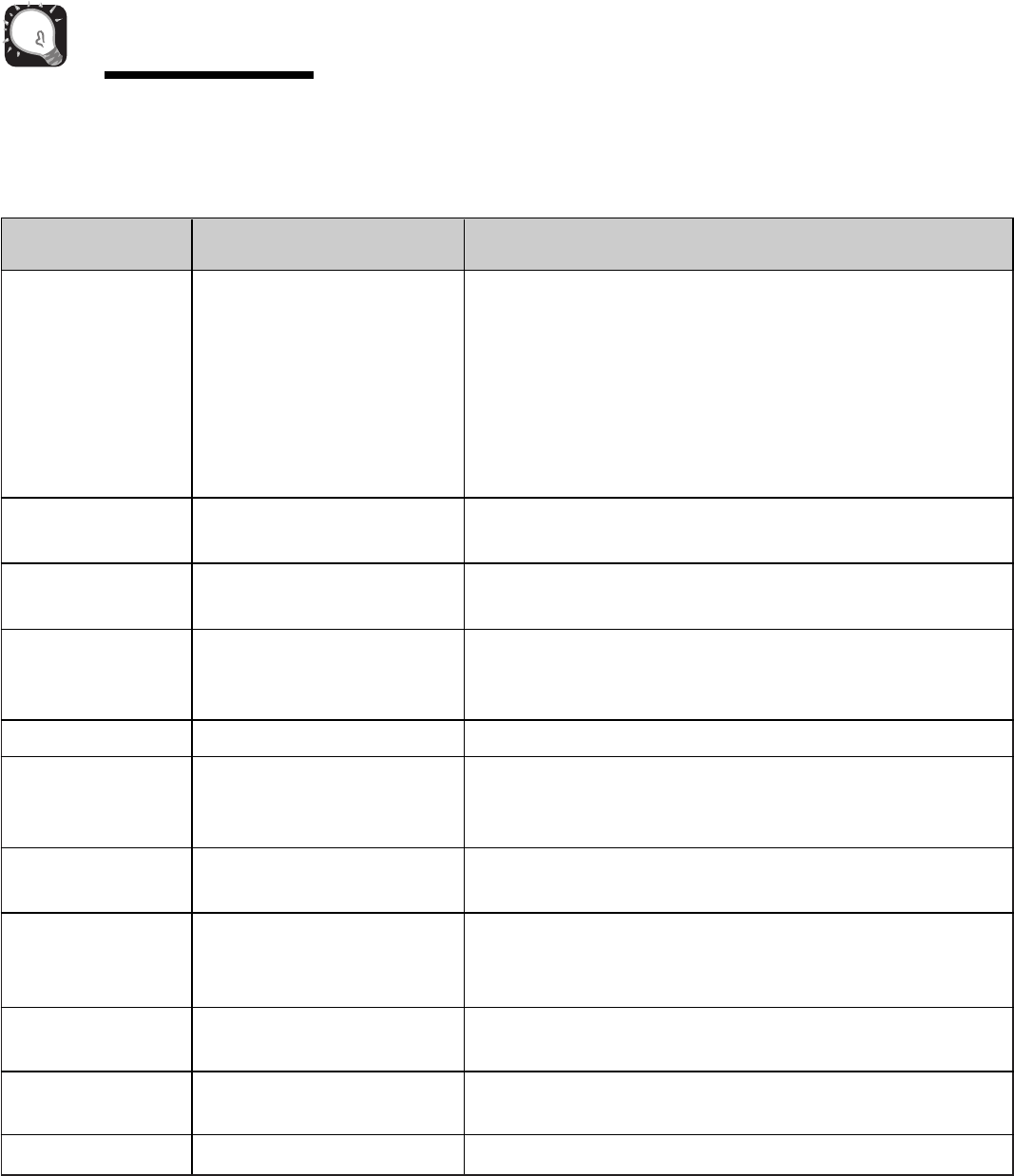
36
Utilisation
10 100 % • Ébullition d’eau.
(Puissance élevée) • Cuisson de bœuf haché.
• Préparation de bonbons/confiserie.
• Cuisson de légumes et fruits frais.
• Cuisson de poisson ou volaille.
• Préchauffage d’un plat de brunissage.
• Réchauffage de liquide.
• Tranches de bacon. Placer l'ustensile sur la grille métallique du four.
9 90 % • Réchauffage rapide de tranches de viande.
• Cuisson d’oignons, de céleri et poivrons verts (sautés).
8 80 % • Réchauffage.
• Cuisson d’œufs brouillés.
7 70 % • Cuisson de pains et de produits de céréales.
• Cuisson de mets à base de fromage, veau.
• Cuisson de gâteaux, muffins, biscuits, etc.
6 60 % • Cuisson de pâtes.
5 50 % • Cuisson de viande, volaille entière.
• Cuisson d’entremets.
• Cuisson de poulet entier, dinde, côtes de porc, rôti de côtes, rôti de longe.
4 40 % • Toute cuisson de pièces de viande moins tendres.
• Réchauffage de mets préparé surgelé.
3 30 % • Décongélation de viande, volaille et produits de la mer.
• Cuisson d’une petite quantité d’aliments.
• Fin de cuisson pour mets en sauce, ragoûts et certaines sauces.
2 20 % • Amollissement de beurre et fromage à la crème.
• Chauffage d’une petite quantité d’aliments.
1 10 % • Amollissement de crème glacée.
• Levée de pâte à pain (avec levure).
0 • Période d’attente.
GUIDE DE CUISSON – NIVEAUX DE PUISSANCE INFÉRIEURS
L’appareil offre un choix de 10 niveaux de puissance de chauffage en plus de la puissance HIGH (ÉLEVÉE); on peut ainsi choisir le
niveau de puissance le plus approprié pour l’aliment à cuire. Le tableau ci-dessous permet de choisir le niveau de puissance
approprié pour divers aliments.
NIVEAU DE PUISSANCE
PUISSANCE DU FOUR UTILISATION
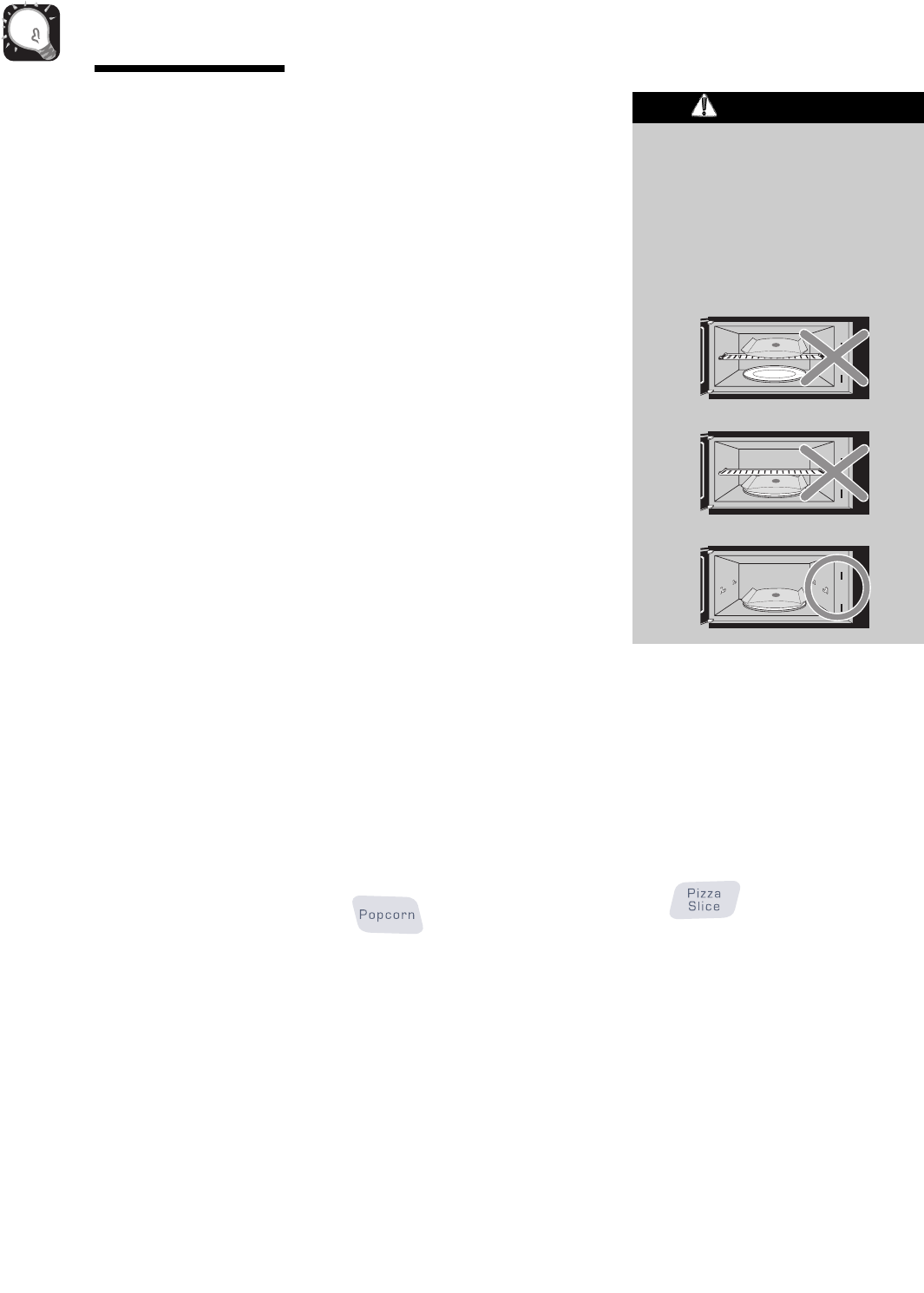
PIZZA SLICE
(PART DE PIZZA)
Cette fonction permet de réchauffer une
ou plusieurs parts de pizza sans devoir
d’abord sélectionner une durée de
cuisson et une puissance de chauffage.
Exemple : Réchauffage de 2 parts de
pizza.
1. Appuyer sur la
touche PIZZA
SLICE. Lorsque la
durée de
chauffage est
écoulée, l’appareil
émet 4 signaux
sonores et affiche
END (FIN).
• Quantité recommandée : 1 à 3 parts
(environ 3 à 5 oz /85 à 142 g par part).
3. Adapter la quantité de nourriture à la
taille du récipient. Pour obtenir les
meilleurs résultats, remplir un récipient
à 50 % ou plus.
4. Avant de placer les aliments dans le
four, vérifier que les surfaces internes
du four et les surfaces externes du
récipient sont sèches. La transfor-
mation en vapeur des résidus d’eau
peut provoquer une détection
incorrecte par le capteur.
AUGMENTATION/
DIMINUTION DE LA
DURÉE DE CUISSON
Avec les touches MORE+ ou LESS-,
tous les réglages pour une cuisson
minutée et pour une cuisson avec
capteur peuvent être modifiés pour
donner une durée plus longue ou plus
courte. En appuyant sur la touche
MORE+, on ajoute 10 secondes de
durée de cuisson à chaque pression. En
appuyant sur LESS-, on soustrait
10 secondes de durée de cuisson à
chaque pression.
POPCORN
(MAÏS À ÉCLATER)
La fonction POPCORN permet de faire
éclater au four à micro-ondes les grains
de maïs des sachets commerciaux.
Exécuter le processus sur un seul sachet
à la fois. Pour les meilleurs résultats,
utiliser des sachets de maïs à éclater
frais.
Exemple : Préparation de maïs à
éclater.
1. Appuyer sur la
touche
POPCORN.
Lorsque la durée
de chauffage est
écoulée, l’appareil
émet 4 signaux
sonores et affiche
END (FIN).
• Quantité recommandée : 3 à 3,5 oz
(85 à 99 g).
INSTRUCTIONS DE
CUISSON AVEC CAPTEUR
La cuisson avec capteur permet de
commander la cuisson d'un mets favori
sans devoir sélectionner une durée de
cuisson et une puissance de chauffage.
L’appareil affiche SENSING (CAPTEUR)
durant la période de détection initiale. Le
four à micro-ondes détermine
automatiquement la durée de cuisson
nécessaire pour chaque mets ou aliment.
Lorsque le capteur interne détecte une
certaine quantité d’humidité émise par
l’aliment, il détermine la durée de cuisson
restante; l’afficheur présente alors la
durée de cuisson restante. Observer la
recommandation suivante pour obtenir
les meilleurs résultats pour une cuisson
avec capteur :
1. Entreprendre la cuisson sur des
aliments qui se trouvent à une
température de conservation normale.
2. Veiller à ce que le plateau tournant en
verre et la surface extérieure du
récipient soient secs.
3. Recouvrir les aliments avec un
couvercle, du papier paraffiné ou une
feuille de plastique (pour four à micro-
ondes).
4. Ne pas ouvrir la porte du four ni
appuyer sur la touche STOP/CLEAR
durant la période de détection.
Lorsque la période de détection est
écoulée, le four émet deux signaux
sonores, et la durée de cuisson
restante apparaît sur l’afficheur. À
partir de ce moment, on peut ouvrir la
porte du four pour remuer ou retourner
les aliments ou pour modifier leur
répartition.
GUIDE DE CUISSON
AVEC CAPTEUR
Pour obtenir les meilleurs résultats lors
d’une cuisson avec capteur, employer
les récipients appropriés et recouvrir les
aliments.
1. Toujours utiliser un récipient pour four
à micro-ondes et recouvrir avec un
couvercle ou une feuille de plastique
(laisser un évent).
2. Ne jamais placer un couvercle ou film
de plastique étanche sur un récipient;
ceci empêche l’évacuation de la
vapeur et peut provoquer une cuisson
excessive.
37
Utilisation
NE PAS laisser le four à micro-
ondes sans surveillance durant une
opération d’éclatement de maïs.
Lors de l'éclatement de maïs en
sachet vendu dans le commerce,
retirer la grille du four; ne pas
placer le sachet de maïs à éclater
sur ou sous la grille.
ATTENTION
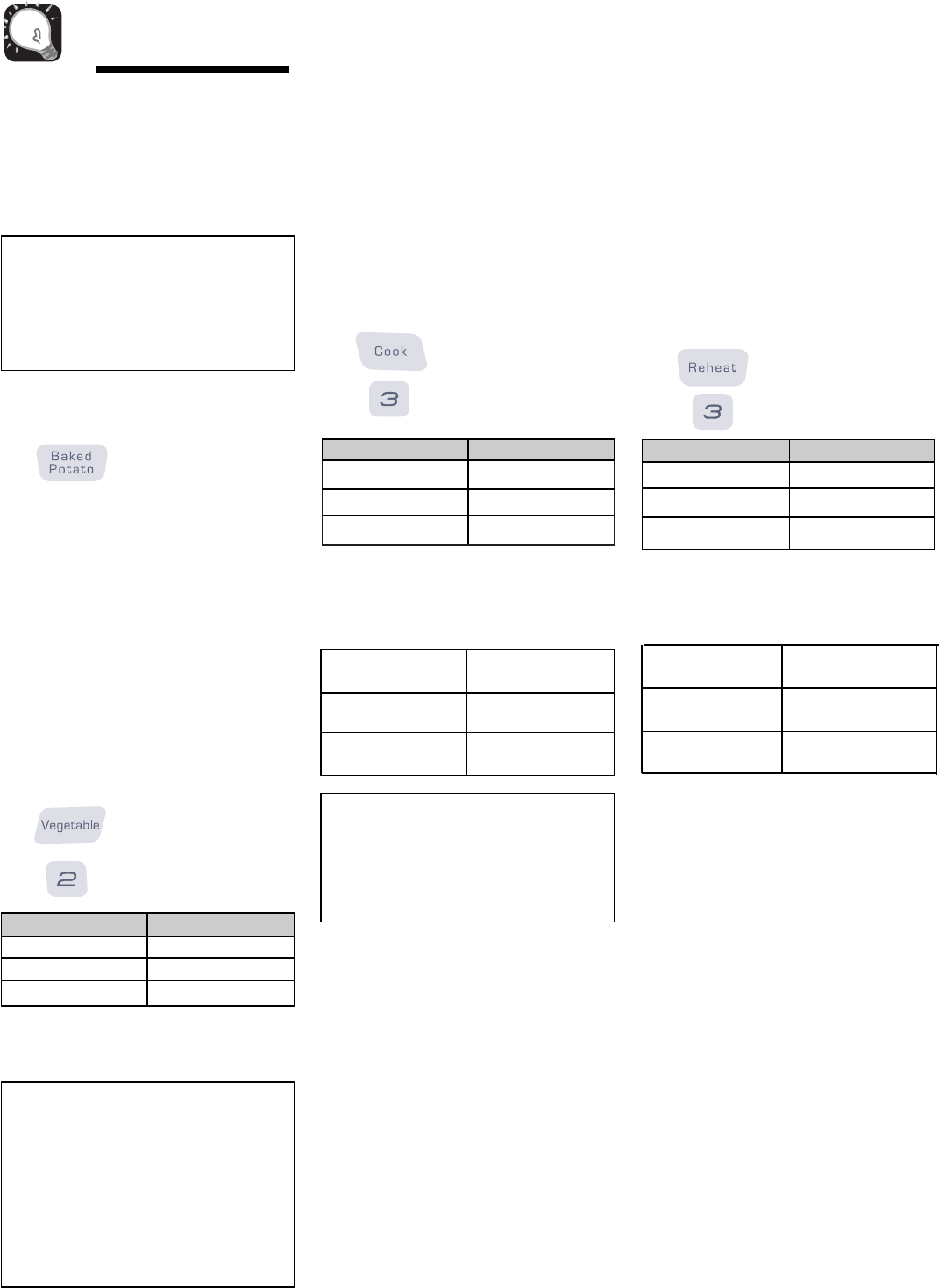
REHEAT (RÉCHAUFFAGE)
La touche REHEAT permet de
commander le chauffage d’un aliment
sans devoir d’abord sélectionner la durée
de chauffage et la puissance de
chauffage. Cette fonction est associée à
des puissances de chauffage
présélectionnées pour 3 catégories
d’aliment : mets en sauce, assiette de
dîner et soupe/sauce.
Exemple : Réchauffage d’un mets en
sauce.
1. Appuyer sur la
touche REHEAT.
2. Choisir la catégorie
d’aliment.
Lorsque la durée de chauffage est
écoulée, l’appareil émet 4 signaux
sonores et affiche END (FIN).
Quantités recommandées
COOK (CUISSON)
Cette fonction permet de commander
une cuisson aux micro-ondes sans
devoir sélectionner d’abord la durée de
cuisson et la puissance de chauffage.
Elle est associée à des puissances de
chauffage présélectionnées pour
3 catégories d’aliment : mets surgelé,
mets en sauce et riz.
Exemple : Cuisson de riz.
1. Appuyer sur la
touche COOK.
2. Choisir la
catégorie
d’aliment.
Lorsque la durée de chauffage est
écoulée, l’appareil émet 4 signaux
sonores et affiche END (FIN).
Quantités recommandées
38
Utilisation
BAKED POTATO (POMME
DE TERRE AU FOUR)
Cette fonction permet de faire cuire une
ou plusieurs pommes de terre sans
devoir sélectionner d’abord la durée de
cuisson et la puissance de chauffage.
Exemple : Cuisson de 2 pommes de
terre. 1. Appuyer sur la
touche BAKED
POTATO.
Lorsque la durée
de chauffage est
écoulée, l’appareil
émet 4 signaux
sonores et affiche
END (FIN).
• Quantité recommandée : 1 à 4 pommes
de terre (environ 9 à 11 oz (255 à
312 g) par pomme de terre).
VEGETABLE (LÉGUMES)
Cette fonction comporte des préréglages
de puissance pour 3 catégories
d’aliment : frais, surgelés et conserves.
Exemple : Cuisson de légumes
surgelés.
1. Appuyer sur la
touche
VEGETABLE.
2. Choisir la
catégorie
d’aliment.
Lorsque la durée de chauffage est
écoulée, l’appareil émet 4 signaux
sonores et affiche END (FIN).
Catégorie Touche
Mets surgelé
Mets en sauce
Riz
1
2
3
Catégorie Touche
Assiette de dîner
Soupe/sauce
Mets en sauce
1
2
3
Assiette de dîner
Soupe/sauce
Mets en sauce
1 à 2 portions
1 à 4 tasses
(237 à 946 mL)
1 à 4 tasses
(237 à 946 mL)
REMARQUES :
• Avant la cuisson, perforer plusieurs
fois la peau des pommes de terre
avec une fourchette.
• Après la cuisson, ajouter une période
d’attente de 5 minutes.
REMARQUE :
• Utiliser uniquement du riz à grains
longs pour une cuisson avec capteur;
pour les autres types de riz, voir
page 46.
REMARQUES :
• Placer le contenu d’une boîte de
légumes dans un récipient pour four à
micro-ondes. Recouvrir avec une
feuille de plastique et laisser un évent.
Ajouter une période d’attente de
5 minutes.
- Quantité recommandée : 1 à 4 tasses
(237 à 946 mL).
- Laisser un évent de 1/4 à 1/2 po
(0,6 à 1,3 cm) sous le couvercle.
Catégorie Touche
Frais
Surgelés
Conserves
1
2
3
Mets surgelé
Mets en sauce
Riz
10 à 21 oz
(284 à 595 g)
1 à 4 tasses
(237 à 946 mL)
1/2 à 2 tasses
(118 à 473 mL)
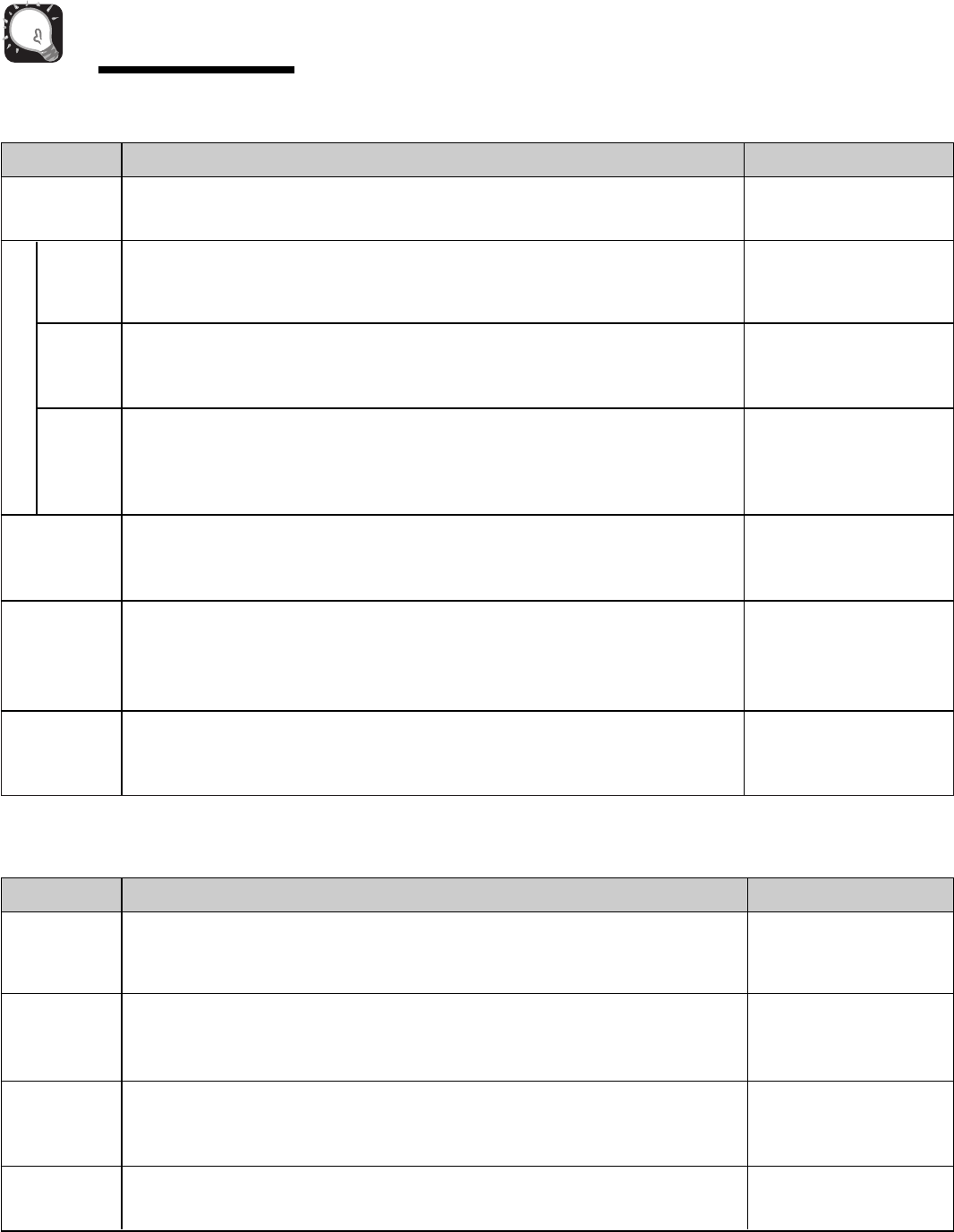
CATÉGORIE DIRECTIVES QUANTITÉ
Percer chaque pomme de terre à l'aide d'une fourchette et les placer sur le pourtour
du plateau, en les espaçant d'au moins 1 pouce (2,5 cm).
Les préparer comme on le désire, les laver et laisser un peu d'eau sur les légumes.
Les placer dans un récipient pour four à micro-ondes de dimensions appropriées et
recouvert d'une pellicule plastique, avec évent.
Les retirer du paquet, les rincer sous l'eau courante pour éliminer le givre. Les
placer dans un récipient pour four à micro-ondes de dimensions appropriées et
recouvert d'une pellicule plastique, avec évent.
Les retirer de leur boîte.
Les placer dans un récipient pour four à micro-ondes de dimensions appropriées et
recouvert d'une pellicule plastique, avec évent.
Après la cuisson, remuer le contenu et laisser reposer 3 minutes.
Réunir les ingrédients selon la recette, dans un plat de 1 à 2 pintes (1 à 2 L).
Faire cuire en mettant une pellicule plastique avec évent.
Après la cuisson, remuer le contenu et laisser reposer 3 minutes.
Ajouter deux fois la quantité d'eau au riz.
Choisir un récipient pour four à micro-ondes suffisamment grand pour empêcher
l'eau de déborder à l'ébullition. Recouvrir le récipient d'une pellicule plastique ou
d'un couvercle.
Le retirer de l'emballage. Faire une fente dans le couvercle. Si le récipient n'est pas
prévu pour four à micro-ondes, placer le contenu sur une assiette recouverte d'une
pellicule plastique, avec évent.
1 à 4, moyennes, approx.
8 à 10 oz (227 à 284 g)
chacune
1 à 4 tasses
(237 à 946 mL)
1 à 4 tasses
(237 à 946 mL)
1 à 4 tasses
(237 à 946 mL)
1 à 4 tasses
(237 à 946 mL)
1/2 à 2 tasses
(118 à 473 mL)
10 à 21 oz
(284 à 595 g)
Pommes
de terre
Mets en sauce
Riz
Mets surgelé
Légumes
frais
Légumes
surgelés
Légumes
en
conserve
LÉGUMES
39
Utilisation
TABLEAU DE CUISSON AVEC CAPTEUR
TABLEAU DE RÉCHAUFFFAGE AVEC CAPTEUR
CATÉGORIE DIRECTIVES QUANTITÉ
Ceci est une fonction de réchauffage pour un reste de pizza.
Placer la pizza sur du papier essuie-tout, sur une assiette compatible avec les
micro-ondes.
La placer sur une assiette peu profonde, recouverte d'une pellicule plastique, avec
évent.
Laisser reposer 3 minutes.
Placer dans un plat pour four à micro-ondes peu profond, recouvert d'une pellicule
plastique avec évent.
Après la cuisson, remuer le contenu et laisser reposer 3 minutes.
Couvrir le plat contenant le mets avec une pellicule plastique, avec évent.
Après la cuisson, remuer le contenu et laisser reposer 3 minutes.
1 à 3 parts (3 à 5 oz/
85 à 142 g chacune)
1 à 2 portions
1 à 4 tasses
(237 à 946 mL)
1 à 4 tasses
(237 à 946 mL)
Pizza
Assiette de
dîner
Soupe/sauce
Mets en sauce
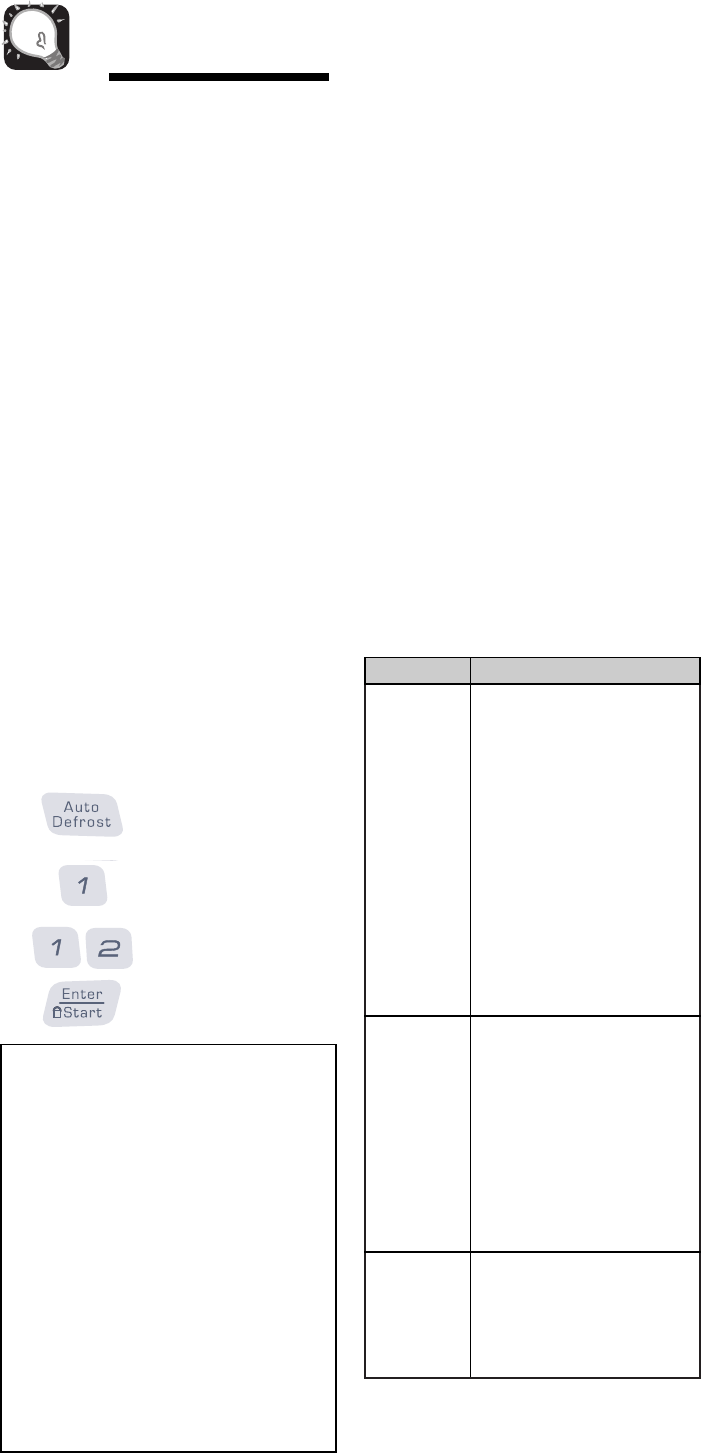
40
Utilisation
CONSEILS POUR LA
DÉCONGÉLATION
• Pour l’utilisation de la fonction de
DÉCONGÉLATION AUTOMATIQUE,
on doit entrer le poids net de l’aliment
en livres et dixièmes de livres (le poids
du récipient plein moins le poids du
récipient vide).
• Utiliser la DÉCONGÉLATION
AUTOMATIQUE uniquement pour un
aliment cru. Elle produit les meilleurs
résultats lorsque l’aliment à décongeler
sort du congélateur (température de
0 °F/-18 °C). Si l’aliment a été conservé
dans le compartiment de congélation
d’un réfrigérateur, qui ne maintient pas
une température de 5 °F (-15 °C) ou
moins, on doit toujours programmer un
poids inférieur (correspondant à une
durée de décongélation plus courte)
pour éviter une cuisson partielle de
l’aliment.
• Si l’aliment a été conservé hors du
congélateur pendant quelque temps
(jusqu’à 20 minutes), entrer un poids
inférieur.
• La forme du paquet a une influence sur
la durée de décongélation. Un paquet
peu épais se décongèle plus
rapidement qu’un bloc épais.
• Séparer les morceaux après le début
de la décongélation. Les morceaux
séparés décongèlent plus facilement.
• On peut utiliser de petits morceaux de
feuille d’aluminium pour protéger
certaines parties d’un aliment (ailes et
extrémité des pattes de poulet, queue
de poisson) mais on doit veiller à ce
qu’aucun morceau d’aluminium n’entre
en contact avec une paroi du four; ceci
pourrait provoquer la formation
d’arcs/étincelles qui détérioreraient la
surface interne du four.
• Protéger avec des morceaux de feuille
d’aluminium les parties d’un aliment ou
mets qui s’échauffent plus rapidement.
• Pour la production des meilleurs
résultats, la durée de décongélation
sélectionnée par le four inclut une
période d’attente prédéfinie.
• Pour l’obtention des meilleurs résultats,
placer un aliment à décongeler sur une
grille de rôtissage aux micro-ondes;
ceci évitera que les jus de viande
chauffés durant la décongélation ne
provoquent une cuisson partielle de
l’aliment.
AUTO DEFROST
(DÉCONGÉLATION
AUTOMATIQUE)
Trois choix de décongélation sont
présélectionnés dans le four. La fonction
décongélation offre la meilleure méthode
de décongélation des aliments surgelés,
le four choisissant automatiquement les
durées nécessaires selon chaque
aliment, en fonction du poids entré. De
plus, la fonction de DÉCONGÉLATION
AUTOMATIQUE comprend un
mécanisme de signalisation incorporé
qui rappelle à l'utilisateur de vérifier, de
retourner, de séparer ou de redisposer la
nourriture pendant le cycle de
décongélation. Trois options sont
disponibles :
1. VIANDE
2. VOLAILLE
3. POISSON
Après avoir appuyé une fois sur le
bouton AUTO DEFROST, sélectionner la
catégorie d'aliment. Les gammes de
poids vont de 0,1 à 6,0 lb (45 g à 2,7 kg)
pour la viande, la volaille et le poisson.
Exemple : Décongélation de 1,2 lb
(0,5 kg) de viande.
1. Appuyer sur la
touche AUTO
DEFROST.
2. Choisir la
catégorie
d'aliment.
3. Entrer le poids.
4. Appuyer sur la
touche
ENTER/START.
Pour de meilleurs résultats :
• Retirer le poisson, les mollusques/
crustacés, la viande et la volaille de leur
emballage plastique ou papier fermé
d'origine. Sinon, l'emballage retient la
vapeur et les jus près de l'aliment, ce
qui peut entraîner la cuisson de la
surface extérieure de l'aliment.
• Façonner la viande en forme de
beignes avant de la congeler. Lors de la
décongélation, enlever la viande déjà
décongelée sur l'extérieur lorsque le
signal sonore retentit, et continuer la
décongélation.
• Placer l'aliment dans un plat de cuisson
en verre peu profond ou sur une grille
de rôtissage aux micro-ondes, afin de
récolter les jus.
• L'aliment comportera encore des
parties congelées au centre, lorsqu'il
sera retiré du four.
TABLEAU DE DÉCONGÉLATION
AUTOMATIQUE
Catégorie Aliment
VIANDE
0,1 à 6,0 lb
(45 g à
2,7 kg)
VOLAILLE
0,1 à 6,0 lb
(45 g à
2,7 kg)
POISSON
0,1 à 6,0 lb
(45 g à
2,7 kg)
BŒUF
Bœuf haché, steak de ronde,
cubes de viande à ragoût,
steak de filet, viande pour pot
au feu, rôti de côtes, rôti de
croupe roulé, rôti de palette,
steakette (hamburger).
AGNEAU
Côtelettes (1 po/2,5 cm
d'épaisseur), rôti roulé.
PORC
Côtelettes (1/2 po/1,25 cm),
hot dogs, côtes levées,
travers, rôti roulé, saucisses.
VOLAILLE
Poulet entier (moins de
4 lb/1,8 kg), viande de
poitrine coupée (sans os).
POULET DE
CORNOUAILLES
Entier.
DINDE
Poitrine
(moins de 6 lb/2,7 kg).
POISSON
Filets, darnes, entier
CRUSTACÉS/MOLLUSQUES
Chair de crabe, queues de
homard, crevettes, pétoncles.
REMARQUE :
• Après avoir appuyé sur la touche
ENTER/START, l'afficheur décompte
la durée de décongélation. Le four
émettra un signal sonore durant le
cycle de décongélation. À ce
moment, ouvrir la porte et tourner,
séparer ou redisposer l'aliment selon
le besoin. Retirer toutes les portions
qui ont décongelé, puis remettre les
portions encore congelées dans le
four et appuyer sur la touche
ENTER/START pour poursuivre le
cycle de décongélation.
• Le four ne s'arrêtera pas pendant
l'émission du signal sonore, à
moins que la porte ne soit ouverte.